Sony Group MEXBT3900 Bluetooth Audio System User Manual MEX BT39UW
Sony Corporation Bluetooth Audio System MEX BT39UW
Contents
- 1. User manual(MEX-BT39UW)
- 2. User manual(MEX-BT3900U)
User manual(MEX-BT39UW)
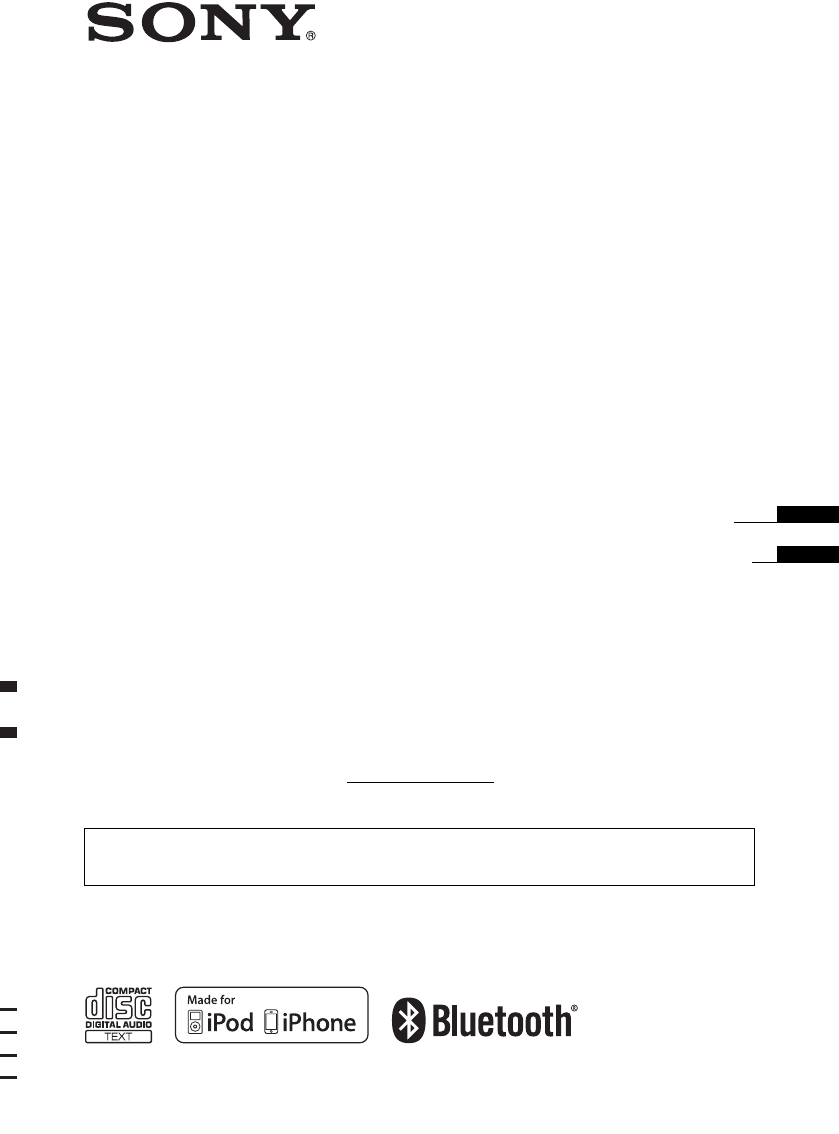
©2010 Sony Corporation
Operating Instructions
Manual de instrucciones
Owner’s Record
The model and serial numbers are located on the bottom of the unit.
Record the serial number in the space provided below.
Refer to these numbers whenever you call upon your Sony dealer regarding this product.
Model No. MEX-BT39UW Serial No.
To cancel the demonstration (DEMO) display, see page 7.
Para cancelar la pantalla de demostración (DEMO), consulte la página 7.
ES
US
4-199-772-41(1)
MEX-BT39UW
Bluetooth®
Audio System

2
Warning
Be sure to install this unit in the dashboard of
the car for safety. For installation and
connections, see the supplied installation/
connections manual.
This equipment has been tested and found to
comply with the limits for a Class B digital
device, pursuant to Part 15 of the FCC Rules.
These limits are designed to provide reasonable
protection against harmful interference in a
residential installation. This equipment
generates, uses, and can radiate radio frequency
energy and, if not installed and used in
accordance with the instructions, may cause
harmful interference to radio communications.
However, there is no guarantee that interference
will not occur in a particular installation. If this
equipment does cause harmful interference to
radio or television reception, which can be
determined by turning the equipment off and on,
the user is encouraged to try to correct the
interference by one or more of the following
measures:
–
Reorient or relocate the receiving antenna.
–
Increase the separation between the equipment
and receiver.
–
Connect the equipment into an outlet on a
circuit different from that to which the receiver
is connected.
–
Consult the dealer or an experienced radio/TV
technician for help.
You are cautioned that any changes or
modifications not expressly approved in this
manual could void your authority to operate this
equipment.
CAUTION
The use of optical instruments with this product
will increase eye hazard.
This equipment complies with FCC/IC radiation
exposure limits set forth for an uncontrolled
environment and meets the FCC radio frequency
(RF) Exposure Guidelines in Supplement C to
OET65 and RSS-102 of the IC radio frequency
(RF) Exposure rules. This equipment has very
low levels of RF energy that it deemed to
comply without maximum permissive exposure
evaluation (MPE). But it is desirable that it
should be installed and operated keeping the
radiator at least 20 cm or more away from
person’s body (excluding extremities: hands,
wrists, feet and ankles).
This transmitter must not be co-located or
operated in conjunction with any other antenna
or transmitter.
This device complies with Part 15 of the FCC
Rules and RSS-Gen of IC Rules. Operation is
subject to the following two conditions: (1) this
device may not cause harmful interference, and
(2) this device must accept any interference
received, including interference that may cause
undesired operation of the device.
For the State of California, USA only
Perchlorate Material – special handling may apply,
See www.dtsc.ca.gov/hazardouswaste/perchlorate
Perchlorate Material: Lithium battery contains
perchlorate
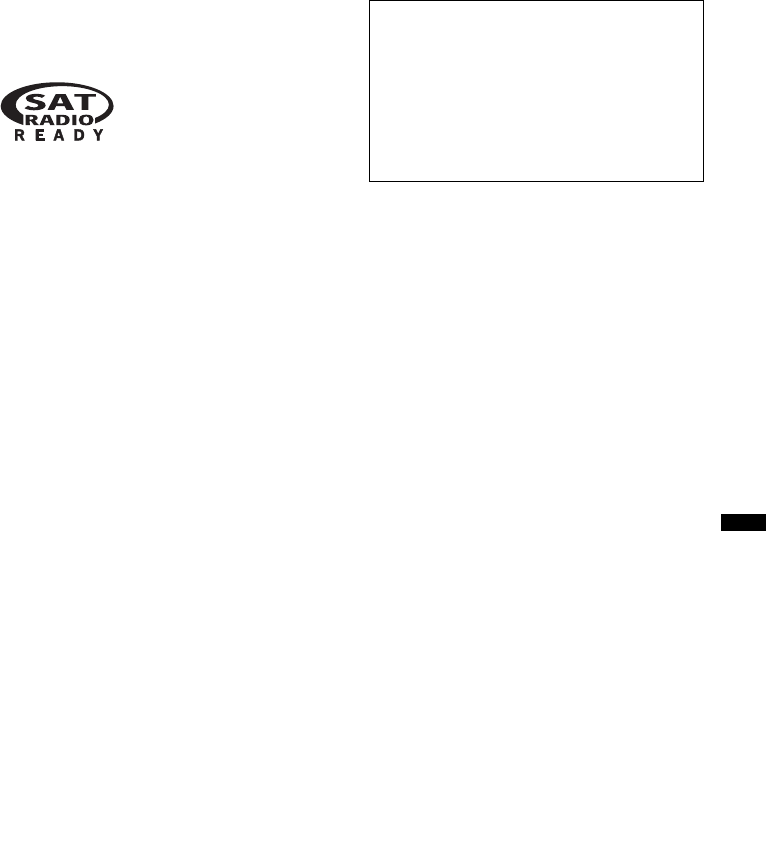
3
The Bluetooth word mark and logos are owned
by the Bluetooth SIG, Inc. and any use of such
marks by Sony Corporation is under license.
Other trademarks and trade names are those of
their respective owners.
ZAPPIN and Quick-BrowZer are trademarks of
Sony Corporation.
HD Radio
TM
is a proprietary trademark of
iBiquity Digital Corp.
The “SAT Radio Ready”
logo indicates that this
product will control a satellite
radio tuner module (sold
separately). Please see your nearest authorized
Sony dealer for details on the satellite radio
tuner module.
“SAT Radio,” “SAT Radio Ready,” the SAT
Radio and SAT Radio Ready logos and all
related marks are trademarks of Sirius XM
Radio Inc. and XM Satellite Radio Inc.
Windows Media is either a registered trademark
or trademark of Microsoft Corporation in the
United States and/or other countries.
This product is protected by certain intellectual
property rights of Microsoft Corporation. Use or
distribution of such technology outside of this
product is prohibited without a license from
Microsoft or an authorized Microsoft subsidiary.
iPhone, iPod, iPod classic, iPod nano, and
iPod touch are trademarks of Apple Inc.,
re
g
istered in the U.S. and other countries.
MPEG Layer-3 audio coding technology and
patents licensed from Fraunhofer IIS and Thomson.
Note on the lithium battery
Do not expose the battery to excessive heat such as
direct sunlight, fire or the like.
Warning if your car’s ignition has no
ACC position
Be sure to set the Auto Off function (page 29).
The unit will shut off completely and
automatically in the set time after the unit is
turned off, which prevents battery drain.
If you do not set the Auto Off function, press
and hold (SOURCE/OFF) until the display
disappears each time you turn the ignition off.

4
Table of Contents
Getting Started
Playable discs on this unit . . . . . . . . . . . . . . . . . 6
Notes on Bluetooth . . . . . . . . . . . . . . . . . . . . . . 6
Resetting the unit. . . . . . . . . . . . . . . . . . . . . . . . 6
Canceling the DEMO mode . . . . . . . . . . . . . . . 7
Preparing the card remote commander . . . . . . . 7
Setting the clock . . . . . . . . . . . . . . . . . . . . . . . . 7
Detaching the front panel . . . . . . . . . . . . . . . . . 7
Attaching the front panel . . . . . . . . . . . . . . . 7
Quick Guide for Bluetooth function
3 steps to Bluetooth function. . . . . . . . . . . . . . . 8
Buttons and icons . . . . . . . . . . . . . . . . . . . . . . . 9
1Pairing . . . . . . . . . . . . . . . . . . . . . . . . . . . . 10
2Connection . . . . . . . . . . . . . . . . . . . . . . . . . 10
3Handsfree calling and Music streaming. . . 11
Location of controls and basic
operations
Main unit. . . . . . . . . . . . . . . . . . . . . . . . . . . 12
RM-X172
Card Remote Commander . . . . . . . . . . . . . 14
Radio
Storing and receiving stations . . . . . . . . . . . . . 15
Storing automatically — BTM . . . . . . . . . . 15
Storing manually. . . . . . . . . . . . . . . . . . . . . 15
Receiving the stored stations . . . . . . . . . . . 15
Tuning automatically . . . . . . . . . . . . . . . . . 15
RDS . . . . . . . . . . . . . . . . . . . . . . . . . . . . . . . . . 15
Overview. . . . . . . . . . . . . . . . . . . . . . . . . . . 15
Selecting PTY . . . . . . . . . . . . . . . . . . . . . . . 16
Setting CT. . . . . . . . . . . . . . . . . . . . . . . . . . 16
CD
Display items . . . . . . . . . . . . . . . . . . . . . . . 16
Repeat and shuffle play. . . . . . . . . . . . . . . . 16
USB devices
Playing from a USB device . . . . . . . . . . . . . . . 17
Display items . . . . . . . . . . . . . . . . . . . . . . . 17
Repeat and shuffle play. . . . . . . . . . . . . . . . 17
iPod
Playing an iPod. . . . . . . . . . . . . . . . . . . . . . . . 18
Display items . . . . . . . . . . . . . . . . . . . . . . . 18
Skipping albums, podcasts, genres, playlists
and artists . . . . . . . . . . . . . . . . . . . . . . . . . . 19
Repeat and shuffle play . . . . . . . . . . . . . . . 19
Operating an iPod directly
— Passenger control . . . . . . . . . . . . . . . . . . . . 19
Searching for a track
Searching a track by name
— Quick-BrowZer™ . . . . . . . . . . . . . . . . . . . 20
Searching by skip items
— Jump mode . . . . . . . . . . . . . . . . . . . . . . 20
Searching by alphabetical order
— Alphabet search. . . . . . . . . . . . . . . . . . . 20
Searching a track by listening to track passages
— ZAPPIN™ . . . . . . . . . . . . . . . . . . . . . . . . . 21
Bluetooth (Handsfree calling and
Music streaming)
Bluetooth operations. . . . . . . . . . . . . . . . . . . . 21
Pairing. . . . . . . . . . . . . . . . . . . . . . . . . . . . . . . 21
About Bluetooth icons . . . . . . . . . . . . . . . . 22
Connection . . . . . . . . . . . . . . . . . . . . . . . . . . . 23
To switch the Bluetooth signal output of this
unit to on . . . . . . . . . . . . . . . . . . . . . . . . . . 23
Connecting a cellular phone. . . . . . . . . . . . 23
Connecting an audio device . . . . . . . . . . . . 23
Handsfree calling . . . . . . . . . . . . . . . . . . . . . . 23
Receiving calls . . . . . . . . . . . . . . . . . . . . . . 23
Making calls . . . . . . . . . . . . . . . . . . . . . . . . 24
Operations during a call . . . . . . . . . . . . . . . 24
Call transfer . . . . . . . . . . . . . . . . . . . . . . . . 25
Preset dial. . . . . . . . . . . . . . . . . . . . . . . . . . 25
Voice dial activation . . . . . . . . . . . . . . . . . 25
SMS indicator. . . . . . . . . . . . . . . . . . . . . . . 25
Music streaming . . . . . . . . . . . . . . . . . . . . . . . 26
Listening to music from an audio device
. . . . . . . . . . . . . . . . . . . . . . . . . . . . . . . . . . 26
Operating an audio device with this unit
. . . . . . . . . . . . . . . . . . . . . . . . . . . . . . . . . . 26
Initializing Bluetooth Settings . . . . . . . . . . . . 26

5
Sound Settings and Setup Menu
Changing the sound settings . . . . . . . . . . . . . . 27
Adjusting the sound characteristics . . . . . . 27
Enjoying sophisticated sound functions
— Advanced Sound Engine . . . . . . . . . . . . . . 27
Selecting the sound quality
— EQ7 Preset . . . . . . . . . . . . . . . . . . . . . . . 27
Customizing the equalizer curve
— EQ7 Setting . . . . . . . . . . . . . . . . . . . . . . 28
Optimizing sound by Time Alignment
— Listening Position . . . . . . . . . . . . . . . . . 28
Adjusting the listening position . . . . . . . . . 29
DM+ Advanced. . . . . . . . . . . . . . . . . . . . . . 29
Using rear speakers as subwoofer
— Rear Bass Enhancer . . . . . . . . . . . . . . . . 29
Adjusting setup items — SET . . . . . . . . . . . . . 29
Other functions
Using optional equipment. . . . . . . . . . . . . . . . 30
Auxiliary audio equipment. . . . . . . . . . . . . 30
External microphone XA-MC10 . . . . . . . . 31
Additional Information
Precautions . . . . . . . . . . . . . . . . . . . . . . . . . . . 31
Notes on discs . . . . . . . . . . . . . . . . . . . . . . 31
Playback order of MP3/WMA/AAC
files. . . . . . . . . . . . . . . . . . . . . . . . . . . . . . . 32
About iPod . . . . . . . . . . . . . . . . . . . . . . . . . 32
About Bluetooth function. . . . . . . . . . . . . . 32
Maintenance . . . . . . . . . . . . . . . . . . . . . . . . . . 33
Removing the unit. . . . . . . . . . . . . . . . . . . . . . 34
Specifications . . . . . . . . . . . . . . . . . . . . . . . . . 34
Troubleshooting . . . . . . . . . . . . . . . . . . . . . . . 35
Error displays/Messages. . . . . . . . . . . . . . . 38
Support site
If you have any questions or for the latest support information on this
product, please visit the web site below:
http://esupport.sony.com
http://www.sony.com/mobileAV
Provides information on:
• Models and manufacturers of compatible digital audio players
• Supported MP3/WMA/AAC files
• Models and manufacturers of compatible cellular phones and the FAQ
about Bluetooth function
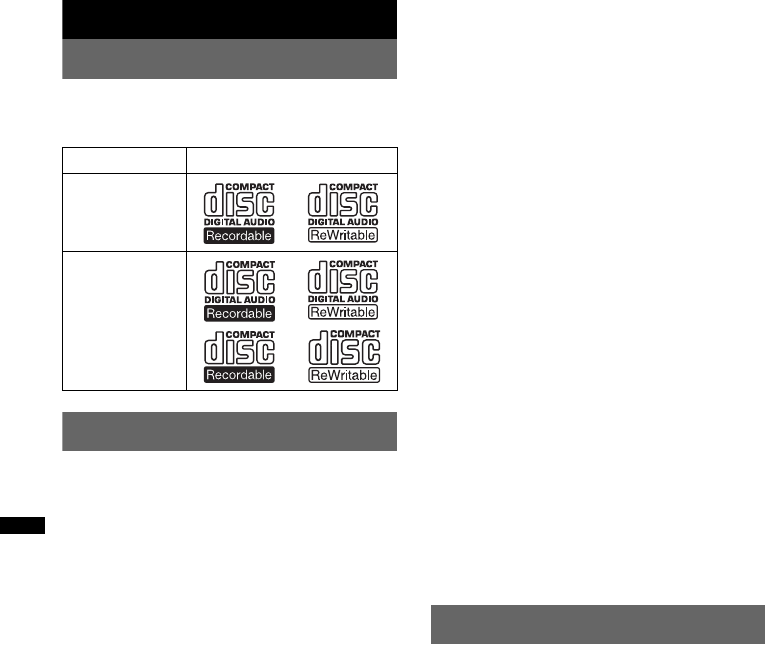
6
Getting Started
Playable discs on this unit
This unit can play CD-DA (also containing CD
TEXT) and CD-R/CD-RW (MP3/WMA/AAC
files (page 31)).
Notes on Bluetooth
Caution
IN NO EVENT SHALL SONY BE LIABLE FOR
ANY INCIDENTAL, INDIRECT OR
CONSEQUENTIAL DAMAGES OR OTHER
DAMAGES INCLUDING, WITHOUT
LIMITATION, LOSS OF PROFITS, LOSS OF
REVENUE, LOSS OF DATA, LOSS OF USE OF
THE PRODUCT OR ANY ASSOCIATED
EQUIPMENT, DOWNTIME, AND
PURCHASER’S TIME RELATED TO OR
ARISING OUT OF THE USE OF THIS
PRODUCT, ITS HARDWARE AND/OR ITS
SOFTWARE.
IMPORTANT NOTICE!
Safe and efficient use
Changes or modifications to this unit not expressly
approved by Sony may void the user’s authority to
operate the equipment.
Please check for exceptions, due to national
requirement or limitations, in usage of Bluetooth
equipment before using this product.
Driving
Check the laws and regulations on the use of cellular
phones and handsfree equipment in the areas where
you drive.
Always give full attention to driving and pull off the
road and park before making or answering a call if
driving conditions so require.
Connecting to other devices
When connecting to any other device, please read its
user guide for detailed safety instructions.
Radio frequency exposure
RF signals may affect improperly installed or
inadequately shielded electronic systems in cars,
such as electronic fuel injection systems, electronic
antiskid (antilock) braking systems, electronic speed
control systems or air bag systems. For installation
or service of this device, please consult with the
manufacturer or its representative of your car. Faulty
installation or service may be dangerous and may
invalidate any warranty that may apply to this
device.
Consult with the manufacturer of your car to ensure
that the use of your cellular phone in the car will not
affect its electronic system.
Check regularly that all wireless device equipment
in your car is mounted and operating properly.
Emergency calls
This Bluetooth car handsfree and the electronic
device connected to the handsfree operate using
radio signals, cellular, and landline networks as well
as user-programmed function, which cannot
guarantee connection under all conditions.
Therefore do not rely solely upon any electronic
device for essential communications (such as
medical emergencies).
Remember, in order to make or receive calls, the
handsfree and the electronic device connected to the
handsfree must be switched on in a service area with
adequate cellular signal strength.
Emergency calls may not be possible on all cellular
phone networks or when certain network services
and/or phone features are in use.
Check with your local service provider.
Resetting the unit
Before operating the unit for the first time, or
after replacing the car battery or changing the
connections, you must reset the unit.
Detach the front panel (page 7) and press the
RESET button (page 12) with a pointed object,
such as a ball-point pen.
Note
Pressing the RESET button will erase the clock setting
and some stored contents.
Type of discs Label on the disc
CD-DA
MP3
WMA
AAC
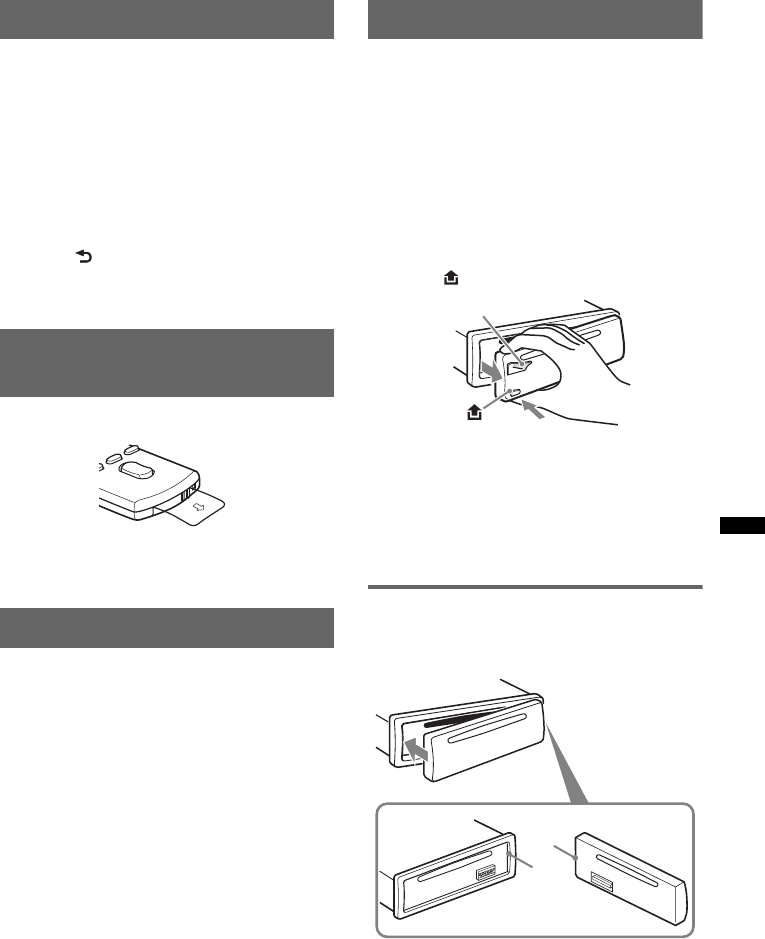
7
Canceling the DEMO mode
You can cancel the demonstration display which
appears during turning off.
1Press and hold the select button.
The setup display appears.
2Rotate the control dial until “DEMO”
appears, then press it.
3Rotate the control dial to select
“DEMO-OFF,” then press it.
The setting is complete.
4Press (BACK).
The display returns to normal reception/play
mode.
Preparing the card remote
commander
Remove the insulation film.
Tip
For how to replace the battery, see page 33.
Setting the clock
The clock uses a 12-hour digital indication.
1Press and hold the select button.
The setup display appears.
2Rotate the control dial until “CLOCK-
ADJ” appears, then press it.
The hour indication flashes.
3Rotate the control dial to set the hour
and minute.
To move the digital indication, press (SEEK)
–/+.
4After setting the minute, press the
select button.
The setup is complete and the clock starts.
To display the clock, press (DSPL). Press
(DSPL) again to return to the previous display.
Tip
You can set the clock automatically with the RDS
feature (page 16).
Detaching the front panel
You can detach the front panel of this unit to
prevent theft.
Caution alarm
If you turn the ignition switch to the OFF
position without detaching the front panel, the
caution alarm will sound for a few seconds.
The alarm will only sound if the built-in
amplifier is used.
1Press and hold (SOURCE/OFF).
The unit is turned off.
2Press , then pull it off towards you.
Notes
•Do not drop or put excessive pressure on the front
panel and display window.
•Do not subject the front panel to heat/high
temperature or moisture. Avoid leaving it in a parked
car or on a dashboard/rear tray.
•Do not detach the front panel during playback of the
USB device, otherwise USB data may be damaged.
Attaching the front panel
Engage part A of the front panel with part B of
the unit, as illustrated, and push the left side into
position until it clicks.
Note
Do not put anything on the inner surface of the front
panel.
(SOURCE/OFF)
B
A

8
Quick Guide for Bluetooth function
For full details on operation, see “Bluetooth (Handsfree calling and Music streaming)” (page 21) and
the Bluetooth device operating instructions.
3 steps to Bluetooth function
1Pairing
First, register (pair) Bluetooth device (cellular phone, etc.) with this unit. Pairing is no longer
required after the first time.
2Connection
After pairing is made, connect this unit and the Bluetooth device. Depending on the device,
connection is automatically made along with the pairing.
3Handsfree calling/Music streaming
You can make/receive a handsfree call, or listen to audio through this unit.
Support site
http://esupport.sony.com
http://www.sony.com/mobileAV
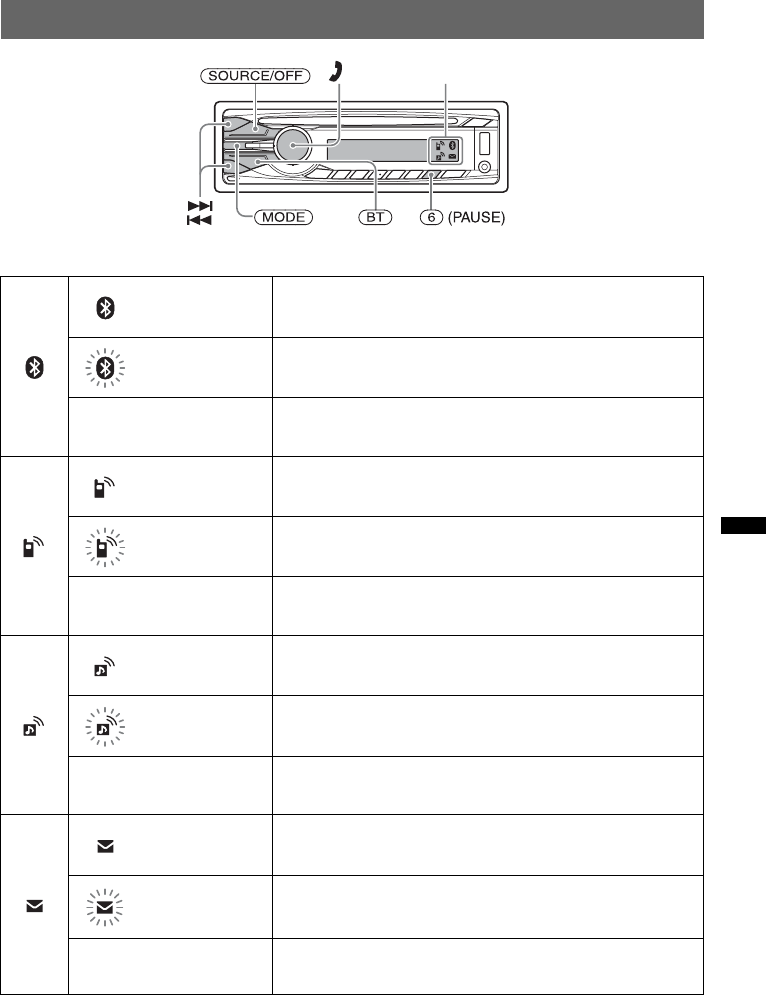
9
Buttons and icons
Icon status descriptions
Lit Bluetooth signal on.
Flashing Pairing standby mode.
None Bluetooth signal off.
Lit Connected to a cellular phone.
Flashing Connection in progress.
None No cellular phone connected for handsfree calling.
Lit Connected to a device.
Flashing Connection in progress.
None No device connected for music streaming.
Lit Some unread SMS messages exist.
Flashing A new SMS message has been received.
None No unread SMS messages exist.
Icons
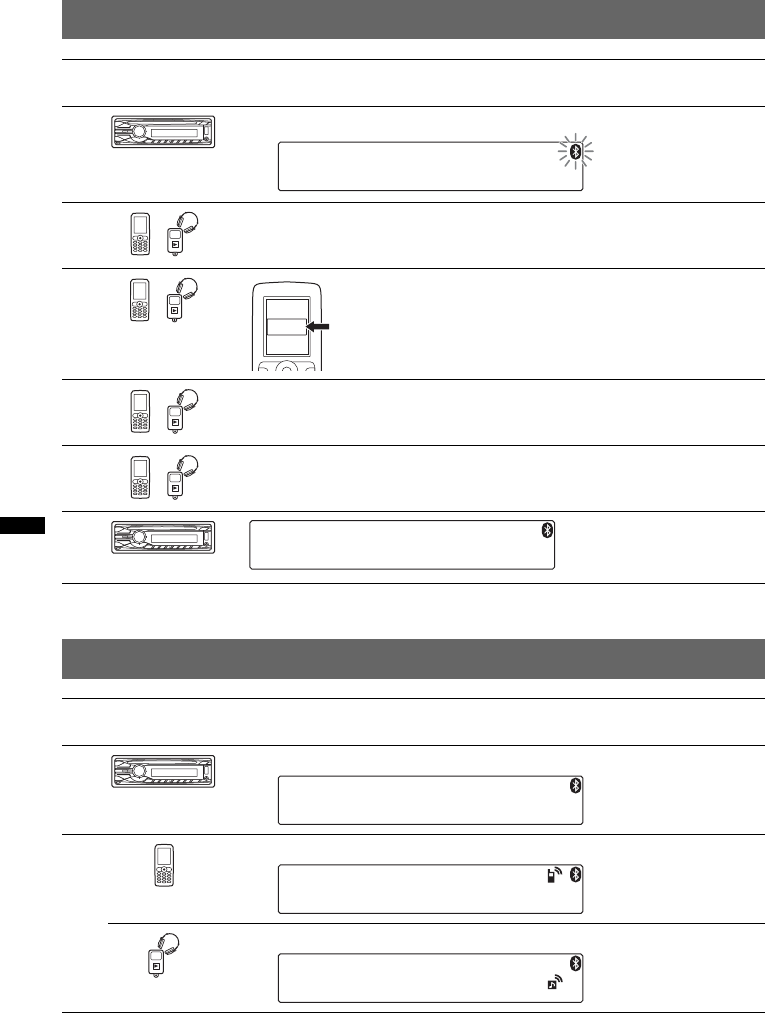
10
1Pairing
2Connection
Note
You can connect from this unit to a Bluetooth device (page 23).
If you cannot connect from this unit to the Bluetooth device, start pairing again.
Operated
equipment
Operation
1Press and hold (BT).
2Search for this unit.
3
4If passkey input is required on the display of the device to be connected,
input “0000.”
5Follow the display directions.
6
Operated
equipment
Operation
1Press (BT).
2Connect to this unit using a cellular phone.
Connect to this unit using an audio device.
t
XXXXXXX
DR-BT30Q
Sony
Automotive
Select “Sony Automotive.”
(Pairing successful)
t
t
t
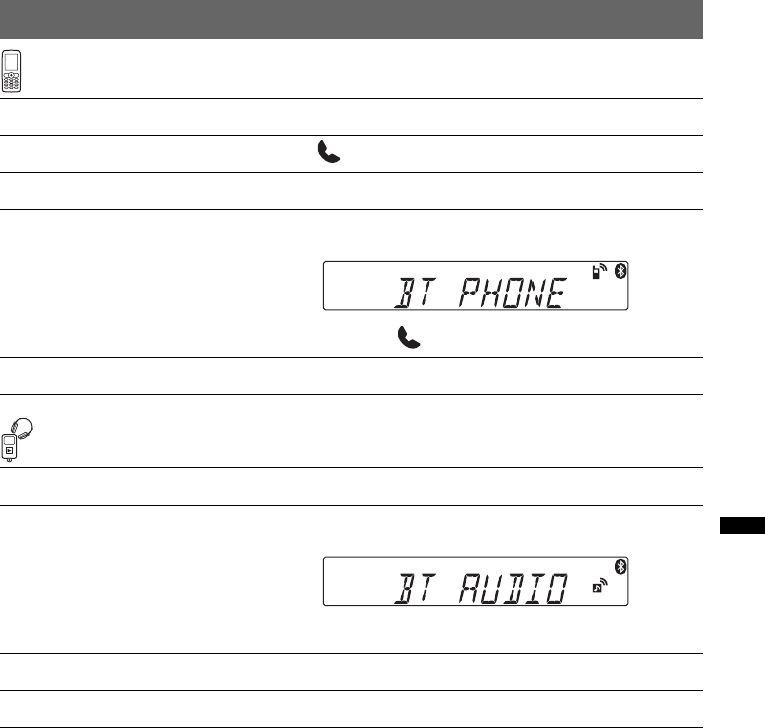
11
3Handsfree calling and Music streaming
Handsfree calling
Music streaming
*Operation may differ depending on the audio device.
To Operation
Receive a call/end a call Press .
Reject a call Press and hold (SOURCE/OFF) for 1 second.
Redial 1Press (SOURCE/OFF) repeatedly until “BT PHONE”
appears.
2Press and hold .
Transfer a call Press (MODE).
To Operation
Listen 1Press (SOURCE/OFF) repeatedly until “BT AUDIO”
appears.
2Start playback on the audio device.
Play/pause (AVRCP)* Press (6) (PAUSE).
Skip tracks (AVRCP)* Press ./>.
t
t
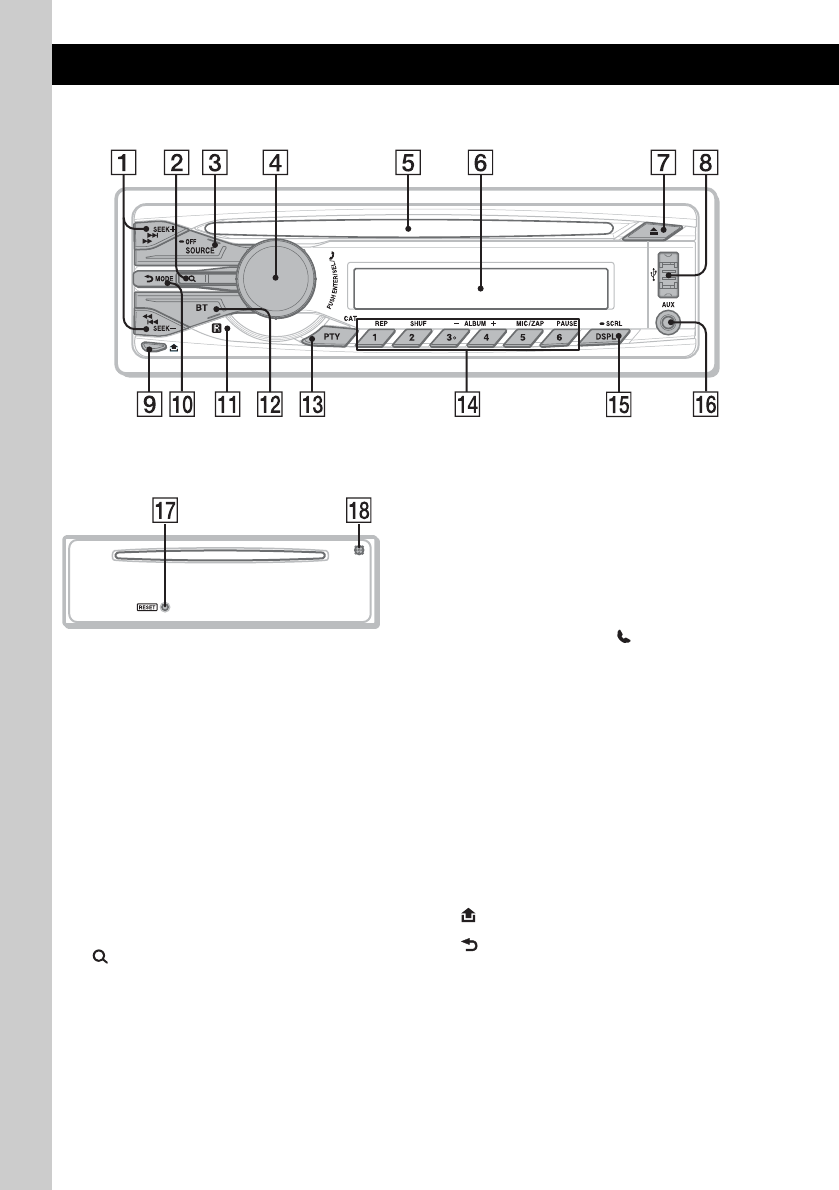
12
Location of controls and basic operations
Main unit
Front panel removed
This section contains instructions on the location
of controls and basic operations.
For details, see the respective pages.
ASEEK +/– buttons
Radio:
To tune in stations automatically (press); find
a station manually (press and hold).
CD/USB:
To skip tracks (press); skip tracks
continuously (press, then press again within
about 1 second and hold); fast-forward/
reverse a track (press and hold).
Bluetooth audio device*1:
To skip tracks (press); fast-forward/reverse a
track (press and hold).
B (BROWSE) button page 20, 24
Press to: Enter the Quick-BrowZer™ mode
(CD/USB)/ list the phonebook (Bluetooth
phone)*2.
Press and hold to: Change the Bluetooth
phone source/list the call history (Bluetooth
phone)*2.
CSOURCE/OFF button*3
Press to turn on the power/change the source
(Radio/CD/USB/AUX/Bluetooth audio/
Bluetooth phone).
Press for 1 second to turn off the power/
reject a call.
Press for more than 2 seconds to turn off the
power and the display disappears.
DControl dial/select / (handsfree)
button page 23, 24, 27, 29
To adjust volume (rotate); select setup items
(press and rotate); receive/end a call (press).
EDisc slot
Insert the disc (label side up), playback
starts.
FDisplay window
GZ (eject) button
To eject the disc.
HUSB connector page 17, 18
To connect to the USB device.
I (front panel release) button page 7
J (BACK)/MODE button page 9, 15,
19, 24, 25
Press to: Return to the previous display/
select the radio band (FM/AM)*3.
Press and hold to: Enter/cancel the passenger
control.
KReceptor for the card remote
commander

13
LBT (BLUETOOTH) button page 9, 21,
23
For Bluetooth signal on/off (press); pairing
(press and hold).
MPTY/CAT*4 button page 16
To select PTY in RDS.
NNumber buttons
Radio:
To receive stored stations (press); store
stations (press and hold).
CD/USB:
(1): REP page 16, 17, 19
(2): SHUF page 16, 17, 19
(3)*5/(4): ALBUM –/+ (during MP3/
WMA/AAC playback)
To skip albums (press); skip albums
continuously (press and hold).
(5): MIC/ZAP page 21
To enter ZAPPIN™ mode (press).
(6): PAUSE
To pause playback. To cancel, press
again.
Bluetooth audio device*1:
(1): REP page 26
(2): SHUF page 26
(3)/(4): ALBUM –/+
To skip albums (press); skip albums
continuously (press and hold).
(6): PAUSE
To pause playback. Press again to
release pause.
Bluetooth phone:
To call stored dials (press); to store preset
dials (press and hold).
(5): MIC/ZAP (during a call) page 25
To set the MIC Gain (press); to select
Echo Canceller/Noise Canceller mode
(press and hold).
ODSPL (display)/SCRL (scroll) button
page 15, 16, 17, 18, 19, 23
To change display items (press); scroll the
display item (press and hold).
PAUX input jack page 30
To connect a portable audio device.
QRESET button (located behind the front
panel) page 6
RMicrophone page 23
Note
Do not cover the microphone, the handsfree
function may not work properly.
*1 When a Bluetooth audio device (supports AVRCP
of Bluetooth technology) is connected. Depending
on the device, certain operations may not be
available.
*2 When a cellular phone (supports PBAP of
Bluetooth technology) is connected.
*3 If an HD Radio tuner or SAT tuner is connected:
when (SOURCE/OFF) is pressed, the connected
device (“HD,” “XM” or “SR”) will appear in the
display. Furthermore, if (MODE) is pressed, you
can switch the HD Radio tuner band or SAT tuner
band.
*4 When the SAT tuner is connected.
*5 This button has a tactile dot.
Notes
•When ejecting/inserting a disc, keep any USB
devices disconnected to avoid damage to the disc.
•If the unit is turned off and the display disappears, it
cannot be operated with the card remote
commander unless (SOURCE/OFF) on the unit is
pressed, or a disc is inserted to activate the unit first.
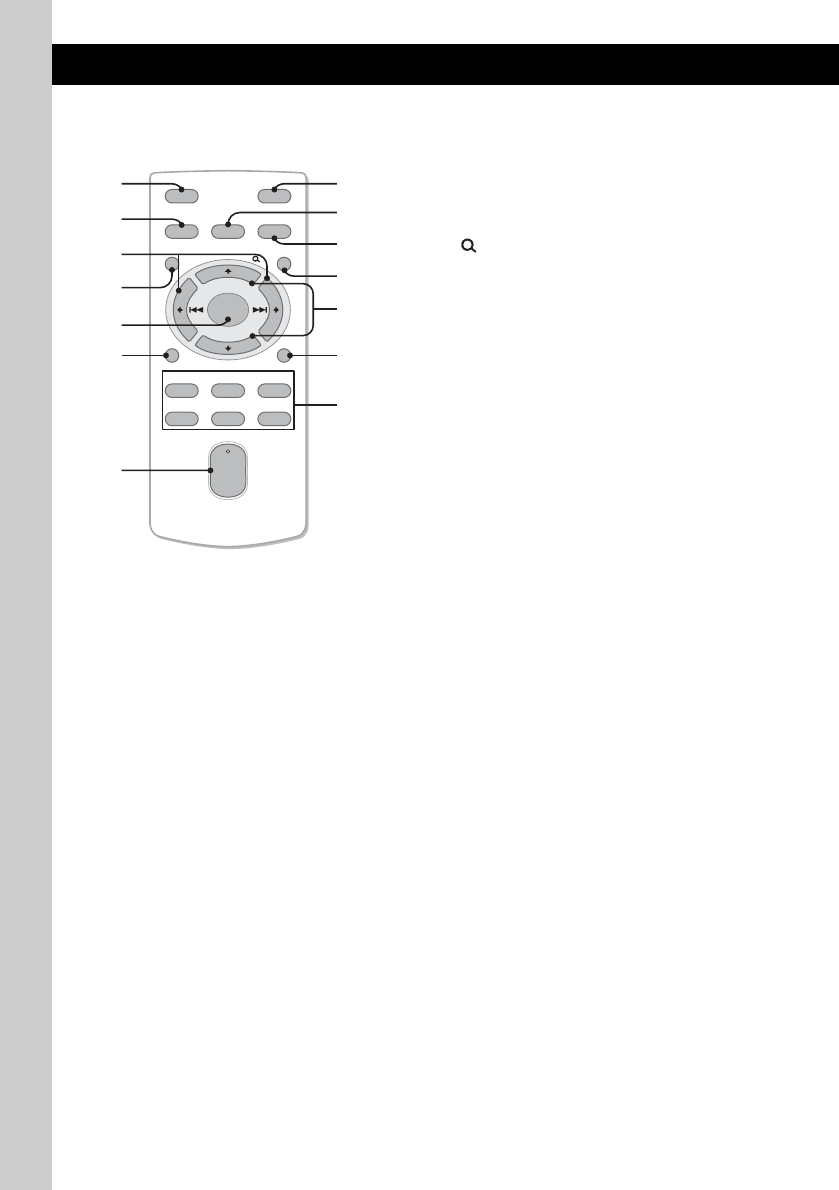
14
RM-X172
Card Remote Commander
Remove the insulation film before use (page 7).
AOFF button
To turn off the power; stop the source; reject
a call.
BSOURCE button*1
To turn on the power; change the source
(Radio/CD/USB/AUX/Bluetooth audio/
Bluetooth phone).
C< (.)/, (>) buttons
To control Radio/CD/USB/Bluetooth audio,
the same as (SEEK) –/+ on the unit.
Setup, sound setting, etc., can be operated by
< ,.
DMENU button
To enter menu.
EENTER button
To apply a setting; receive a call; end a call.
FDSPL (display) button
To change display items.
GVOL (volume) +*2/– button
To adjust volume.
HATT (attenuate) button
To attenuate the sound. To cancel, press
again.
ISOUND button
To enter sound setting.
JMODE button
Press to select the radio band (FM/AM)*1.
Press and hold to enter/cancel the passenger
control.
K (BROWSE)/CAT*3 button
Press to: Enter the Quick-BrowZer™ mode
(CD/USB)/ list the phonebook (Bluetooth
phone).
Press and hold to: Change the Bluetooth
phone source/list the call history (Bluetooth
phone).
LM (+)/m (–) buttons
To control CD/USB/Bluetooth audio device,
the same as (3)/(4) (ALBUM –/+) on the
unit.
Setup, sound setting, etc., can be operated by
M m.
MSCRL (scroll) button
To scroll the display item.
NNumber buttons
Radio:
To receive stored stations (press); store
stations (press and hold).
CD/USB/Bluetooth audio device*4:
(1): REP
(2): SHUF
(6): PAUSE
To pause playback. Press again to
release pause.
*1 If an HD Radio tuner or SAT tuner is connected:
when (SOURCE) is pressed, the connected device
(“HD,” “XM” or “SR”) will appear in the display.
Furthermore, if (MODE) is pressed, you can switch
the HD Radio tuner band or SAT tuner band.
*2 This button has a tactile dot.
*3 When the SAT tuner is connected.
*4 When a Bluetooth audio device (supports AVRCP
of Bluetooth technology) is connected. Depending
on the device, certain operations may not be
available.
OFF
DSPL SCRL
SOURCE
MODE
132
465
ATT
VOL
+
–
+
–
REP SHUF
MENU
SOUND
PAU SE
ENTER
/CAT
29
0
1
3
4
5
6
8
7
qf
qs
qa
qd
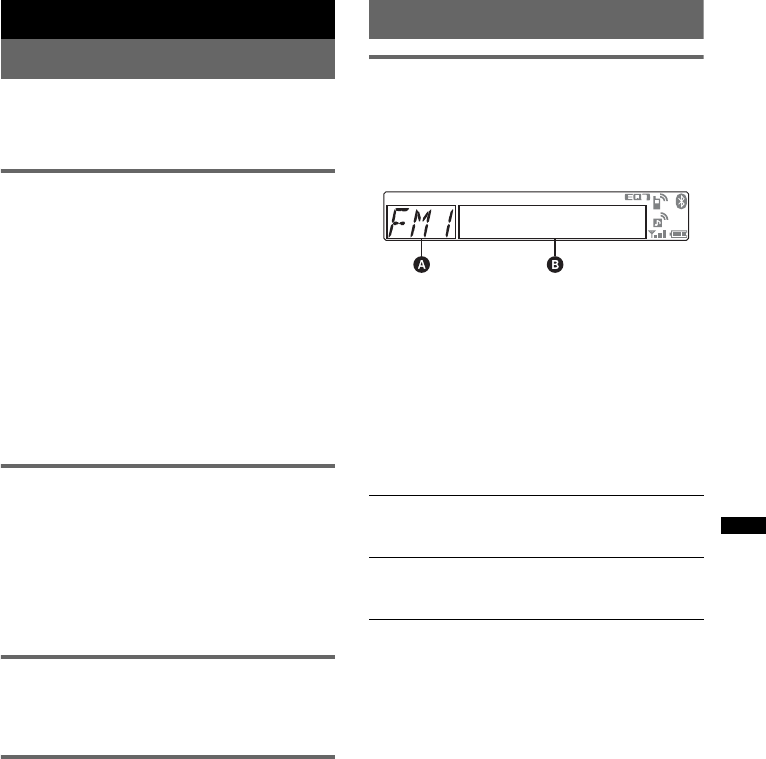
15
Radio
Storing and receiving stations
Caution
When tuning in stations while driving, use Best
Tuning Memory (BTM) to prevent an accident.
Storing automatically — BTM
1Press (SOURCE/OFF) repeatedly until
“TUNER” appears.
To change the band, press (MODE)
repeatedly. You can select from FM1, FM2,
FM3, AM1 or AM2.
2Press and hold the select button.
The setup display appears.
3Rotate the control dial until “BTM”
appears, then press it.
The unit stores stations in order of frequency
on the number buttons.
A beep sounds when the setting is stored.
Storing manually
1While receiving the station that you
want to store, press and hold a
number button ((1) to (6)) until
“MEM” appears.
Note
If you try to store another station on the same number
button, the previously stored station will be replaced.
Receiving the stored stations
1Select the band, then press a number
button ((1) to (6)).
Tuning automatically
1Select the band, then press (SEEK) +/–
to search for the station.
Scanning stops when the unit receives a
station. Repeat this procedure until the
desired station is received.
Tip
If you know the frequency of the station you want to
listen to, press and hold (SEEK) +/– to locate the
approximate frequency, then press (SEEK) +/–
repeatedly to fine adjust to the desired frequency
(manual tuning).
RDS
Overview
FM stations with Radio Data System (RDS)
service send inaudible digital information along
with the regular radio program signal.
Display items
ARadio band, Function
BProgram service name, Clock, Frequency*,
Preset number
*While receiving the RDS station, “ *” is displayed on
the left of the frequency indication.
To change display items
B
, press
(DSPL)
.
RDS services
This unit automatically provides RDS services as
follows:
Notes
•Depending on the country/region, not all RDS
functions may be available.
•RDS will not work if the signal strength is too weak,
or if the station you are tuned to is not transmitting
RDS data.
PTY (Program Types)
Displays the currently received program type.
Also searches your selected program type.
CT (Clock Time)
The CT data from the RDS transmission sets
the clock.
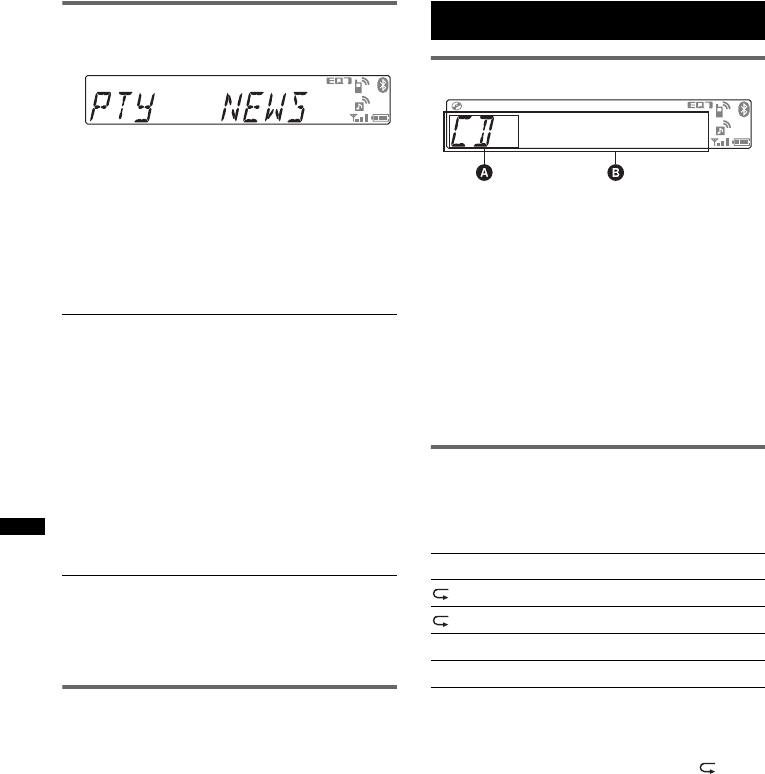
16
Selecting PTY
1Press (PTY) during FM reception.
The current program type name appears if the
station is transmitting PTY data.
2Rotate the control dial until the
desired program type appears, then
press it.
The unit starts to search for a station
broadcasting the selected program type.
Type of programs
Notes
•You cannot use this function in countries/regions
where no PTY data is available.
•You may receive a different radio program from the
one you select.
Setting CT
1Set “CT-ON” in setup (page 29).
Notes
•The CT function may not work even though an RDS
station is being received.
•There might be a difference between the time set by
the CT function and the actual time.
CD
Display items
ASource
BTrack name*1, Disc/artist name*1, Artist
name*1, Album number*2, Album name*1,
Track number/Elapsed playing time, Clock
*1 The information of a CD TEXT, MP3/WMA/AAC is
displayed.
*2 Album number is displayed only when the album is
changed.
To change display items B, press (DSPL).
Tip
Displayed items may differ depending on the disc type,
recording format and settings.
Repeat and shuffle play
1During playback, press (1) (REP) or
(2) (SHUF) repeatedly until the
desired setting appears.
*When an MP3/WMA/AAC is played.
After 3 seconds, the setting is complete.
To return to normal play mode, select “ OFF”
or “SHUF OFF.”
NEWS (News), INFORM (Information),
SPORTS (Sports), TALK (Talk), ROCK
(Rock), CLS ROCK (Classic Rock), ADLT
HIT (Adult Hits), SOFT RCK (Soft Rock),
TOP 40 (Top 40), COUNTRY (Country),
OLDIES (Oldies), SOFT (Soft), NOSTALGA
(Nostalgia), JAZZ (Jazz), CLASSICL
(Classical), R AND B (Rhythm and Blues),
SOFT R B (Soft Rhythm and Blues),
LANGUAGE (Foreign Language), REL
MUSC (Religious Music), REL TALK
(Religious Talk), PERSNLTY (Personality),
PUBLIC (Public), COLLEGE (College),
WEATHER (Weather) Select To play
TRACK track repeatedly.
ALBUM* album repeatedly.
SHUF ALBUM* album in random order.
SHUF DISC disc in random order.
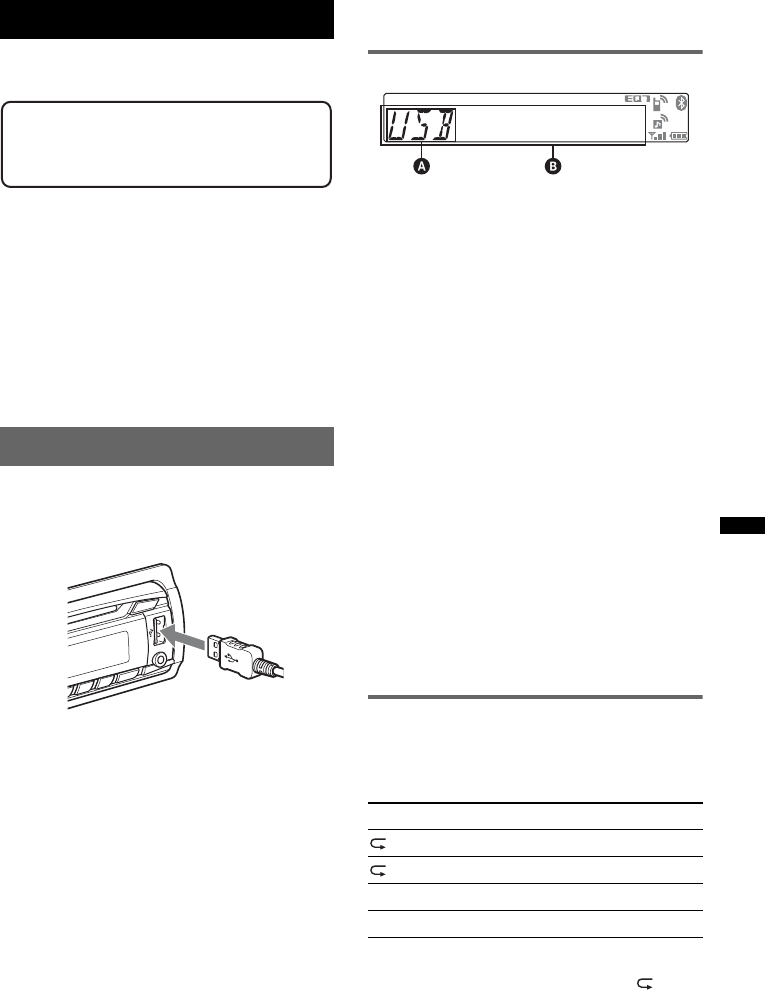
17
USB devices
For details on the compatibility of your USB
device, visit the support site.
• MSC (Mass Storage Class) and MTP (Media
Transfer Protocol) type USB devices compliant
with the USB standard can be used.
• Corresponding codec is MP3 (.mp3), WMA
(.wma), AAC (.m4a) and AAC (.mp4).
• Backup of data in a USB device is
recommended.
Note
Connect the USB device after starting the engine.
Depending on the USB device, malfunction or damage
may occur if it is connected before starting the engine.
Playing from a USB device
1Connect the USB device to the USB
connector.
When using a cable, use the one supplied with
the USB device to connect.
Playback starts.
If a USB device is already connected, to start
playback, press (SOURCE/OFF) repeatedly until
“USB” appears.
Press and hold (SOURCE/OFF) for 1 second to
stop playback.
Removing the USB device
1Stop the USB device playback.
2Remove the USB device.
If you remove your USB device during
playback, data in the USB device may be
damaged.
Notes
•Do not use USB devices so large or heavy that they
may fall down due to vibration, or cause a loose
connection.
•Do not detach the front panel during playback of the
USB device, otherwise USB data may be damaged.
•This unit cannot recognize USB devices via a USB
hub.
Display items
ASource
BTrack name, Artist name, Album number*,
Album name, Track number/Elapsed playing
time, Clock
*Album number is displayed only when the album is
changed.
To change display items B, press (DSPL).
Notes
•Displayed items will differ, depending on the USB
device, recorded format and settings. For details,
visit the support site.
•The maximum number of displayable data is as
follows.
– folders (albums): 128
– files (tracks) per folder: 500
•Do not leave a USB device in a parked car, as
malfunction may result.
•It may take time for playback to begin, depending on
the amount of recorded data.
•DRM (Digital Rights Management) files may not be
played.
•During playback or fast-forward/reverse of a VBR
(Variable Bit Rate) MP3/WMA/AAC file, elapsed
playing time may not display accurately.
•Playback of the following MP3/WMA/AAC files is not
supported.
– lossless compression
– copyright-protected
Repeat and shuffle play
1During playback, press (1) (REP) or
(2) (SHUF) repeatedly until the
desired setting appears.
After 3 seconds, the setting is complete.
To return to normal play mode, select “ OFF”
or “SHUF OFF. ”
Support site
http://esupport.sony.com
http://www.sony.com/mobileAV
Select To play
TRACK track repeatedly.
ALBUM album repeatedly.
SHUF ALBUM album in random order.
SHUF DEVICE device in random order.
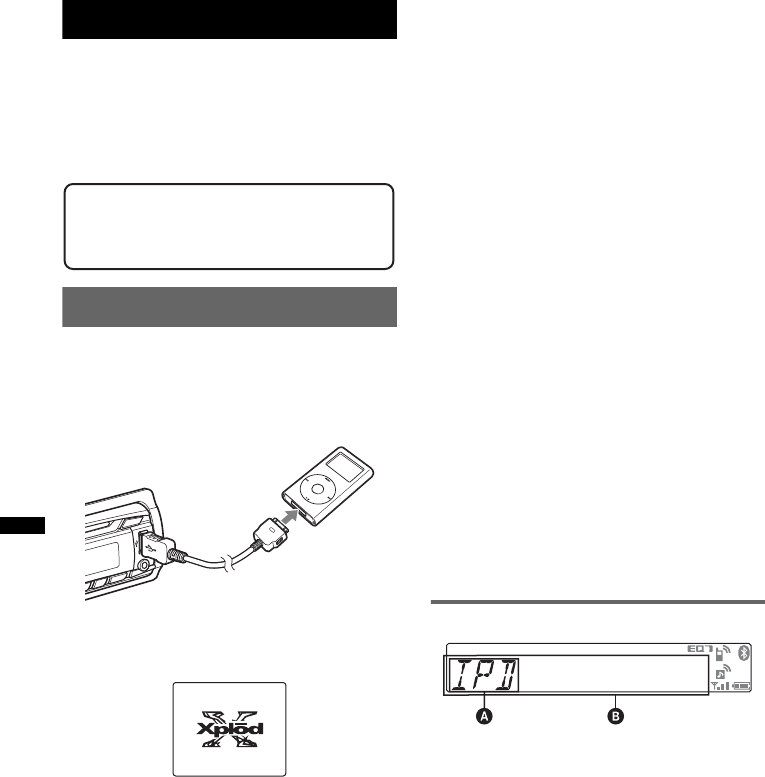
18
iPod
For details on the compatibility of your iPod, see
“About iPod” on page 32 or visit the support site.
In these Operating Instructions, “iPod” is used as
a general reference for the iPod functions on the
iPod and iPhone, unless otherwise specified by
the text or illustrations.
Playing an iPod
Before connecting the iPod, turn down the
volume of the unit.
1Connect the iPod to the USB
connector via the dock connector to
USB cable.
The iPod will turn on automatically, and the
display will appear on the iPod screen as
below.*
Tip
We recommend the RC-100IP USB cable (not
supplied) to connect the dock connector.
The tracks on the iPod start playing
automatically from the point last played.
If an iPod is already connected, to start
playback press (SOURCE/OFF) repeatedly
until “USB” appears. (“IPD” appears in the
display when iPod is recognized.)
*In the case of an iPod touch or iPhone being
connected, or that the iPod was last played using
passenger control, the logo will not appear on the
screen.
2Adjust the volume.
Press and hold (SOURCE/OFF) for 1 second to
stop playback.
Removing the iPod
1Stop the iPod playback.
2Remove the iPod.
Caution for iPhone
When you connect an iPhone via USB, telephone
volume is controlled by iPhone itself. In order to avoid
sudden loud sound after a call, do not increase the
volume on the unit during a telephone call.
Notes
•Do not detach the front panel during playback of the
iPod, otherwise data may be damaged.
•This unit cannot recognize iPod via a USB hub.
Tips
•When the ignition key is turned to the ACC position,
and the unit is on, the iPod will be recharged.
•If the iPod is disconnected during playback, “NO
DEV” appears in the display of the unit.
Resuming mode
When the iPod is connected to the dock
connector, the mode of this unit changes to
resuming mode and playback starts in the mode
set by the iPod.
In resuming mode, the following buttons do not
function.
– (1) (REP)
– (2) (SHUF)
Display items
ASource (iPod) indication
BTrack name, Artist name, Album name, Track
number/Elapsed playing time, Clock
To change display items B, press (DSPL).
Tip
When album/podcast/genre/artist/playlist is changed,
its item number appears momentarily.
Note
Some letters stored in iPod may not be displayed
correctly.
Support site
http://esupport.sony.com
http://www.sony.com/mobileAV
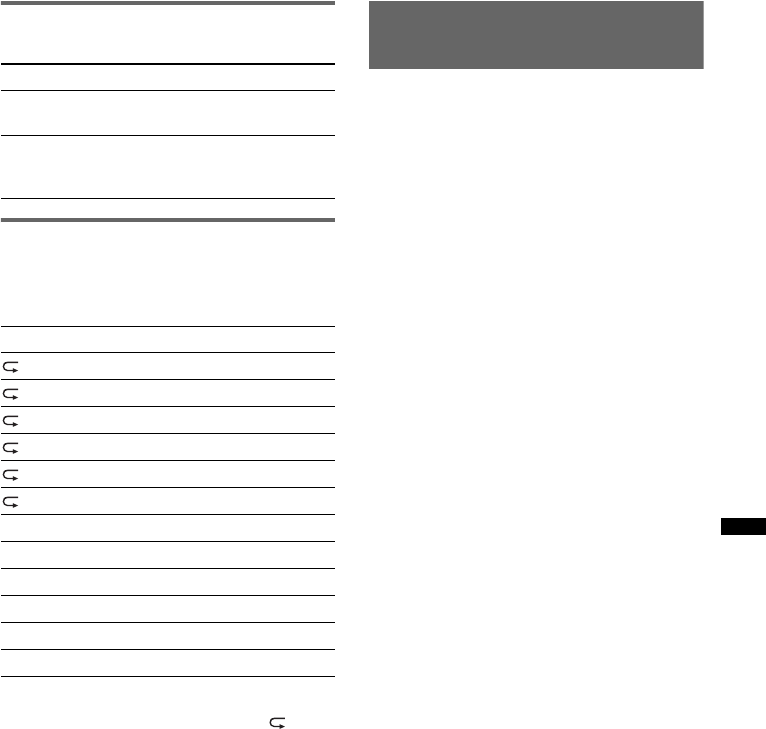
19
Skipping albums, podcasts,
genres, playlists and artists
Repeat and shuffle play
1During playback, press (1) (REP) or
(2) (SHUF) repeatedly until the
desired setting appears.
After 3 seconds, the setting is complete.
To return to normal play mode, select “ OFF”
or “SHUF OFF.”
Operating an iPod directly
— Passenger control
You can operate an iPod connected to the dock
connector directly.
1During playback, press and hold
(MODE).
“MODE IPOD” appears and you will be able
to operate the iPod directly.
To change the display item
Press (DSPL).
The display items change as follows:
Track name t Artist name t Album name t
MODE IPOD t Clock
To exit the passenger control
Press and hold (MODE).
Then “MODE AUDIO” will appear and the play
mode will change to resuming mode.
Notes
•The volume can be adjusted only by the unit.
•If this mode is canceled, the repeat setting will be
turned off.
To Do this
Skip Press (3)/(4) (ALBUM –/+)
[press once for each]
Skip
continuously Press and hold (3)/(4)
(ALBUM –/+)
[hold to desired point]
Select To play
TRACK track repeatedly.
ALBUM album repeatedly.
PODCAST podcast repeatedly.
ARTIST artist repeatedly.
PLAYLIST playlist repeatedly.
GENRE genre repeatedly.
SHUF ALBUM album in random order.
SHUF PODCAST podcast in random order.
SHUF ARTIST artist in random order.
SHUF PLAYLIST playlist in random order.
SHUF GENRE genre in random order.
SHUF DEVICE device in random order.
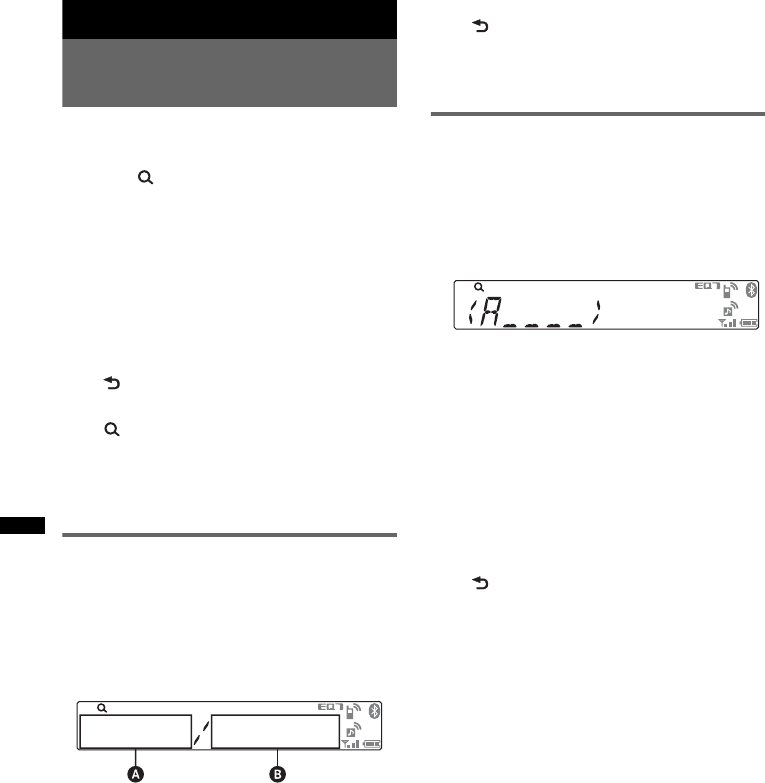
20
Searching for a track
Searching a track by name
— Quick-BrowZer™
You can search for a track in a CD or USB device
easily by category.
1Press (BROWSE).
The unit enters the Quick-BrowZer mode,
and the list of search categories appears.
2Rotate the control dial to select the
desired search category, then press it
to confirm.
3Repeat step 2 until the desired track is
selected.
Playback starts.
To return to the previous display
Press (BACK).
To exit the Quick-BrowZer mode
Press (BROWSE).
Note
When entering the Quick-BrowZer mode, the repeat/
shuffle setting is canceled.
Searching by skip items
— Jump mode
When many items are in a category, you can
search for a desired item quickly.
1Press (SEEK) + in Quick-BrowZer
mode.
The following display appears.
ACurrent item number
BTotal item number in the current layer
Then the item name will appear.
2Rotate the control dial to select the
desired item or one near the desired
item.
It skips in steps of 10% of the total item
number.
3Press the select button.
The display returns to the Quick-BrowZer
mode and the selected item appears.
4Rotate the control dial to select the
desired item and press it.
Playback starts if the selected item is a track.
To cancel Jump mode
Press (BACK) or (SEEK) –.
Note
If no operation is performed for 7 seconds, the Jump
mode is canceled.
Searching by alphabetical order
— Alphabet search
When an iPod is connected to the unit, you can
search for a desired item alphabetically.
1Press (SEEK) + in Quick-BrowZer
mode.
An alphabetical list appears.
2Rotate the control dial to select the
first letter of the desired item, then
press it.
A list of items beginning with the selected
letter appears in alphabetical order.
If there is no song beginning with the selected
letter, “NOT FOUND” appears.
3Rotate the control dial to select the
desired item, then press it.
Playback starts if the selected item is a track.
To cancel Alphabet search
Press (BACK) or (SEEK) –.
A list of the search categories appears.
Notes
•In Alphabet search, a symbol or article (a/an/the)
before the selected letter of the item is excluded.
•Depending on the search item you select, only Jump
mode may be available.
•If no operation is performed for 5 seconds, Alphabet
search is canceled.
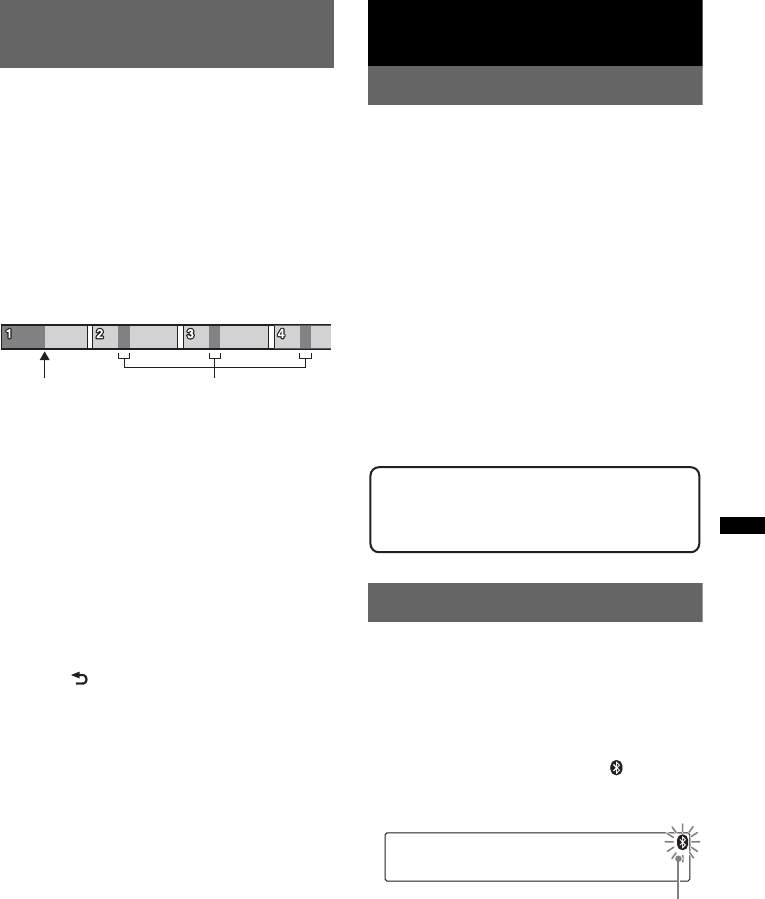
21
Searching a track by listening
to track passages — ZAPPIN™
While playing short track passages in a CD or
USB device in sequence, you can search for a
track you want to listen to.
ZAPPIN mode is suitable for searching for a
track in shuffle or shuffle repeat mode.
1Press (5) (MIC/ZAP) during playback.
After “ZAPPIN” appears in the display,
playback starts from a passage of the next
track.
The passage is played for the set time, then a
click sounds and the next passage starts.
2Press the select button or (5) (MIC/
ZAP) when a track you want to listen
to is played.
The track that you select returns to normal
play mode from the beginning.
To search a track by ZAPPIN mode again,
repeat steps 1 and 2.
Tips
•You can select the playback time from about 6
seconds/15 seconds/30 seconds (page 30). You
cannot select the passage of the track to play.
•Press (SEEK) +/– or (3)/(4) (ALBUM –/+) in
ZAPPIN mode to skip a track or album.
•Pressing (BACK) also confirms a track to
playback.
Bluetooth (Handsfree calling
and Music streaming)
Bluetooth operations
To use the Bluetooth function, the following
procedure is necessary.
1Pairing
When connecting Bluetooth devices for the
first time, mutual registration is required. This
is called “pairing.” Registration is required
only for the first time, as this unit and the
other devices will recognize each other
automatically thereafter. You can pair up to 9
devices. (Depending on the device, you may
need to input a passkey for each connection.)
2Connection
To use the device after pairing is made, start
the connection. Sometimes pairing allows for
connection automatically.
3Handsfree calling/Music streaming
You can talk handsfree and listen to music
when the connection is made.
Pairing
First, register (pair) a Bluetooth device (cellular
phone, etc.) with this unit. You can pair up to 9
devices. Once pairing is established, there is no
need for pairing again.
1Place the Bluetooth device within 1 m
(3 ft) of this unit.
2Press and hold (BT) until “ ” flashes
(more than 2 seconds).
The unit enters pairing standby mode.
The part of each track to
play in ZAPPIN mode.
Track
(5) pressed.
continue to next page t
Support site
http://esupport.sony.com
http://www.sony.com/mobileAV
flashing
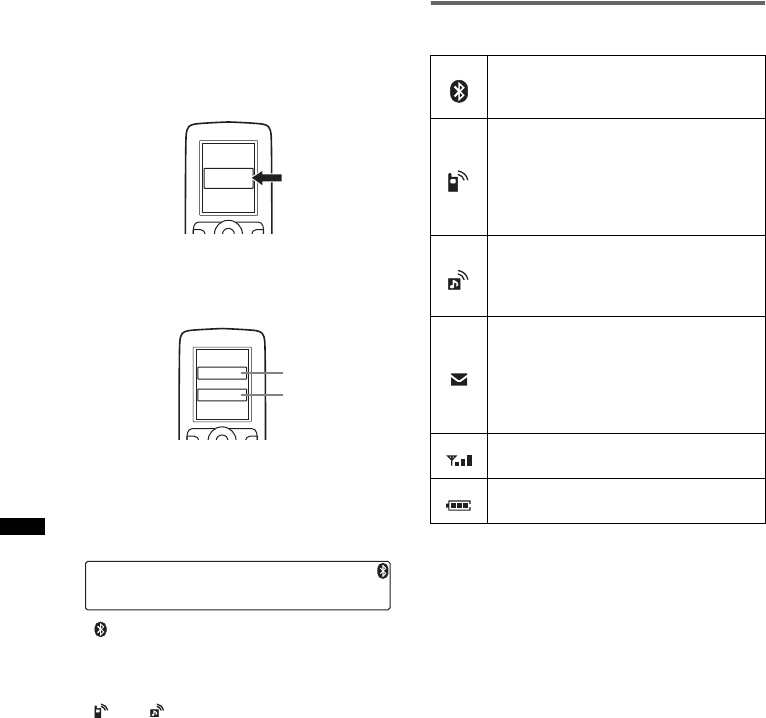
22
3Set the Bluetooth device to search for
this unit.
A list of detected devices appears in the
display of the device to be connected. This
unit is displayed as “Sony Automotive” on
the device to be connected.
4If Passkey* input is required on the
display of the device to be connected,
input “0000.”
This unit and the Bluetooth device memorize
each other’s information, and when pairing is
made, the unit is ready for connection to the
device. If the device supports Bluetooth
version 2.1, passkey input is not required.
“ ” flashes and then stays lit after pairing is
complete.
5Set the Bluetooth device to connect to
this unit.
“ ” or “ ” appears when the connection is
made.
*Passkey may be called “passcode,” “PIN code,” “PIN
number” or “Password,” etc., depending on the
device.
Notes
•While connecting to a Bluetooth device, this unit
cannot be detected from another device. To enable
detection, enter the pairing mode and search for this
unit from another device.
•It may take time to search or connect.
•Depending on the device, the confirmation display of
the connection appears before inputting the
passkey.
•The time limit for inputting the passkey differs
depending on the device.
•This unit cannot be connected to a device that
supports only HSP (Head Set Profile).
About Bluetooth icons
The following icons are used by this unit.
*Turns off without handsfree connection. Differs in the
case of a cellular phone.
XXXXXXX
DR-BT30Q
Sony
Automotive
XXXX
Input passkey.
“0000”
Lit:
Flashing:
None:
Bluetooth signal is on.
Pairing is in standby mode.
Bluetooth signal is off.
Lit:
Flashing:
None:
Connected to a cellular
phone.
Connection is in progress.
No cellular phone is
connected for handsfree
calling.
Lit:
Flashing:
None:
Connected to a device.
Connection is in progress.
No device is connected for
music streaming.
Lit:
Flashing:
None:
Some unread SMS
messages exist.
A new SMS message has
been received.
No unread SMS messages
exist.
Signal strength status of
connected cellular phone.*
Remaining battery status of
connected cellular phone.*
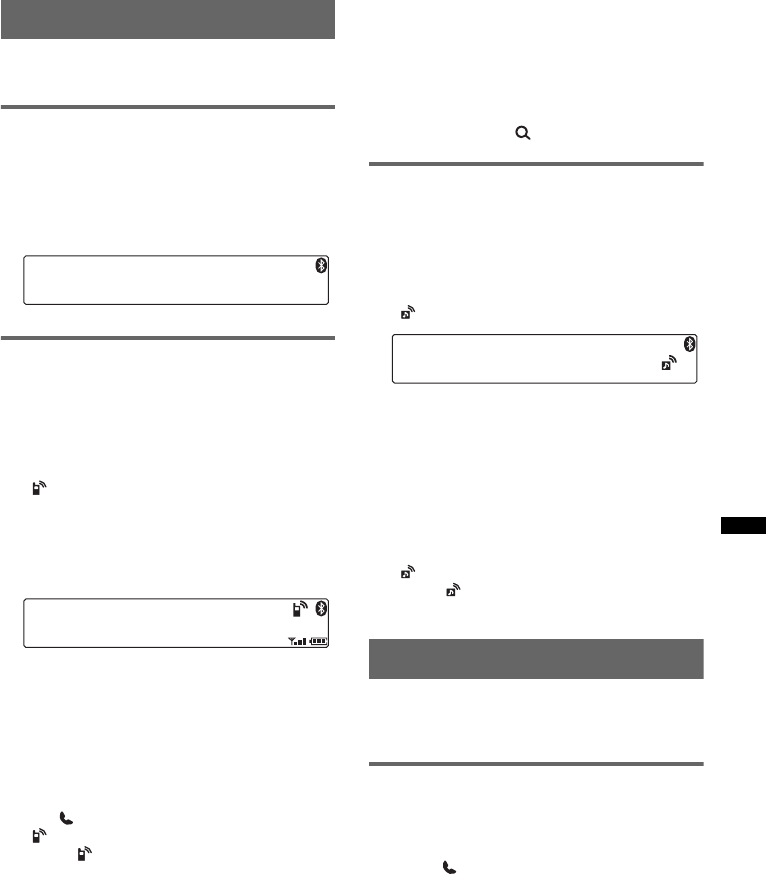
23
Connection
If pairing has already been achieved, start
operation from here.
To switch the Bluetooth signal
output of this unit to on
To use the Bluetooth function, switch the
Bluetooth signal output of this unit to on.
1Press (BT).
Bluetooth signal is activated.
Connecting a cellular phone
1Be sure that both this unit and the
cellular phone are switched to
Bluetooth signal on.
2Connect to this unit using the cellular
phone.
“ ” appears when the connection is made. If
you select the Bluetooth Phone source after
the connection is made, the network name
and the connected cellular phone name
appear in the display. To change display
items, press (DSPL).
Connecting the last-connected
cellular phone from this unit
1Be sure the cellular phone is switched to
Bluetooth signal on.
2Press (SOURCE/OFF) repeatedly until “BT
PHONE” appears.
3Press (handsfree).
“ ” flashes while the connection is being
made. “ ” stays lit when the connection is
made.
Notes
•Some cellular phones require permission to access
their phonebook data during handsfree connection
to this unit. Obtain permission via the cellular phone.
•While streaming Bluetooth audio, you cannot
connect from this unit to the cellular phone. Connect
from the cellular phone to this unit instead. A
connecting noise may be heard over playback
sound.
Tips
•With Bluetooth signal on: when the ignition is turned
to on, this unit reconnects automatically to the last-
connected cellular phone. But automatic connection
also depends on the cellular phone’s specification. If
automatic connection is not made, connect
manually.
•You can also select the Bluetooth Phone source by
pressing and holding (BROWSE).
Connecting an audio device
1Be sure that both this unit and the
audio device are switched to
Bluetooth signal on.
2Connect to this unit using the audio
device.
“ ” appears when the connection is made.
Connecting the last-connected audio
device from this unit
1Be sure the audio device is switched to
Bluetooth signal on.
2Press (SOURCE/OFF) repeatedly until “BT
AUDIO” appears.
3Press (6).
“ ” flashes while the connection is being
made. “ ” stays lit when the connection is
made.
Handsfree calling
Once the unit is connected to the cellular phone,
you can make/receive handsfree calls by
operating this unit.
Receiving calls
When receiving a call, a ringtone is output from
your car speakers. The name or the phone
number appear in the display.
1Press (handsfree) when a call is
received with a ringtone.
The phone call starts.
Notes
•Depending on the cellular phone, caller name may
appear.
•The built-in microphone of this unit is located on the
rear of the front panel (page 12). Do not cover the
microphone with tape, etc.
continue to next page t

24
Auto Answer setting
You can select an auto answer setting from
“OFF,” “1 (about 3 seconds)” or “2 (about 10
seconds)” (page 30).
Ringtone setting
You can switch the ringtone from “1 (this unit)”
or “2 (cellular phone)” (page 30).
*Depending on the cellular phone, this unit’s ringtone
may be output even if set to “2 (cellular phone).”
To reject a call
Press and hold (SOURCE/OFF) for 1 second.
To end a call
Press (handsfree) again.
Note
Even if the call is ended, the Bluetooth connection is
not canceled.
Tip
You can also end a call by pressing (SOURCE/OFF) on
this unit for 1 second.
Making calls
Calling from the phonebook
When connecting to a cellular phone supporting
PBAP (Phone Book Access Profile), you can
access the Phonebook, and make a call.
1Press (SOURCE/OFF) repeatedly until “BT
PHONE” appears.
2Press (BROWSE).
The phonebook appears.
3Rotate the control dial to select an initial from
the initial list, then press it.
4Rotate the control dial to select a name from
the name list, then press it.
5Rotate the control dial to select a number from
the number list, then press it.
The phone call starts.
Notes
•The phonebook may not be displayed correctly
when the cellular phone’s phonebook is deleted.
•Depending on the cellular phone, displayed contacts
on the unit may differ from the phonebook of the
cellular phone.
Note on phonebook data
Prior to disposal or changing ownership of your car
with this unit still installed, be sure to press the RESET
button to erase all the phonebook data in this unit to
prevent possible unauthorized access.
Disconnecting the power supply lead will also erase all
the phonebook data.
Calling from the call history
1Press (SOURCE/OFF) repeatedly until “BT
PHONE” appears.
2Press and hold (BROWSE).
A list of the call history appears.
3Rotate the control dial to select a name and
phone number from the call history, then press
it.
The phone call starts.
Notes
•You can call from the call history (up to 20).
•The call history may not change even if the cellular
phone’s call history is deleted.
Calling by phone number input
1Press (SOURCE/OFF) repeatedly until “BT
PHONE” appears.
2Press and hold (MODE).
3Rotate the control dial to select the phone
number, and lastly select “ ” (space).
4Press (handsfree).
The phone call starts.
Note
“_” appears instead of “#” on the display.
Calling by preset number
You can store up to 6 contacts in the preset dial.
For details on how to store, see “Preset dial”
(page 25).
1Press (SOURCE/OFF) repeatedly until “BT
PHONE” appears.
2Press a number button ((1) to (6)) to select
the contact you want to call.
3Press (handsfree).
The phone call starts.
Calling by redial
1Press (SOURCE/OFF) repeatedly until “BT
PHONE” appears.
2Press and hold .
The phone call starts.
Operations during a call
Presetting the volume of the ringtone
and talker’s voice
You can preset the volume level of the ringtone
and talker’s voice.
To adjust the ringtone volume:
Rotate the control dial while receiving a call.
Ringtone volume can be adjusted.
To adjust the talker’s voice volume:
Rotate the control dial during a call. The talker’s
voice volume can be adjusted.
Note
If the Bluetooth Phone source is selected, rotating the
control dial will only adjust the talker’s volume.
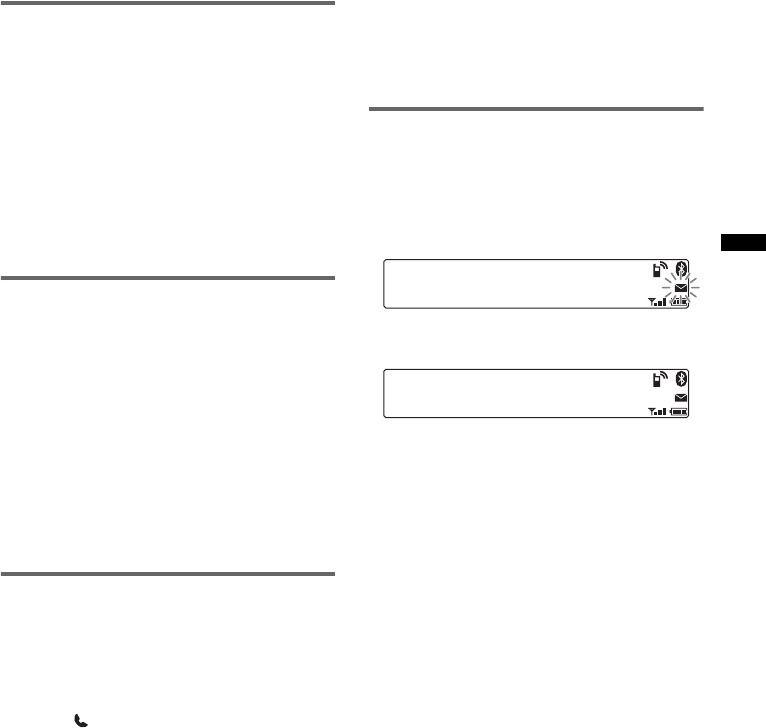
25
Mic Gain adjustment
You can adjust the volume for the other party.
Press (5) to adjust the volume levels (“MIC-
LOW,” “MIC-MID,” “MIC-HI”).
Note
Configurable during a call.
EC/NC Mode (Echo Canceller/Noise
Canceller Mode)
You can reduce echo and noise.
Press and hold (5)/ to select to “EC/NC-1” or
“EC/NC-2.”
Note
Configurable during a call.
Call transfer
In order to activate/deactivate the appropriate
device (this unit/cellular phone), check the
following.
1Press (MODE) or use your cellular
phone.
For details on cellular phone operation, refer to
your cellular phone manual.
Note
Depending on the cellular phone, handsfree
connection may be cut off when call transfer is
attempted.
Preset dial
Contacts (up to 6) in the phonebook of a cellular
phone can be stored in the preset dial.
1Press (SOURCE/OFF) repeatedly until
“BT PHONE” appears.
2Press and hold a number button ((1)
to (6)) to select the preset number to
store.
“P (preset number) WAITING” appears.
3Send the phonebook data by
operating the cellular phone.
The contact is stored in the selected preset
number.
Voice dial activation
You can activate voice dialing with a cellular
phone connected to this unit by saying the voice
tag stored on the cellular phone, then make a call.
1Press (SOURCE/OFF) repeatedly until
“BT PHONE” appears.
2Press (handsfree).
“VOICE DIAL” appears.
3Say the voice tag stored on the cellular
phone.
Your voice is recognized, and the call is
made.
Notes
•Check that the unit and cellular phone are
connected beforehand.
•Store a voice tag on your cellular phone beforehand.
•If you activate voice dialing with a cellular phone
connected to this unit, this function may not always
work in some cases.
•Noises such as the engine running may interfere
with sound recognition. In order to improve
recognition, operate under conditions where noise is
minimized.
•Voice dialing may not work in some situations,
depending on the effectiveness of the cellular
phone’s recognition function. For details, see the
support site (page 21).
Tips
•Speak in the same way as you did when you stored
the voice tag.
•Store a voice tag while seated in the car, via this unit
with “BT PHONE” source selected.
SMS indicator
While connecting a cellular phone to this unit,
the SMS indicator informs you of any incoming
or unread SMS messages.
If you receive a new SMS message, the SMS
indicator flashes.
If there are any unread SMS messages, the SMS
indicator stays lit.
Note
Function of the SMS indicator may depend on the
cellular phone.

26
Music streaming
Listening to music from an audio
device
You can listen to music of an audio device on this
unit if the audio device supports A2DP
(Advanced Audio Distribution Profile) of
Bluetooth technology.
1Turn down the volume on this unit.
2Press (SOURCE/OFF) repeatedly until
“BT AUDIO” appears.
3Operate the audio device to start
playback.
4Adjust the volume on this unit.
Adjusting the volume level
The volume level is adjustable for any difference
between the unit and the Bluetooth audio device.
1Start playback of the Bluetooth audio device at
a moderate volume.
2Set your usual listening volume on the unit.
3Press the select button.
4Rotate the control dial until “BTA VOL”
appears, and rotate the volume control dial to
adjust the input level (“+18dB” – “0dB” –
“– 8dB”).
Operating an audio device with this
unit
You can perform the following operations on this
unit if the audio device supports AVRCP (Audio
Video Remote Control Profile) of Bluetooth
technology. (The operation differs depending on
the audio device.)
*1 Press repeatedly until the desired setting appears.
*2 Depending on the device, it may be necessary to
press twice.
Operations other than the above should be
performed on the audio device.
Notes
•Depending on the audio device, information, such as
title, track number/time, playback status, etc., may
not be displayed on this unit. The information is
displayed during Bluetooth Audio playback only.
•Even if the source is changed on this unit, playback
of the audio device does not stop.
Tip
You can connect a cellular phone that supports A2DP
(Advanced Audio Distribution Profile) as an audio
device and listen to music.
Initializing Bluetooth Settings
You can initialize all the Bluetooth-related
settings from this unit.
1Press and hold (SOURCE/OFF) for 1
second to turn off the power.
2Press and hold the select button.
The menu list appears.
3Rotate the control dial to select “BT
INIT,” then press it.
The confirmation appears.
4Rotate the control dial to select “INIT-
YES,” then press it.
“INITIAL” flashes while initializing the
Bluetooth settings.
“COMPLETE” appears when initializing has
finished.
Note
When disposing of this unit, preset numbers should be
deleted with “BT INIT.”
To Do this
Repeat play Press (1) (REP)*1
Shuffle play Press (2) (SHUF)*1
Skip albums Press (3)/(4) (ALBUM –/+)
[press once for each album]
Play Press (6) (PAUSE)*2 on this
unit.
Pause Press (6) (PAUSE)*2 on this
unit.
Skip tracks Press SEEK –/+ (./>)
[press once for each track]
Reverse/
Fast-forward Press and hold SEEK –/+
(./>) [hold to desired
point]
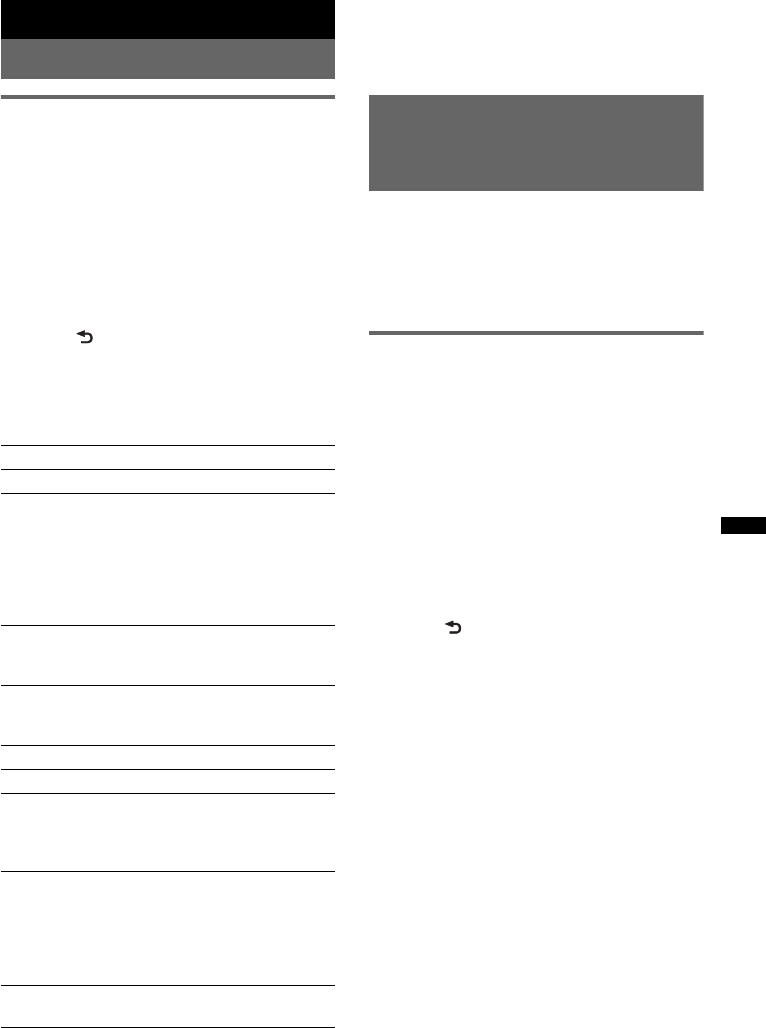
27
Sound Settings and Setup Menu
Changing the sound settings
Adjusting the sound
characteristics
1During reception/playback, press the
select button.
2Rotate the control dial until the
desired menu item appears, then
press it.
3Rotate the control dial to select the
setting, then press it.
The setting is complete.
4Press (BACK).
The display returns to normal reception/play
mode.
The following items can be set (follow the page
reference for details):
Enjoying sophisticated sound
functions — Advanced Sound
Engine
Advanced Sound Engine, Sony’s new sound
engine, creates an ideal in-car sound field with
digital signal processing. Advanced Sound
Engine contains the following features: EQ7,
Listening Position, DM+ Advanced, Rear Bass
Enhancer.
Selecting the sound quality
— EQ7 Preset
You can select an equalizer curve from 7
equalizer curves (“XPLOD,” “VOCAL,”
“EDGE,” “CRUISE,” “SPACE,” “GRAVITY,”
“CUSTOM” or “OFF”).
1During reception/playback, press the
select button.
2Rotate the control dial until “EQ7
PRESET” appears, then press it.
3Rotate the control dial until the
desired equalizer curve appears, then
press it.
4Press (BACK).
The display returns to normal reception/play
mode.
To cancel the equalizer curve, select “OFF” in
step 3.
Tip
The equalizer curve setting can be memorized for
each source.
EQ7 PRESET (page 27)
EQ7 SETTING (page 28)
POSITION
SET POSITION (Listening Position setting)
(page 28)
ADJ POSITION*1 (Listening Position
adjustment) (page 29)
SET SW POS*1 (Subwoofer Position setting)
(page 28)
BALANCE
Adjusts the sound balance: “RIGHT-15” –
“CENTER” – “LEFT-15.”
FADER
Adjusts the relative level: “FRONT-15” –
“CENTER” – “REAR-15.”
DM+ (page 29)
RB ENH (Rear Bass Enhancer) (page 29)
SW LEVEL (Subwoofer Level)
Adjusts the subwoofer volume level: “+10dB” –
“0dB” – “–10dB.”
(“ATT” is displayed at the lowest setting.)
AUX VOL*2 (AUX Volume level)
Adjusts the volume level for each connected
auxiliary equipment: “+18dB” – “0dB” –
“– 8dB.”
This setting negates the need to adjust the
volume level between sources.
BTA VOL*3 (Bluetooth Audio Volume Level)
(page 26)
*1 Hidden when “SET POSITION” is set to “OFF.”
*2 When AUX source is activated (page 30).
*3 When Bluetooth audio source is activated
(page 26).
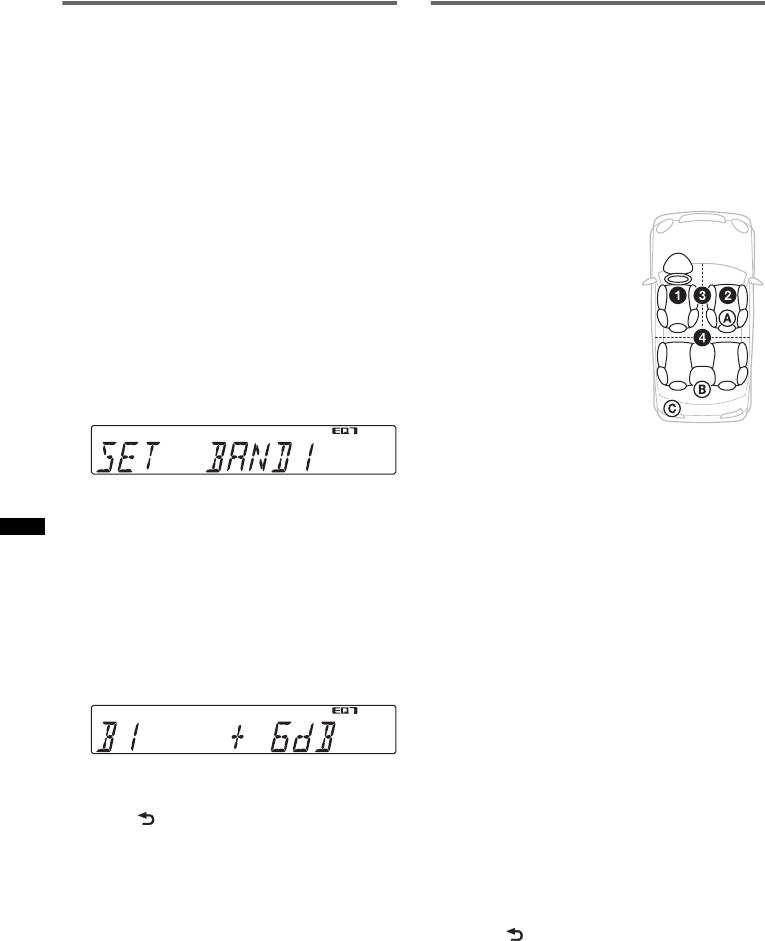
28
Customizing the equalizer curve
— EQ7 Setting
“CUSTOM” of EQ7 allows you to make your
own equalizer settings.
1Select a source, then press the select
button.
2Rotate the control dial until “EQ7
SETTING” appears, then press it.
3Rotate the control dial until “BASE”
appears, then press it.
You can select an equalizer curve as a basis
for further customizing.
To not customize a preset equalizer curve,
skip to step 5.
4Rotate the control dial to select the
equalizer curve, then press it.
5Setting the equalizer curve.
1Rotate the control dial to select the
frequency range, then press it.
BAND1: 63 Hz
BAND2: 160 Hz
BAND3: 400 Hz
BAND4: 1 kHz
BAND5: 2.5 kHz
BAND6: 6.3 kHz
BAND7: 16.0 kHz
2Rotate the control dial to adjust the
volume level, then press it.
The volume level is adjustable in 1 dB
steps, from -6 dB to +6 dB.
Repeat steps 1 and 2 to adjust other
frequency ranges.
6Press (BACK) twice.
The equalizer curve is stored in “CUSTOM,”
and the display returns to normal reception/
play mode.
Optimizing sound by Time
Alignment — Listening Position
The unit can change the localization of sound by
delaying the sound output from each speaker to
suit your position, and simulate a natural sound
field with the feeling of being in the center of it
wherever you sit in the car.
The options for “POSITION” are indicated
below.
You can also set the approximate subwoofer
position from your listening position if:
– the subwoofer is connected.
– the listening position is set besides “OFF.”
The options for “SET SW POS” are indicated
below.
“NEAR” (A): Near
“NORMAL” (B): Normal
“FAR” (C): Far
1During reception/playback, press the
select button.
2Rotate the control dial until “SET
POSITION” appears, then press it.
3Rotate the control dial to select from
“FRONT L,” “FRONT R,” “FRONT” or
“ALL,” then press it.
4Rotate the control dial until “SET SW
POS” appears, then press it.
If you select “FRONT L,” “FRONT R,”
“FRONT” or “ALL” in step 3 above, you can
set the subwoofer position.
Rotate the control dial to select from
“NEAR,” “NORMAL” or “FAR,” then press
it.
5Press (BACK).
The display returns to normal reception/play
mode.
To cancel listening position, select “OFF” on
step 3.
“FRONT L” (1): Front left
“FRONT R” (2): Front
right
“FRONT” (3): Center front
“ALL” (4): In the center of
your car
“OFF”: No position set
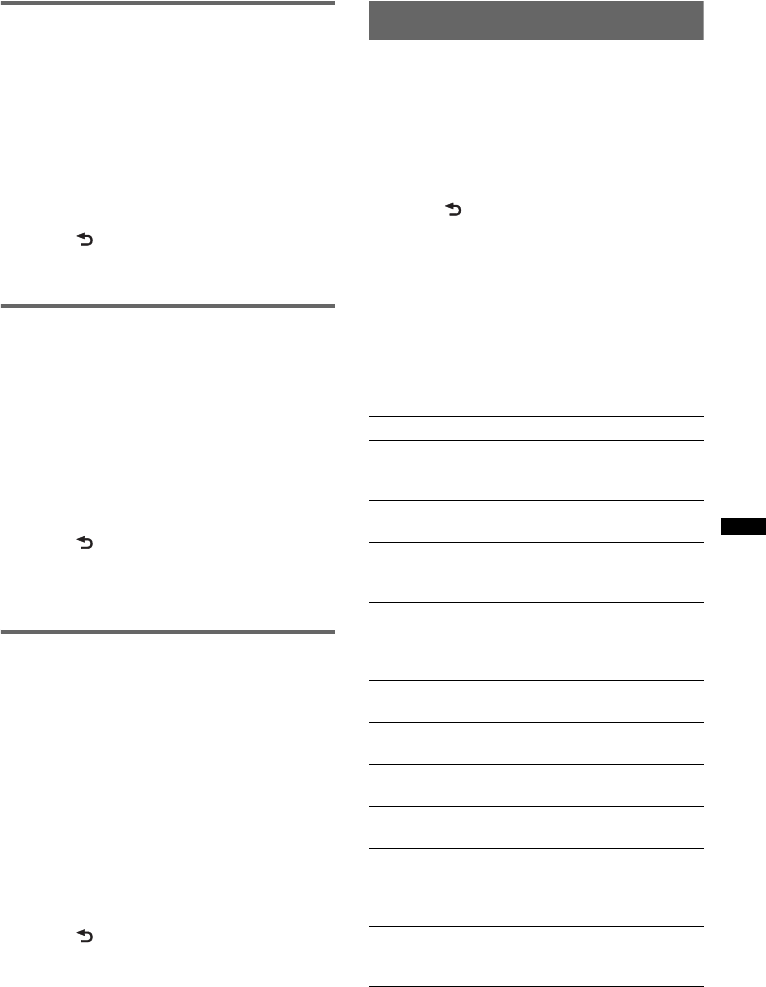
29
Adjusting the listening position
You can fine-tune the listening position setting.
1During reception/playback, press the
select button.
2Rotate the control dial until “ADJ
POSITION” appears, then press it.
3Rotate the control dial to adjust the
listening position, then press it.
Adjustable range: “+ 3” – “CENTER” –
“– 3.”
4Press (BACK).
The display returns to normal reception/play
mode.
DM+ Advanced
DM+ Advanced improves digitally compressed
sound by restoring high frequencies lost in the
compression process.
1During playback, press the select
button.
2Rotate the control dial until “DM+”
appears, then press it.
3Rotate the control dial to select “ON,”
then press it.
4Press (BACK).
The display returns to normal play mode.
Tip
The DM+ setting can be memorized for each source.
Using rear speakers as subwoofer
— Rear Bass Enhancer
Rear Bass Enhancer enhances the bass sound by
applying the low pass filter setting (page 30) to
the rear speakers. This function allows the rear
speakers to work as a subwoofer if one is not
connected.
1During reception/playback, press the
select button.
2Rotate the control dial until “RB ENH”
appears, then press it.
3Rotate the control dial to select from
“1,” “2” or “3,” then press it.
4Press (BACK).
The display returns to normal reception/play
mode.
Adjusting setup items — SET
1Press and hold the select button.
The setup display appears.
2Rotate the control dial until the
desired item appears, then press it.
3Rotate the control dial to select the
setting, then press it.*
The setting is complete.
4Press (BACK).
The display returns to normal reception/play
mode.
*For CLOCK-ADJ and BTM settings, step 4 is not
necessary.
Note
Displayed items will differ, depending on the source
and setting.
The following items can be set (follow the page
reference for details):
CLOCK-ADJ (Clock Adjust) (page 7)
CT (Clock Time)
Activates the CT function: “ON,” “OFF”
(page 15, 16).
BEEP
Activates the beep sound: “ON,” “OFF.”
AUX-A*1 (AUX Audio)
Activates the AUX source display: “ON,”
“OFF” (page 30).
AUTO OFF
Shuts off automatically after a desired time
when the unit is turned off: “NO,” “30S
(Seconds),” “30M (Minutes),” “60M (Minutes).”
DEMO
(Demonstration)
Activates the demonstration: “ON,” “OFF.”
DIMMER
Changes the display brightness: “ON,” “OFF.”
ILLUM (Illumination)
Changes the illumination color: “1,” “2.”
AUTO SCR (Auto Scroll)
Scrolls long items automatically: “ON,” “OFF.”
LOCAL (Local Seek Mode)
– “ON”: to only tune into stations with stronger
signals.
– “OFF”: to tune normal reception.
MONO*2 (Monaural Mode)
Selects monaural reception mode to improve
poor FM reception: “ON,” “OFF.”
continue to next page t
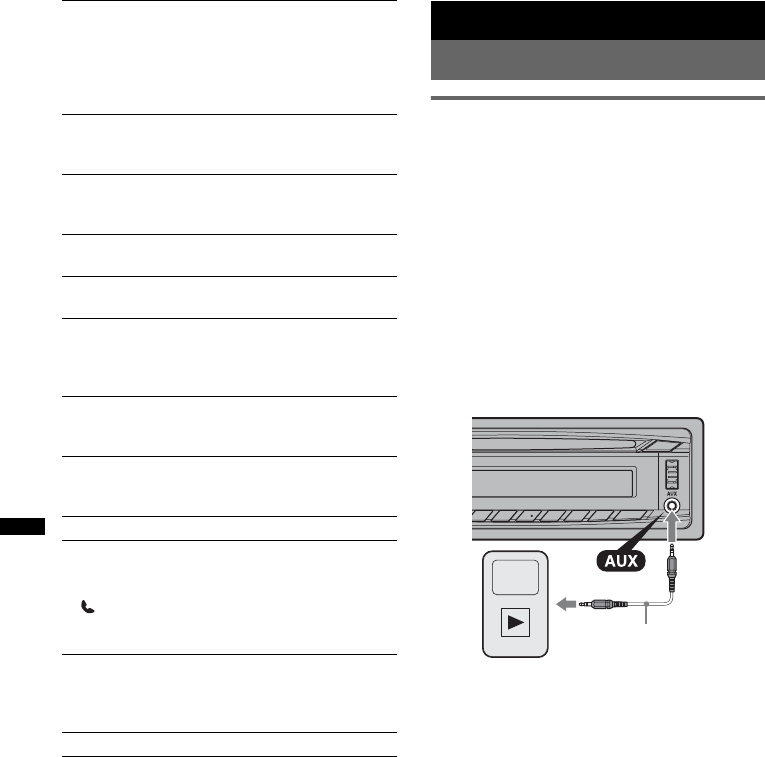
30
*1 When the unit is turned off.
*2 When FM is received.
Other functions
Using optional equipment
Auxiliary audio equipment
By connecting an optional portable audio device
to the AUX input jack (stereo mini jack) on the
unit and then simply selecting the source, you
can listen on your car speakers. The volume level
is adjustable for any difference between the unit
and the portable audio device. Follow the
procedure below:
Connecting the portable audio
device
1Turn off the portable audio device.
2Turn down the volume on the unit.
3Connect to the unit.
*Be sure to use a straight type plug.
Adjusting the volume level
Be sure to adjust the volume for each connected
audio device before playback.
1Turn down the volume on the unit.
2Press (SOURCE/OFF) repeatedly until “AUX”
appears.
After that, “AUX FRONT IN” appears.
3Start playback of the portable audio device at a
moderate volume.
4Set your usual listening volume on the unit.
5Adjust the input level (page 27).
ZAP TIME (Zappin Time)
Selects the playback time for the ZAPPIN
function.
– “Z.TIME-1 (about 6 seconds),” “Z.TIME-2
(about 15 seconds),” “Z.TIME-3 (about 30
seconds).”
ZAP BEEP (Zappin Beep)
Has the beep sound between track passages:
“ON,” “OFF.”
LPF FREQ (Low Pass Filter Frequency)
Selects the subwoofer cut-off frequency:
“50Hz,” “60Hz,” “80Hz,” “100Hz,” “120Hz.”
LPF SLOP (Low Pass Filter Slope)
Selects the LPF slope: ”1,” ”2,” ”3.”
SW PHASE (Subwoofer Phase)
Selects the subwoofer phase: “NORM,” “REV.”
HPF FREQ (High Pass Filter Frequency)
Selects the front/rear speaker cut-off frequency:
“OFF,” “50Hz,” “60Hz,” “80Hz,” “100Hz,”
“120Hz.”
HPF SLOP (High Pass Filter Slope)
Selects the HPF slope (effective only when HPF
FREQ is set to other than “OFF”): “1,” “2,” “3.”
LOUDNESS (Dynamic Loudness)
Reinforces bass and treble for clear sound at low
volume levels: “ON,” “OFF.”
BTM (page 15)
AUTO ANS*1 (Auto Answer)
Answers an incoming call automatically.
– “OFF”: to not answer automatically until
(handsfree) is pressed.
– “1”: to answer automatically after 3 seconds.
– “2”: to answer automatically after 10 seconds.
RINGTONE*1
Uses the ringtone of this unit or the connected
cellular phone: “1 (this unit),” “2 (cellular
phone).”
BT INIT*1 (Bluetooth Initialize) (page 26)
Connecting cord*
(not supplied)
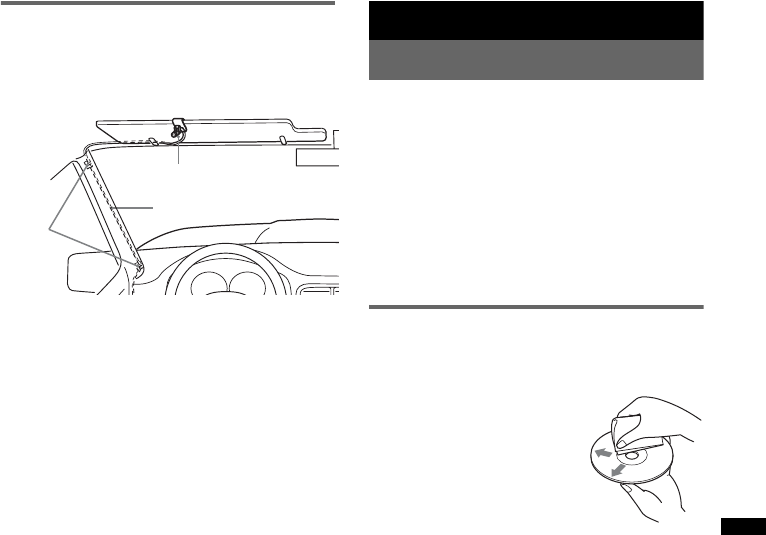
31
External microphone XA-MC10
By connecting an optional external microphone
to the microphone input connector, you can
improve audio quality while talking through this
unit.
Note
Connect XA-MC10 as the external microphone. You
may not be able to call or malfunction may occur if
another device is connected.
Additional Information
Precautions
• Cool off the unit beforehand if your car has been
parked in direct sunlight.
• Power antenna (aerial) extends automatically.
Moisture condensation
Should moisture condensation occur inside the unit,
remove the disc and wait for about an hour for it to
dry out; otherwise the unit will not operate properly.
To maintain high sound quality
Do not splash liquid onto the unit or discs.
Notes on discs
• Do not expose discs to direct sunlight or heat
sources such as hot air ducts, nor leave it in a car
parked in direct sunlight.
• Before playing, wipe the discs
with a cleaning cloth from the
center out. Do not use solvents
such as benzine, thinner,
commercially available
cleaners.
• This unit is designed to play
discs that conform to the
Compact Disc (CD) standard.
DualDiscs and some of the music discs encoded
with copyright protection technologies do not
conform to the Compact Disc (CD) standard,
therefore, these discs may not be playable by this
unit.
•Discs that this unit CANNOT play
– Discs with labels, stickers, or sticky tape or
paper attached. Doing so may cause a
malfunction, or may ruin the disc.
– Discs with non-standard shapes (e.g., heart,
square, star). Attempting to do so may damage
the unit.
–8 cm (3 1/4 in) discs.
Notes on CD-R/CD-RW discs
• The maximum number of: (CD-R/CD-RW only)
– folders (albums): 150 (including root folder)
– files (tracks) and folders: 300 (may less than 300
if folder/file names contain many characters)
– displayable characters for a folder/file name: 32
(Joliet)/64 (Romeo)
• If the multi-session disc begins with a CD-DA
session, it is recognized as a CD-DA disc, and
other sessions are not played.
External microphone
Connecting cord
Clamps
continue to next page t
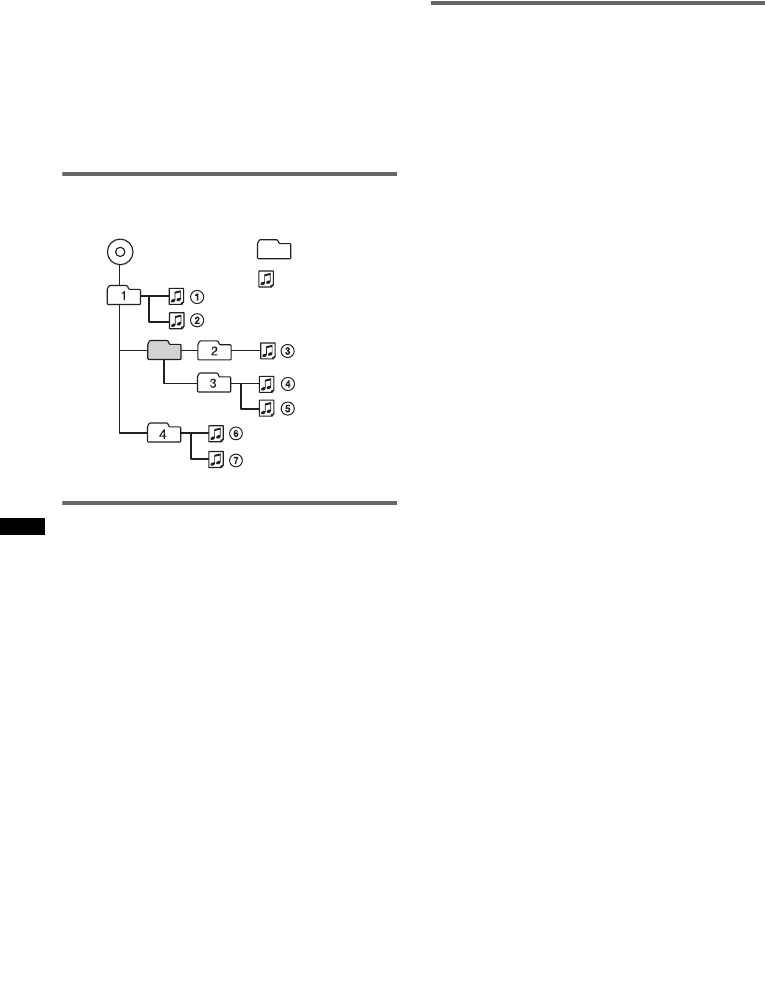
32
•Discs that this unit CANNOT play
– CD-R/CD-RW of poor recording quality.
– CD-R/CD-RW recorded with an incompatible
recording device.
– CD-R/CD-RW which is finalized incorrectly.
– CD-R/CD-RW other than those recorded in
music CD format or MP3 format conforming to
ISO9660 Level 1/Level 2, Joliet/Romeo or
multi-session.
Playback order of MP3/WMA/AAC
files
About iPod
About Bluetooth function
What is Bluetooth technology?
• Bluetooth wireless technology is a short-range
wireless technology that enables wireless data
communication between digital devices, such as a
cellular phone and a headset. Bluetooth wireless
technology operates within a range of about 10 m
(about 33 feet). Connecting two devices is
common, but some devices can be connected to
multiple devices at the same time.
• You do not need to use a cable for connection
since Bluetooth technology is a wireless
technology, neither is it necessary for the devices
to face one another, such is the case with infrared
technology. For example, you can use such a
device in a bag or pocket.
• Bluetooth technology is an international standard
supported by millions of companies all over the
world, and employed by various companies
worldwide.
On Bluetooth communication
• Bluetooth wireless technology operates within a
range of about 10 m.
Maximum communication range may vary
depending on obstacles (person, metal, wall, etc.)
or electromagnetic environment.
• The following conditions may affect the
sensitivity of Bluetooth communication.
– There is an obstacle such as a person, metal, or
wall between this unit and Bluetooth device.
– A device using 2.4 GHz frequency, such as a
wireless LAN device, cordless telephone, or
microwave oven, is in use near this unit.
• Because Bluetooth devices and wireless LAN
(IEEE802.11b/g) use the same frequency,
microwave interference may occur and result in
communication speed deterioration, noise, or
invalid connection if this unit is used near a
wireless LAN device. In such as case, perform the
following.
– Use this unit at least 10 m away from the
wireless LAN device.
– If this unit is used within 10 m of a wireless
LAN device, turn off the wireless LAN device.
– Install this unit and Bluetooth device as near to
each other as possible.
• Microwaves emitting from a Bluetooth device may
affect the operation of electronic medical devices.
Turn off this unit and other Bluetooth devices in
the following locations, as it may cause an
accident.
– where inflammable gas is present, in a hospital,
train, airplane, or petrol station
– near automatic doors or a fire alarm
• This unit supports security capabilities that
comply with the Bluetooth standard to provide a
secure connection when the Bluetooth wireless
technology is used, but security may not be
enough depending on the setting. Be careful when
communicating using Bluetooth wireless
technology.
Folder
(album)
MP3/WMA/
AAC file
(track)
MP3/WMA/AAC
• You can connect to the following iPod models.
Update your iPod devices to the latest software
before use.
Made for
– iPod touch (2nd generation)
– iPod touch (1st generation)
– iPod classic
– iPod with video*
– iPod nano (5th generation)
– iPod nano (4th generation)
– iPod nano (3rd generation)
– iPod nano (2nd generation)
– iPod nano (1st generation)*
– iPhone 3GS
– iPhone 3G
– iPhone
* Passenger control is not available for iPod nano
(1st generation) or iPod with video.
• “Made for iPod” and “Made for iPhone” mean
that an electronic accessory has been designed to
connect specifically to iPod or iPhone
respectively, and has been certified by the
developer to meet Apple performance standards.
• Apple is not responsible for the operation of this
device or its compliance with safety and
regulatory standards.
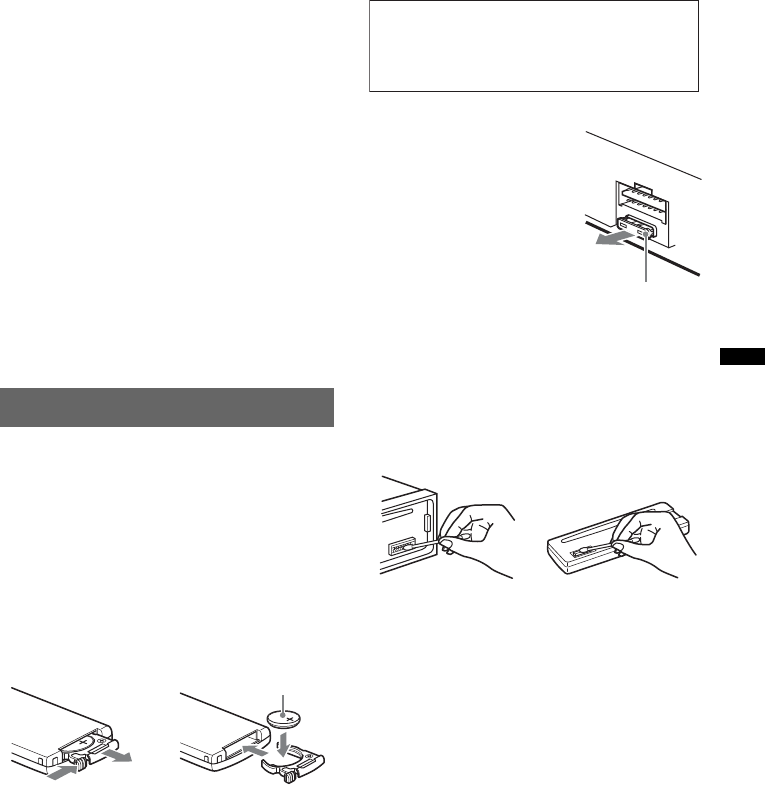
33
• We do not take any responsibility for the leakage
of information during Bluetooth communication.
• Connection with all Bluetooth devices cannot be
guaranteed.
– A device featuring Bluetooth function is
required to conform to the Bluetooth standard
specified by Bluetooth SIG, and be
authenticated.
– Even if the connected device conforms to the
above mentioned Bluetooth standard, some
devices may not be connected or work correctly,
depending on the features or specifications of the
device.
– While talking on the phone hands free, noise
may occur, depending on the device or
communication environment.
• Depending on the device to be connected, it may
require some time to start communication.
Others
• Using the Bluetooth device may not function on
cellular phones, depending on radio wave
conditions and location where the equipment is
being used.
• If you experience discomfort after using the
Bluetooth device, stop using the Bluetooth device
immediately. Should any problem persist, consult
your nearest Sony dealer.
If you have any questions or problems concerning
your unit that are not covered in this manual, consult
your nearest Sony dealer.
Maintenance
Replacing the lithium battery of the
card remote commander
Under normal conditions, the battery will last
approximately 1 year. (The service life may be
shorter, depending on the conditions of use.)
When the battery becomes weak, the range of the
card remote commander becomes shorter.
Replace the battery with a new CR2025 lithium
battery. Use of any other battery may present a
risk of fire or explosion.
Notes on the lithium battery
•Keep the lithium battery out of the reach of children.
Should the battery be swallowed, immediately
consult a doctor.
•Wipe the battery with a dry cloth to assure a good
contact.
•Be sure to observe the correct polarity when
installing the battery.
•Do not hold the battery with metallic tweezers,
otherwise a short-circuit may occur.
Fuse replacement
When replacing the fuse, be
sure to use one matching the
amperage rating stated on the
original fuse. If the fuse blows,
check the power connection and
replace the fuse. If the fuse
blows again after replacement,
there may be an internal
malfunction. In such a case,
consult your nearest Sony
dealer.
Cleaning the connectors
The unit may not function properly if the connectors
between the unit and the front panel are not clean. In
order to prevent this, detach the front panel (page 7)
and clean the connectors with a cotton swab. Do not
apply too much force. Otherwise, the connectors
may be damaged.
Notes
•For safety, turn off the ignition before cleaning the
connectors, and remove the key from the ignition
switch.
•Never touch the connectors directly with your fingers
or with any metal device.
1
2
+ side up
c
WARNING
Battery may explode if mistreated.
Do not recharge, disassemble, or dispose of
in fire.
Fuse (10 A)
Main unit Back of the front
panel
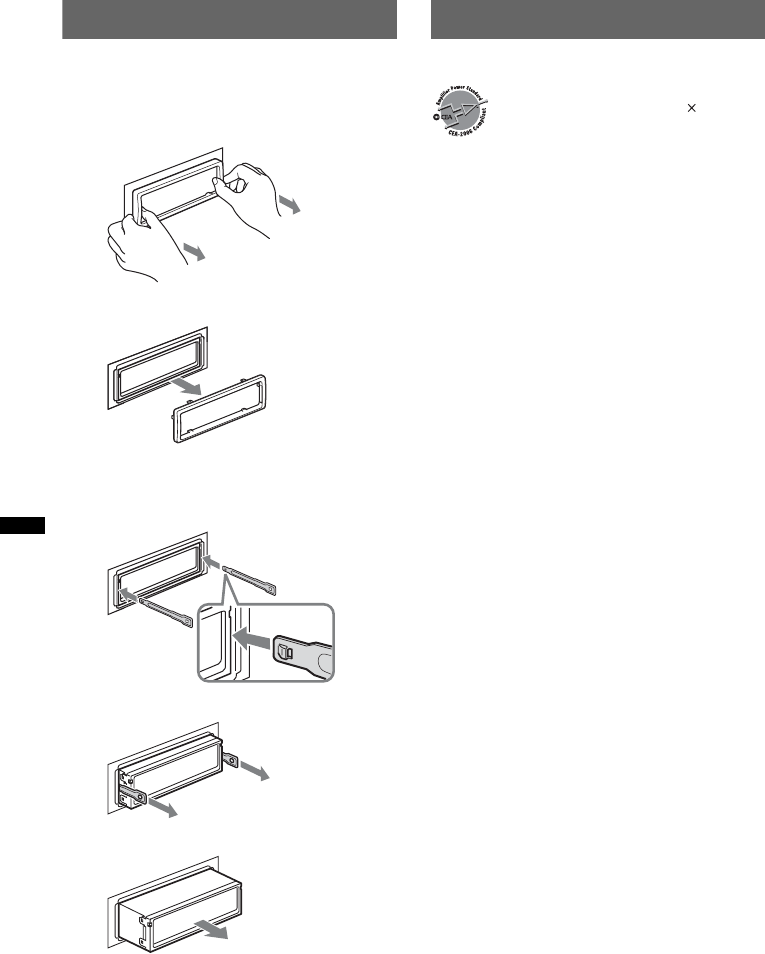
34
Removing the unit
1Remove the protection collar.
1Detach the front panel (page 7).
2Pinch both edges of the protection collar,
then pull it out.
2Remove the unit.
1Insert both release keys simultaneously
until they click.
2Pull the release keys to unseat the unit.
3Slide the unit out of the mounting.
Specifications
Tuner section
FM
Tuning range: 87.5 – 107.9 MHz
Antenna (aerial) terminal:
External antenna (aerial) connector
Intermediate frequency: 150 kHz
Usable sensitivity: 10 dBf
Selectivity: 75 dB at 400 kHz
Signal-to-noise ratio: 70 dB (mono)
Separation: 40 dB at 1 kHz
Frequency response: 20 – 15,000 Hz
AM
Tuning range: 530 – 1,710 kHz
Antenna (aerial) terminal:
External antenna (aerial) connector
Intermediate frequency: 25 kHz
Sensitivity: 26 µV
CD Player section
Signal-to-noise ratio: 120 dB
Frequency response: 10 – 20,000 Hz
Wow and flutter: Below measurable limit
USB Player section
Interface: USB (Full-speed)
Maximum current: 500 mA
Wireless Communication
Communication System:
Bluetooth Standard version 2.1 + EDR
Output:
Bluetooth Standard Power Class 2 (Max. +4 dBm)
Maximum communication range:
Line of sight approx. 10 m (33 ft)*1
Frequency band:
2.4 GHz band (2.4000 – 2.4835 GHz)
Modulation method: FHSS
Compatible Bluetooth Profiles*2:
A2DP (Advanced Audio Distribution Profile) 1.2
AVRCP (Audio Video Remote Control Profile) 1.3
HFP (Handsfree Profile) 1.5
PBAP (Phone Book Access Profile)
OPP (Object Push Profile)
*1 The actual range will vary depending on factors
such as obstacles between devices, magnetic
fields around a microwave oven, static electricity,
reception sensitivity, antenna’s performance,
operating system, software application, etc.
*2 Bluetooth standard profiles indicate the purpose of
Bluetooth communication between devices.
x
Hook facing
inwards.
CEA2006 Standard
Power Output: 17 Watts RMS
4 Ohms < 1% THD+N
SN Ratio: 80 dBA
(reference: 1 Watt into 4 Ohms)
AUDIO POWER SPECIFICATIONS
4 at

35
Power amplifier section
Output: Speaker outputs
Speaker impedance: 4 – 8 ohms
Maximum power output: 52 W × 4 (at 4 ohms)
General
Outputs:
Audio outputs terminal (front/rear)
Subwoofer output terminal (mono)
Power antenna (aerial) relay control terminal
Power amplifier control terminal
Inputs:
BUS control input terminal
BUS audio input terminal
Telephone ATT control terminal
Remote controller input terminal
Antenna (aerial) input terminal
MIC input terminal
AUX input jack (stereo mini jack)
USB signal input connector
Power requirements: 12 V DC car battery
(negative ground (earth))
Dimensions: Approx. 178 × 50 × 179 mm
(7 1/8 × 2 × 7 1/8 in) (w/h/d)
Mounting dimensions: Approx. 182 × 53 × 162 mm
(7 1/4 × 2 1/8 × 6 1/2 in) (w/h/d)
Mass: Approx. 1.2 kg (2 lb 11 oz)
Supplied accessories:
Card remote commander: RM-X172
Parts for installation and connections (1 set)
Optional accessories/equipment:
BUS cable (supplied with an RCA pin cord):
RC-61 (1 m), RC-62 (2 m)
USB connection cable for iPod: RC-100IP
HD Radio™ tuner: XT-100HD
External microphone: XA-MC10
Your dealer may not handle some of the above listed
accessories. Please ask the dealer for detailed
information.
Design and specifications are subject to change
without notice.
Troubleshooting
The following checklist will help you remedy
problems you may encounter with your unit.
Before going through the checklist below, check the
connection and operating procedures.
If the problem is not solved, visit the following
support site.
General
No power is being supplied to the unit.
• Check the connection or fuse.
• If the unit is turned off and the display disappears, it
cannot be operated with the remote commander.
tTurn on the unit.
The power antenna (aerial) does not extend.
The power antenna (aerial) does not have a relay box.
No sound.
• The ATT function is activated, or the Telephone ATT
function (when the interface cable of a car telephone
is connected to the ATT lead) is activated.
• The position of the fader control “FADER” is not set
for a 2-speaker system.
• The Bluetooth audio device is in pause.
tCancel pause.
No beep sound.
• The beep sound is canceled (page 29).
• An optional power amplifier is connected and you are
not using the built-in amplifier.
The contents of the memory have been erased.
• The RESET button has been pressed.
tStore again into the memory.
• The power supply lead or battery has been
disconnected or it is not connected properly.
Stored stations and correct time are erased.
The fuse has blown.
Makes noise when the position of the ignition
is switched.
The leads are not matched correctly with the car’s
accessory power connector.
During playback or reception, demonstration
mode starts.
If no operation is performed for 5 minutes with
“DEMO-ON” set, demonstration mode starts.
tSet “DEMO-OFF” (page 29).
continue to next page t
Support site
http://esupport.sony.com
http://www.sony.com/mobileAV
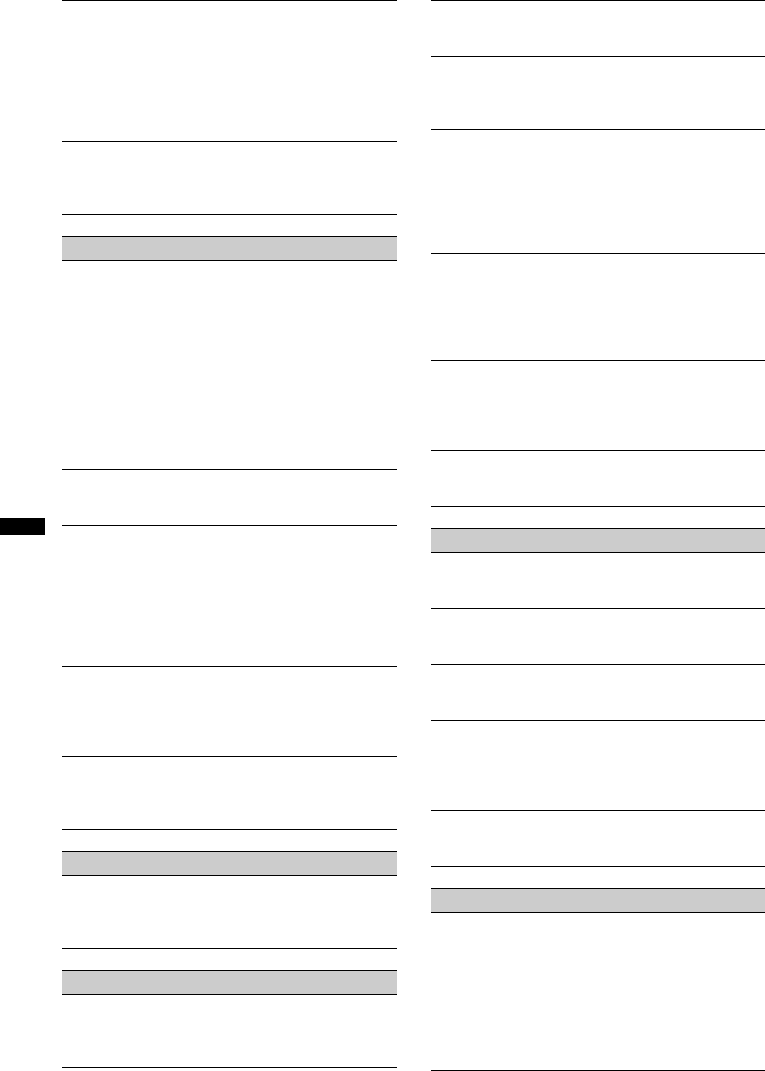
36
The display disappears from/does not appear
in the display window.
• The dimmer is set to “DIM-ON” (page 29).
• The display disappears if you press and hold
(SOURCE/OFF).
tPress (SOURCE/OFF) on the unit until the
display appears.
• The connectors are dirty (page 33).
The Auto Off function does not operate.
The unit is turned on. The Auto Off function activates
after turning off the unit.
tTurn off the unit.
Radio reception
The stations cannot be received.
The sound is hampered by noises.
• The connection is not correct.
tConnect a power antenna (aerial) control lead
(blue) or accessory power supply lead (red) to the
power supply lead of a car’s antenna (aerial)
booster (only when your car has built-in FM/AM
antenna (aerial) in the rear/side glass).
tCheck the connection of the car antenna (aerial).
tIf the auto antenna (aerial) will not go up, check
the connection of the power antenna (aerial)
control lead.
Preset tuning is not possible.
• Store the correct frequency in the memory.
• The broadcast signal is too weak.
Automatic tuning is not possible.
• Setting of the local seek mode is not correct.
tTuning stops too frequently:
Set “LOCAL-ON” (page 29).
tTuning does not stop at a station:
Set “LOCAL-OFF” (page 29).
• The broadcast signal is too weak.
tPerform manual tuning.
During FM reception, the “ST” indication
flashes.
• Tune in the frequency accurately.
• The broadcast signal is too weak.
tSet “MONO-ON” (page 29).
An FM program broadcast in stereo is heard in
monaural.
The unit is in monaural reception mode.
tSet “MONO-OFF” (page 29).
RDS
PTY displays “- - - - - - - -.”
• The current station is not an RDS station.
• RDS data has not been received.
• The station does not specify the program type.
CD playback
The disc cannot be loaded.
• Another disc is already loaded.
• The disc has been forcibly inserted upside down or in
the wrong way.
The disc does not play.
• Defective or dirty disc.
• The CD-Rs/CD-RWs are not for audio use (page 31).
MP3/WMA/AAC files cannot be played.
The disc is incompatible with the MP3/WMA/AAC
format and version. For details on playable discs and
formats, visit the support site.
MP3/WMA/AAC files take longer to play than
others.
The following discs take a longer time to start
playback.
– a disc recorded with a complicated tree structure.
– a disc recorded in Multi Session.
– a disc to which data can be added.
The display items do not scroll.
• For discs with very many characters, those may not
scroll.
• “AUTO SCR” is set to “OFF.”
tSet “A.SCRL-ON” (page 29).
tPress and hold (DSPL) (SCRL).
The sound skips.
• Installation is not correct.
tInstall the unit at an angle of less than 45° in a
sturdy part of the car.
• Defective or dirty disc.
The operation buttons do not function.
The disc will not eject.
Press the RESET button (page 6).
USB playback
You cannot play items via a USB hub.
This unit cannot recognize USB devices via a USB
hub.
Cannot play items.
A USB device does not work.
tReconnect it.
The USB device takes longer to play.
The USB device contains files with a complicated tree
structure.
A beep sounds.
During playback, the USB device has been
disconnected.
tBefore disconnecting a USB device, make sure to
stop playback first for data protection.
The sound is intermittent.
The sound may be intermittent at a high-bit-rate of
more than 320 kbps.
Bluetooth function
The connecting device cannot detect this unit.
• Before the pairing is made, set this unit to pairing
standby mode.
• While connected to a Bluetooth device, this unit
cannot be detected from another device. Disconnect
the current connection and search for this unit from
another device.
• When the device pairing is made, set the Bluetooth
signal output to on (page 23).
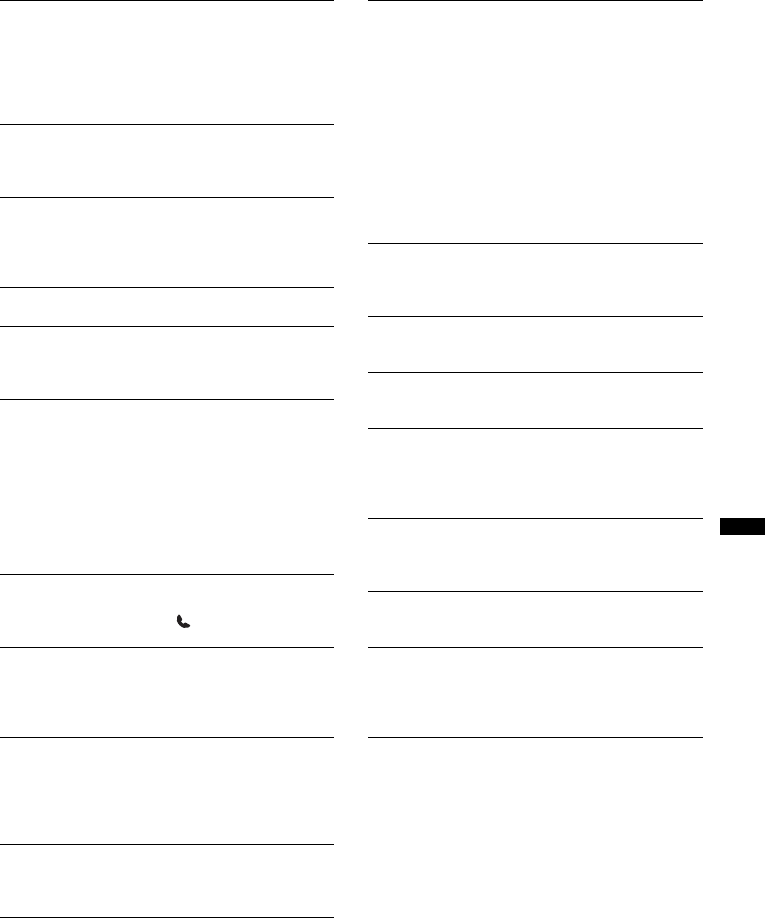
37
Connection is not possible.
• Connect to this unit from a Bluetooth device or vice
versa. The connection is controlled from one side
(this unit or Bluetooth device), but not both.
• Check the pairing and connection procedures in the
manual of the other device, etc., and perform the
operation again.
The name of the detected device does not
appear.
Depending on the status of the other device, it may not
be possible to obtain the name.
No ringtone.
• Adjust the volume in “VOL RING” level.
• Depending on the connecting device, the ringtone
may not be sent properly.
tSet “RINGTONE” to “R.TONE-1” (page 24).
The talker’s voice volume is low.
Adjust the volume level.
A call partner says that the volume is too low
or high.
Adjust the volume accordingly using Mic Gain
adjustment (page 25).
Echo or noise occurs in phone call
conversations.
• Lower the volume.
• Set EC/NC Mode to “EC/NC-1” or “EC/NC-2”
(page 25).
• If the ambient noise other than the phone call sound
is loud, try reducing this noise.
E.g.: If a window is open and road noise, etc., is loud,
shut the window. If the air conditioner is loud, lower
the air conditioner.
The phone is not connected.
When Bluetooth audio is played, the phone is not
connected even if you press (handsfree).
tConnect from the phone.
The phone sound quality is poor.
Phone sound quality depends on reception conditions
of cellular phone.
tMove your car to a place where you can enhance
the cellular phone’s signal if the reception is poor.
The volume of the connected audio device is
low (high).
Volume level will differ depending on the audio
device.
tAdjust the volume of the connected audio device or
this unit.
No sound is heard from the Bluetooth audio
device.
The audio device is paused.
tCancel pause of the audio device.
The sound skips during playback of a
Bluetooth audio device.
• Reduce the distance between the unit and the
Bluetooth audio device.
• If the Bluetooth audio device is stored in a case
which interrupts the signal, remove the audio device
from the case while using.
• Several Bluetooth devices or other devices which
emit radio waves are used nearby.
tTurn off the other devices.
tIncrease the distance from the other devices.
• The playback sound stops momentarily when the
connection between this unit and the cellular phone is
being made. This is not a malfunction.
The connected Bluetooth audio device cannot
be controlled.
Check that the connected Bluetooth audio device
supports AVRCP.
Some functions do not work.
Check if the connecting device supports the functions
in question.
The name of the other party does not appear
when a call is received.
The calling phone is not set to send the phone number.
A call is answered unintentionally.
• The connecting phone is set to answer a call
automatically.
• “AUTO ANS” of this unit is set to “A.ANS-1” or
“A.ANS-2” (page 24).
Pairing failed due to time out.
Depending on the connecting device, the time limit for
pairing may be short. Try completing the pairing
within the time.
Bluetooth function cannot operate.
Turn off the unit by pressing (SOURCE/OFF) for more
than 2 seconds, then turn the unit on again.
No sound is output from the car speakers
during handsfree call.
If the sound is output from the cellular phone, set the
cellular phone to output the sound from the car
speakers.
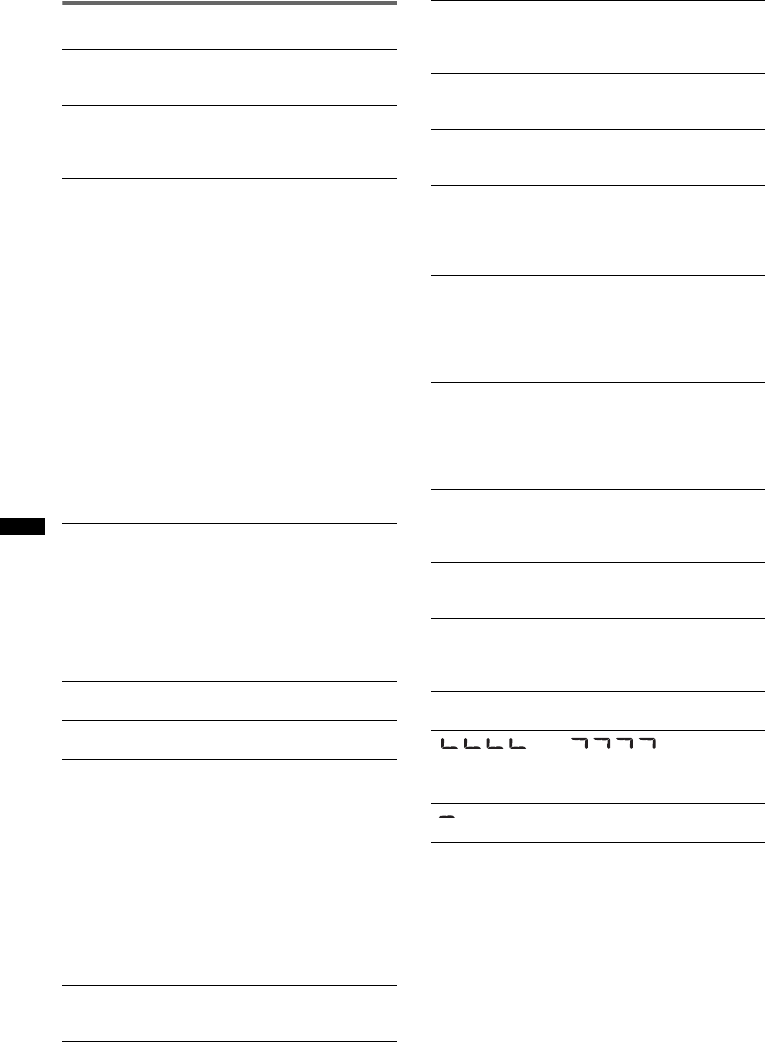
38
Error displays/Messages
If these solutions do not help improve the situation,
consult your nearest Sony dealer.
If you take the unit to be repaired because of CD
playback trouble, bring the disc that was used at the
time the problem began.
CHECKING
The unit is confirming the connection of a USB device.
tWait until confirming the connection is finished.
EMPTY
• The call history is empty.
• The phonebook is empty.
• The preset dial is empty.
ERROR
• The disc is dirty or inserted upside down.
tClean or insert the disc correctly.
• A blank disc has been inserted.
• The disc cannot play due to a problem.
tInsert another disc.
• USB device was not automatically recognized.
tReconnect it again.
• Press Z to remove the disc.
• BT Initialize failed.
• Phonebook access failed.
• Phonebook content was changed while accessing the
cellular phone.
tAccess the phonebook in the cellular phone
again.
• A call was made while the cellular phone was not
connected.
P (preset number) ERROR
A call was made by preset number when no preset
number exists.
FAILURE (Illuminates until any button is pressed.)
The connection of speakers/amplifiers is incorrect.
tSee the installation/connections manual of this
model to check the connection.
FAILURE (Illuminates for about 1 second.)
When the SAT tuner is connected, storing an SAT
radio channel into a preset failed.
tBe sure to receive the channel that you want to
store, then try it again.
HUB NO SUPRT (HUBs Not Support)
USB hub is not supported on this unit.
L. SEEK +/–
The local seek mode is on during automatic tuning.
NO DEV (No Device)
• USB is selected as source without a USB device
connected. A USB device or a USB cable has been
disconnected during playback.
tBe sure to connect a USB device and USB cable.
• Bluetooth audio source is selected without a
Bluetooth audio device connected. A Bluetooth audio
device has been disconnected during a call.
tBe sure to connect a Bluetooth audio device.
• Bluetooth phone source is selected without a cellular
phone connected. A cellular phone has been
disconnected during a call.
tBe sure to connect a cellular phone.
NO INFO (No Information)
Network name and cellular phone name are not
received with cellular phone connected.
NO MUSIC
The disc or USB device does not contain a music file.
tInsert a music CD in this unit.
tConnect a USB device with a music file in it.
NO NAME
A disc/album/artist/track name is not written in the
track.
NOT FOUND
There is no item beginning with the selected letter in
Alphabet search.
OFFSET
There may be an internal malfunction.
tCheck the connection. If the error indication
remains on in the display, consult your nearest
Sony dealer.
OVERLOAD
USB device is overloaded.
tDisconnect the USB device, then change the source
by pressing (SOURCE/OFF).
tIndicates that the USB device is out of order, or an
unsupported device is connected.
READ
The unit is reading all track and album information on
the disc.
tWait until reading is complete and playback starts
automatically. Depending on the disc structure, it
may take more than a minute.
RESET
This unit or USB device cannot be operated due to a
problem.
tPress the RESET button (page 6).
UNKNOWN
Name or phone number cannot be displayed when
browsing phonebook or call history.
USB NO SUPRT (USB Not Support)
The connected USB device is not supported.
tFor details on the compatibility of your USB
device, visit the support site.
WITHHELD
Phone number is hidden by caller.
“” or “”
During fast-forward or reverse, you have reached the
beginning or the end of the disc and you cannot go any
further.
“”
The character cannot be displayed with the unit.
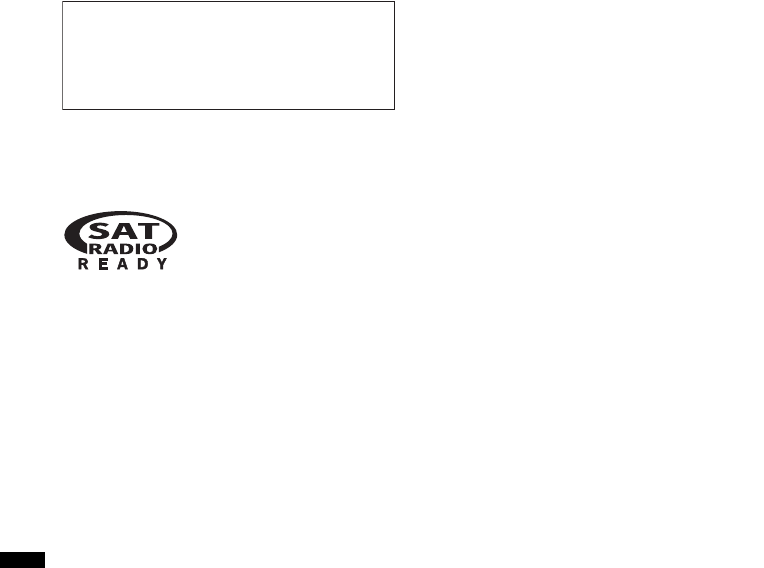
2
Los logotipos y la marca de Bluetooth son
propiedad de Bluetooth SIG, Inc. y cualquier uso
de dichas marcas por parte de Sony Corporation
es bajo licencia. Las demás marcas y marcas
comerciales son aquellas de sus respectivos
propietarios.
ZAPPIN y Quick-BrowZer son marcas
comerciales de Sony Corporation.
Asegúrese de instalar esta unidad en el tablero
del automóvil por razones de seguridad. Para
realizar la instalación y las conexiones,
consulte el manual de instalación y de
conexiones suministrado.
HD RadioTM
es una marca propietaria de
iBiquity Digital Corp.
El logotipo “SAT Radio
Ready” indica que este
producto controla un módulo
de sintonizador de radio por
satélite (se vende por separado). Si desea
obtener más detalles sobre el módulo de
sintonizador de radio por satélite, póngase en
contacto con el distribuidor Sony autorizado
más cercano.
“SAT Radio”, “SAT Radio Ready”, los
logotipos de SAT Radio, SAT Radio Ready y
todas las marcas relacionadas son marcas
comerciales de Sirius XM Radio Inc. y XM
Satellite Radio Inc.
Windows Media es una marca comercial
registrada o una marca comercial de Microsoft
Corporation en los EE. UU. y otros países.
Este producto está protegido por los derechos de
propiedad intelectual de Microsoft Corporation.
Queda prohibido el uso o la distribución de esta
tecnología fuera de este producto si no se dispone
de una licencia de Microsoft o una división
autorizada de Microsoft.
iPhone, iPod, iPod classic, iPod nano, y
iPod touch son marcas comerciales de
Apple Inc., registradas en los Estados Unidos y
otros países.
Tecnología de codificación de audio MPEG
Layer-3 y patentes bajo licencia de Fraunhofer IIS
y Thomson.
Nota sobre la pila de litio
No exponga la pila a fuentes de calor excesivo como
luz solar directa, fuego o similar.

3
Advertencia: si el encendido del
automóvil no dispone de una posición
ACC (accesorios)
Asegúrese de ajustar la función de
desconexión automática (página 31).
La unidad se desconectará completa y
automáticamente en el tiempo establecido
después de apagarla, lo que evita que se agote
la batería.
Si no ajusta la función de desconexión
automática, mantenga presionado
(SOURCE/OFF) hasta que se apague la
pantalla cada vez que apague el motor.

4
Tabla de contenido
Procedimientos iniciales
Discos que se pueden reproducir en
esta unidad. . . . . . . . . . . . . . . . . . . . . . . . . . . . . 6
Notas sobre Bluetooth . . . . . . . . . . . . . . . . . . . . 6
Restauración de la unidad . . . . . . . . . . . . . . . . . 6
Cancelación del modo DEMO. . . . . . . . . . . . . . 7
Preparación del control remoto de tarjeta . . . . . 7
Ajuste del reloj . . . . . . . . . . . . . . . . . . . . . . . . . 7
Extracción del panel frontal. . . . . . . . . . . . . . . . 7
Colocación del panel frontal . . . . . . . . . . . . . 7
Guía rápida del funcionamiento de
Bluetooth
Los 3 pasos necesarios para la función
Bluetooth . . . . . . . . . . . . . . . . . . . . . . . . . . . . . . 8
Botones e iconos . . . . . . . . . . . . . . . . . . . . . . . . 9
1Emparejamiento . . . . . . . . . . . . . . . . . . . . . 10
2Conexión . . . . . . . . . . . . . . . . . . . . . . . . . . 10
3Llamadas con manos libres y transmisión
continua de música. . . . . . . . . . . . . . . . . . . 11
Ubicación de los controles y
operaciones básicas
Unidad principal . . . . . . . . . . . . . . . . . . . . . 12
RM-X172
Control remoto de tarjeta . . . . . . . . . . . . . . 14
Radio
Almacenamiento y recepción de emisoras . . . 15
Almacenamiento automático — BTM . . . . 15
Almacenamiento manual . . . . . . . . . . . . . . 15
Recepción de las emisoras almacenadas. . . 15
Sintonización automática . . . . . . . . . . . . . . 15
RDS . . . . . . . . . . . . . . . . . . . . . . . . . . . . . . . . . 15
Descripción general . . . . . . . . . . . . . . . . . . 15
Selección de PTY . . . . . . . . . . . . . . . . . . . . 16
Ajuste de CT . . . . . . . . . . . . . . . . . . . . . . . . 16
CD
Elementos de la pantalla . . . . . . . . . . . . . . . 16
Reproducción repetida y aleatoria . . . . . . . 16
Dispositivos USB
Reproducción desde un dispositivo USB . . . . 17
Elementos de la pantalla . . . . . . . . . . . . . . . 17
Reproducción repetida y aleatoria . . . . . . . 18
iPod
Reproducción de un iPod . . . . . . . . . . . . . . . . 18
Elementos de la pantalla. . . . . . . . . . . . . . . 19
Omitir álbumes, podcasts, géneros, listas de
reproducción y artistas . . . . . . . . . . . . . . . . 19
Reproducción repetida y aleatoria . . . . . . . 19
Utilización directa del iPod
— Control de pasajero . . . . . . . . . . . . . . . . . . 20
Búsqueda de una pista
Búsqueda de una pista por nombre
— Quick-BrowZer™ . . . . . . . . . . . . . . . . . . . 20
Búsqueda por omisión de elementos
— modo de Omisión . . . . . . . . . . . . . . . . . 20
Búsqueda por orden alfabético
— Búsqueda alfabética . . . . . . . . . . . . . . . 21
Búsqueda de una pista mediante la audición de
pasajes de pistas — ZAPPIN™ . . . . . . . . . . . 21
Bluetooth (Llamada con manos
libres y transmisión continua de
música)
Operaciones del Bluetooth . . . . . . . . . . . . . . . 22
Emparejamiento . . . . . . . . . . . . . . . . . . . . . . . 22
Acerca de los iconos de Bluetooth. . . . . . . 23
Conexión. . . . . . . . . . . . . . . . . . . . . . . . . . . . . 23
Para cambiar la salida de señal Bluetooth de
esta unidad a activada. . . . . . . . . . . . . . . . . 23
Conexión a un teléfono celular . . . . . . . . . 23
Conexión a un dispositivo de audio . . . . . . 24
Llamada con manos libres . . . . . . . . . . . . . . . 24
Recepción de llamadas. . . . . . . . . . . . . . . . 24
Realización de llamadas. . . . . . . . . . . . . . . 24
Operaciones durante una llamada . . . . . . . 25
Transferencia de llamadas . . . . . . . . . . . . . 26
Marcación de números
predeterminados. . . . . . . . . . . . . . . . . . . . . 26
Activación de la marcación por voz. . . . . . 26
Indicador SMS . . . . . . . . . . . . . . . . . . . . . . 26
Transmisión continua de música. . . . . . . . . . . 27
Escuchar música desde un dispositivo
de audio . . . . . . . . . . . . . . . . . . . . . . . . . . . 27
Operación de un dispositivo de audio con esta
unidad. . . . . . . . . . . . . . . . . . . . . . . . . . . . . 27
Inicialización de los ajustes de Bluetooth. . . . 27

5
Ajustes de sonido y Menú de
configuración
Cambio de los ajustes de sonido . . . . . . . . . . . 28
Ajuste de las características de sonido . . . . 28
Uso de funciones de sonido sofisticadas
— Advanced Sound Engine . . . . . . . . . . . . . . 28
Selección de la calidad de sonido
— Preajuste de EQ7 . . . . . . . . . . . . . . . . . . 28
Personalización de la curva de ecualizador
— Ajuste de EQ7 . . . . . . . . . . . . . . . . . . . . 29
Optimización de sonido por Alineación de
tiempo
— Posición de escucha . . . . . . . . . . . . . . . . 29
Ajuste de la posición de escucha . . . . . . . . 30
DM+ Avanzado. . . . . . . . . . . . . . . . . . . . . . 30
Uso de los altavoces posteriores como altavoz
potenciador de graves
— Potenciador de sonidos graves
posteriores. . . . . . . . . . . . . . . . . . . . . . . . . . 30
Definición de los elementos de configuración
— SET. . . . . . . . . . . . . . . . . . . . . . . . . . . . . . . 31
Otras funciones
Uso de equipo opcional. . . . . . . . . . . . . . . . . . 32
Equipo de audio auxiliar . . . . . . . . . . . . . . 32
Micrófono externo XA-MC10 . . . . . . . . . . 32
Información complementaria
Precauciones . . . . . . . . . . . . . . . . . . . . . . . . . . 33
Notas sobre los discos . . . . . . . . . . . . . . . . 33
Orden de reproducción de los archivos MP3/
WMA/AAC . . . . . . . . . . . . . . . . . . . . . . . . 33
Acerca de iPod . . . . . . . . . . . . . . . . . . . . . . 34
Acerca de la función Bluetooth . . . . . . . . . 34
Mantenimiento . . . . . . . . . . . . . . . . . . . . . . . . 35
Extracción de la unidad. . . . . . . . . . . . . . . . . . 36
Especificaciones . . . . . . . . . . . . . . . . . . . . . . . 36
Solución de problemas . . . . . . . . . . . . . . . . . . 37
Mensajes/indicaciones de error . . . . . . . . . 40
Sitio Web de soporte técnico en línea
Para resolver cualquier duda u obtener la información más reciente
sobre el soporte técnico de este producto, visite el siguiente sitio Web:
http://esupport.sony.com
http://www.sony.com/mobileAV
Proporciona información acerca de:
• Modelos y fabricantes de reproductores de audio digital compatibles
• Archivos MP3/WMA/AAC compatibles
• Los modelos y fabricantes de teléfonos celulares compatibles, así como las
respuestas a las preguntas más frecuentes sobre la función Bluetooth
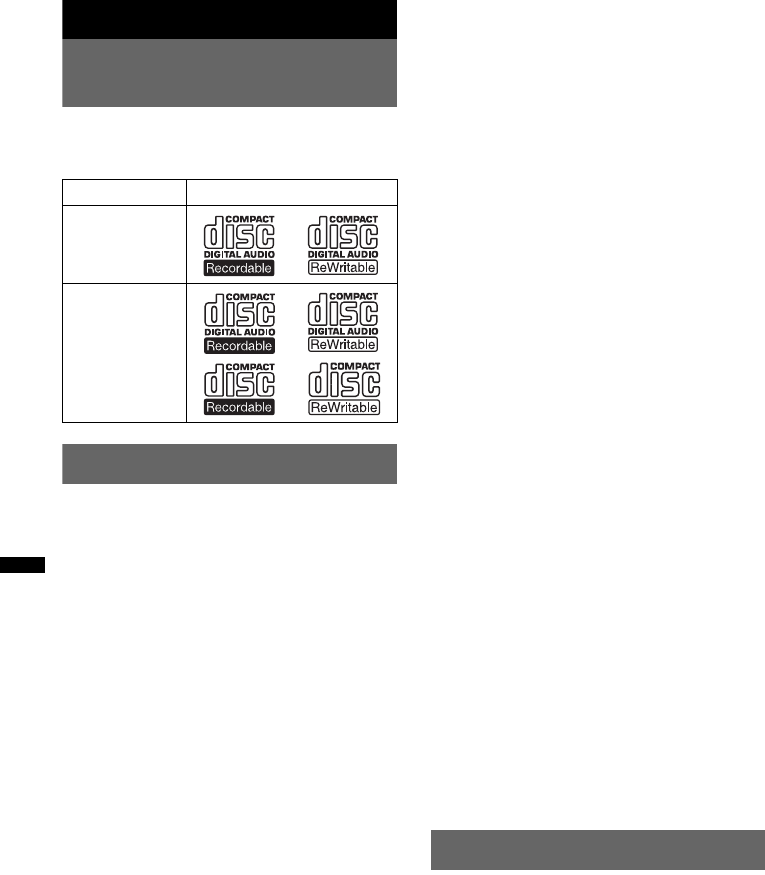
6
Procedimientos iniciales
Discos que se pueden
reproducir en esta unidad
Esta unidad permite reproducir discos CD-DA
(incluidos CD TEXT) y CD-R/CD-RW (archivos
MP3/WMA/AAC (página 33)).
Notas sobre Bluetooth
Precaución
EN NINGÚN CASO SONY SERÁ
RESPONSABLE DE LOS DAÑOS INDIRECTOS,
IMPREVISTOS, DERIVADOS NI DE NINGÚN
OTRO TIPO, INCLUIDOS, SIN LIMITACIÓN,
LOS DAÑOS POR PÉRDIDA DE BENEFICIOS O
INGRESOS, LA PÉRDIDA DE DATOS, LA
PÉRDIDA DE USO DEL PRODUCTO O DE
EQUIPAMIENTO ASOCIADO, TIEMPO DE
INACTIVIDAD Y PÉRDIDA DE TIEMPO DEL
COMPRADOR RELACIONADOS O
DERIVADOS DEL USO DE ESTE PRODUCTO O
DEL HARDWARE Y SOFTWARE DE ÉSTE.
AVISO IMPORTANTE
Uso seguro y eficiente
Los cambios o modificaciones efectuados a esta
unidad no aprobados de manera expresa por Sony
pueden anular la autoridad del usuario para utilizar
el equipo.
Compruebe si existen excepciones debido a
requisitos o limitaciones de ámbito nacional, en el
uso del equipo Bluetooth antes de utilizar este
producto.
Conducción
Consulte las leyes y normativas que regulan el uso
de teléfonos celulares y equipos de manos libres de
las zonas en las que conduzca.
Preste siempre atención a la conducción, abandone
la carretera y aparque el automóvil antes de efectuar
o responder una llamada si así lo requieren las
condiciones de la conducción.
Conexión a otros dispositivos
Cuando efectúe la conexión a otro dispositivo, lea la
guía del usuario correspondiente para obtener
instrucciones de seguridad detalladas.
Exposición a la radiofrecuencia
Es posible que las señales de radiofrecuencia
afecten a sistemas electrónicos instalados o
blindados de manera incorrecta en automóviles,
como sistemas electrónicos de inyección de
combustible, sistemas de frenado electrónico
antiderrape (antibloqueo), sistemas de control de
velocidad electrónicos o sistemas de airbag. Para
obtener información acerca de la instalación o la
reparación de este dispositivo, póngase en contacto
con el fabricante del automóvil o su representante.
Una instalación o reparación defectuosa puede
resultar peligrosa e invalidar cualquier garantía que
se aplique a este dispositivo.
Póngase en contacto con el fabricante del automóvil
para asegurarse de que el uso del teléfono celular en
éste no afectará a su sistema electrónico.
Compruebe regularmente que los equipos
inalámbricos que se utilizan en el automóvil están
instalados y funcionan correctamente.
Llamadas de emergencia
Este dispositivo de manos libres Bluetooth para
automóvil y el dispositivo electrónico conectado al
manos libres funcionan mediante señales de radio,
redes de telefonía celular y de líneas de tierra,
además de utilizar la función programada por el
usuario, y su conexión no se puede garantizar en
todas las condiciones.
Por ello, no confíe únicamente en los dispositivos
electrónicos para efectuar sus comunicaciones
esenciales (como las emergencias médicas).
Recuerde que, para efectuar o recibir llamadas, el
dispositivo manos libres y el dispositivo electrónico
conectado al manos libres deberán estar activados en
una zona de servicio que disponga de una potencia
de señal de teléfono celular adecuada.
Es posible que no pueda efectuar llamadas de
emergencia en todas las redes de telefonía celular o
si utiliza determinados servicios de red o funciones
del teléfono.
Consulte con su proveedor de servicios local.
Restauración de la unidad
Antes de utilizar la unidad por primera vez, o
después de reemplazar la batería del automóvil o
de cambiar las conexiones, debe restaurar la
unidad.
Extraiga el panel frontal (página 7) y presione el
botón RESET (página 12) con un objeto
puntiagudo, como un bolígrafo.
Nota
Al presionar el botón RESET, se borra la configuración
del reloj y algunos contenidos almacenados.
Tipos de discos Etiqueta del disco
CD-DA
MP3
WMA
AAC
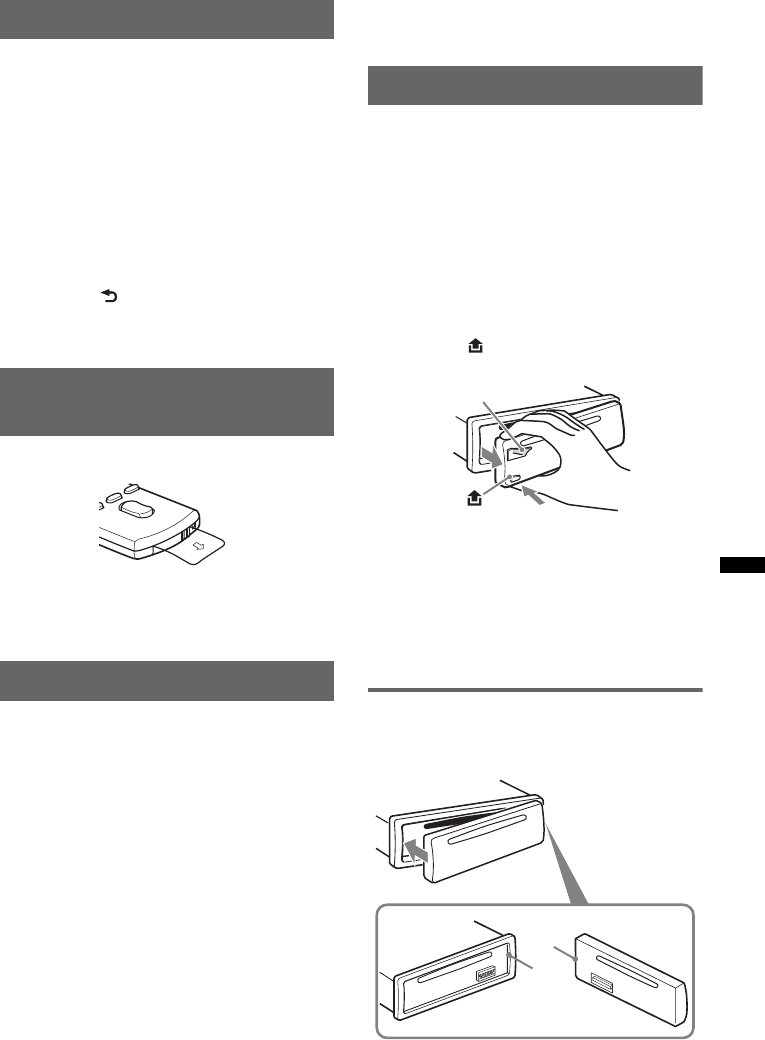
7
Cancelación del modo DEMO
Es posible cancelar la pantalla de demostración
que aparece durante el apagado.
1Mantenga presionado el botón de
selección.
Aparecerá la pantalla de ajustes.
2Gire el selector de control hasta que
aparezca “DEMO” y, a continuación,
presiónelo.
3Gire el selector de control hasta que
aparezca “DEMO-OFF” y, a
continuación, presiónelo.
El ajuste finalizó.
4Presione (BACK).
La pantalla vuelve al modo de recepción/
reproducción normal.
Preparación del control remoto
de tarjeta
Retire la lámina de aislamiento.
Sugerencia
Si desea obtener información adicional sobre cómo
sustituir la pila, consulte la página 35.
Ajuste del reloj
El reloj emplea una indicación digital de
12 horas.
1Mantenga presionado el botón de
selección.
Aparecerá la pantalla de ajustes.
2Gire el selector de control hasta que
aparezca “CLOCK-ADJ” y, a
continuación, presiónelo.
La indicación de la hora parpadea.
3Gire el selector de control para ajustar
la hora y los minutos.
Para mover la indicación digital, presione
(SEEK) –/+.
4Una vez ajustados los minutos,
presione el botón de selección.
El ajuste se completa y el reloj se pone en
funcionamiento.
Presione (DSPL) para que aparezca el reloj.
Presione (DSPL) de nuevo para volver a la
pantalla anterior.
Sugerencia
Puede ajustar el reloj automáticamente con la función
RDS (página 16).
Extracción del panel frontal
Es posible extraer el panel frontal de la unidad
para evitar que la roben.
Alarma de precaución
Si gira el interruptor de la llave de encendido
hasta la posición OFF sin haber extraído el panel
frontal, la alarma de precaución sonará durante
unos segundos.
La alarma sonará solamente si se utiliza el
amplificador incorporado.
1Mantenga presionado (SOURCE/OFF).
La unidad se apagará.
2Presione y, a continuación, extraiga
el panel frontal hacia usted.
Notas
•No deje caer ni ejerza excesiva presión sobre el
panel frontal y el visualizador.
•No someta el panel frontal al calor ni a temperaturas
altas o excesiva humedad. Evite dejarlo en un
automóvil estacionado o sobre el tablero o la
bandeja trasera.
•No extraiga el panel frontal durante la reproducción
del dispositivo USB, ya que podrá dañar los datos
del USB.
Colocación del panel frontal
Fije la parte A del panel frontal en la parte B de
la unidad, tal como muestra la ilustración, y
presione el lado izquierdo hasta que encaje.
Nota
No coloque nada sobre la superficie interior del panel
frontal.
(SOURCE/OFF)
B
A

8
Guía rápida del funcionamiento de Bluetooth
Para obtener más información sobre el funcionamiento, consulte el “Bluetooth (Llamadas con manos
libres y transmisión continua de música)” (página 22) y las instrucciones de funcionamiento del
dispositivo Bluetooth.
Los 3 pasos necesarios para la función Bluetooth
1Emparejamiento
En primer lugar, registre (empareje) el dispositivo Bluetooth (teléfono celular, etc.) con esta
unidad. El emparejamiento ya no es necesario después de la primera vez.
2Conexión
Después de realizar el emparejamiento, conecte esta unidad y el dispositivo Bluetooth. En función
del dispositivo, la conexión se efectúa automáticamente junto con el emparejamiento.
3Llamada con manos libres/transmisión continua de música
Puede realizar y recibir una llamada con manos libres o escuchar audio a través de esta unidad.
Sitio web de asistencia al cliente
http://esupport.sony.com
http://www.sony.com/mobileAV
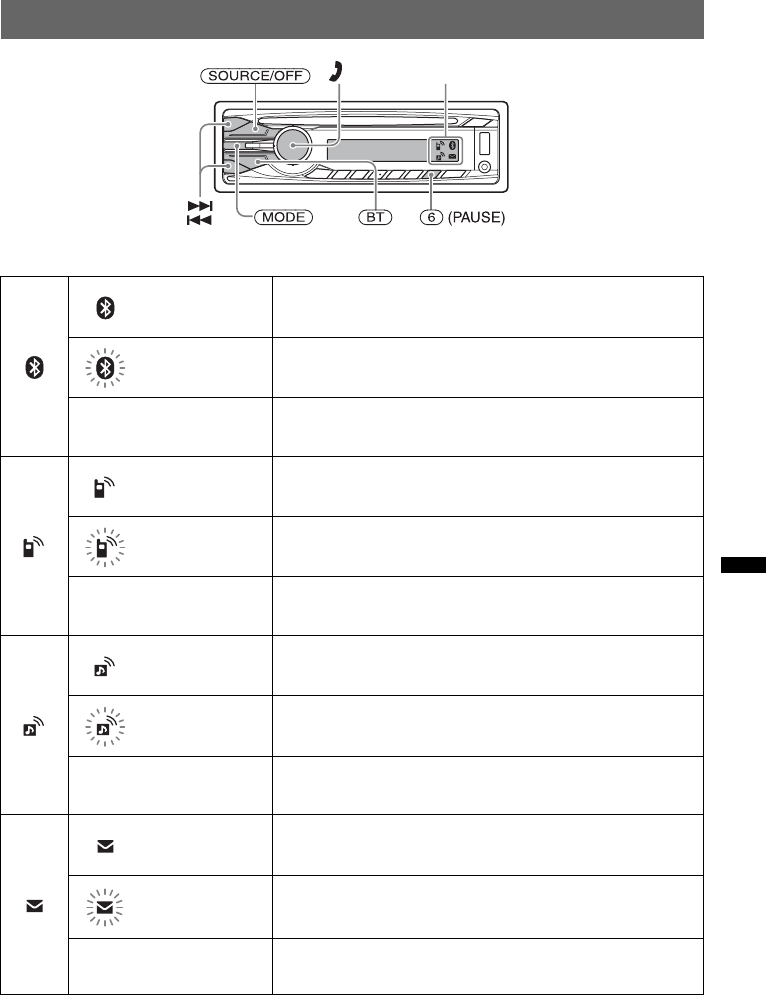
9
Botones e iconos
Descripciones del estado de los iconos
Encendido Señal Bluetooth activada.
Parpadea Modo de espera de emparejamiento.
Ninguno Señal Bluetooth desactivada.
Encendido Conectado a un teléfono celular.
Parpadea Conexión en curso.
Ninguno Ningún teléfono celular conectado para llamada con manos
libres.
Encendido Conectado a un dispositivo.
Parpadea Conexión en curso.
Ninguno Ningún dispositivo conectado para transmisión continua de
música.
Encendido Existen algunos mensajes SMS no leídos.
Parpadea Se ha recibido un nuevo mensaje SMS.
Ninguno No existen mensajes SMS no leídos.
Iconos
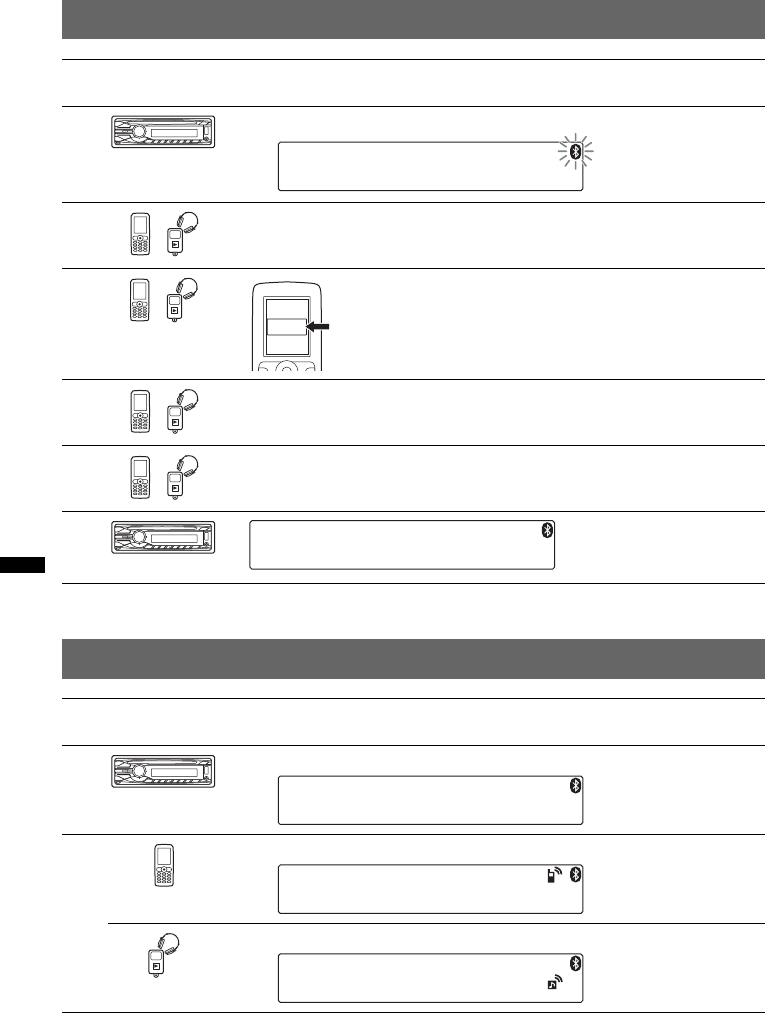
10
1Emparejamiento
2Conexión
Nota
Puede conectarse desde esta unidad a un dispositivo Bluetooth (página 23).
Si no puede conectarse desde esta unidad al dispositivo Bluetooth, inicie el emparejamiento de nuevo.
Equipo
utilizado
Funcionamiento
1Mantenga presionado (BT).
2Busque esta unidad.
3
4Si se solicita una clave en la pantalla del dispositivo que se va a conectar,
introduzca “0000”.
5Siga las instrucciones de la pantalla.
6
Equipo
utilizado
Funcionamiento
1Presione (BT).
2Conéctese a esta unidad con un teléfono celular.
Conéctese a esta unidad con un dispositivo de audio.
t
XXXXXXX
DR-BT30Q
Sony
Automotive
Seleccione “Sony Automotive”.
(Emparejamiento
establecido correctamente)
t
t
t
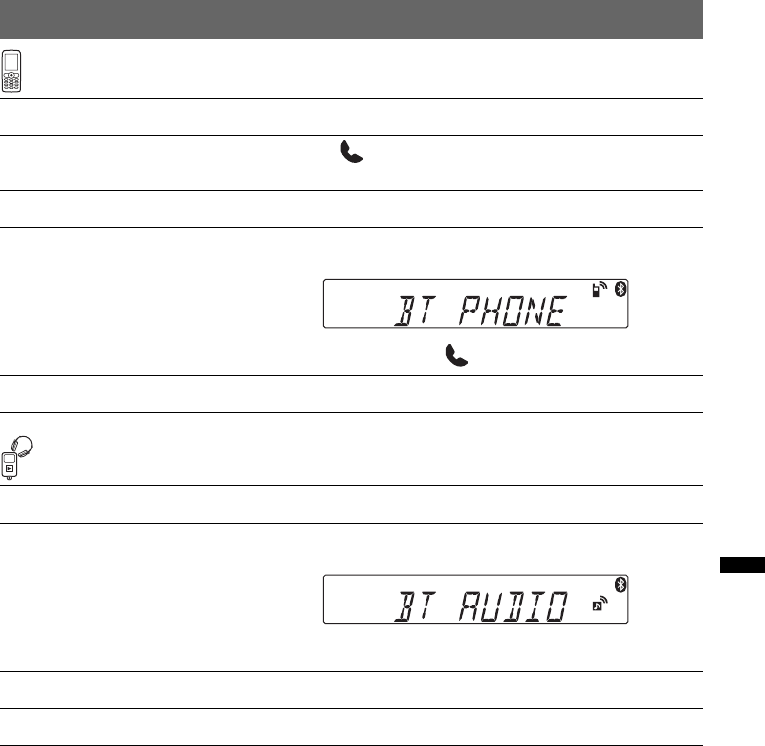
11
3Llamadas con manos libres y transmisión continua de música
Llamada con manos libres
Transmisión continua de música
*Es posible que el funcionamiento varíe en función del dispositivo de audio.
Para Funcionamiento
Recibir una llamada/finalizar una
llamada Presione .
Rechazar una llamada Mantenga presionado (SOURCE/OFF) durante 1 segundo.
Remarcación 1Presione (SOURCE/OFF) varias veces hasta que aparezca
“BT PHONE”.
2Mantenga presionado .
Transferir una llamada Presione (MODE).
Para Funcionamiento
Escuchar 1Presione (SOURCE/OFF) varias veces hasta que aparezca
“BT AUDIO”.
2Inicie la reproducción en el dispositivo de audio.
Reproducir/pausar (AVRCP)* Presione (6) (PAUSE).
Omitir pistas (AVRCP)* Presione ./>.
t
t
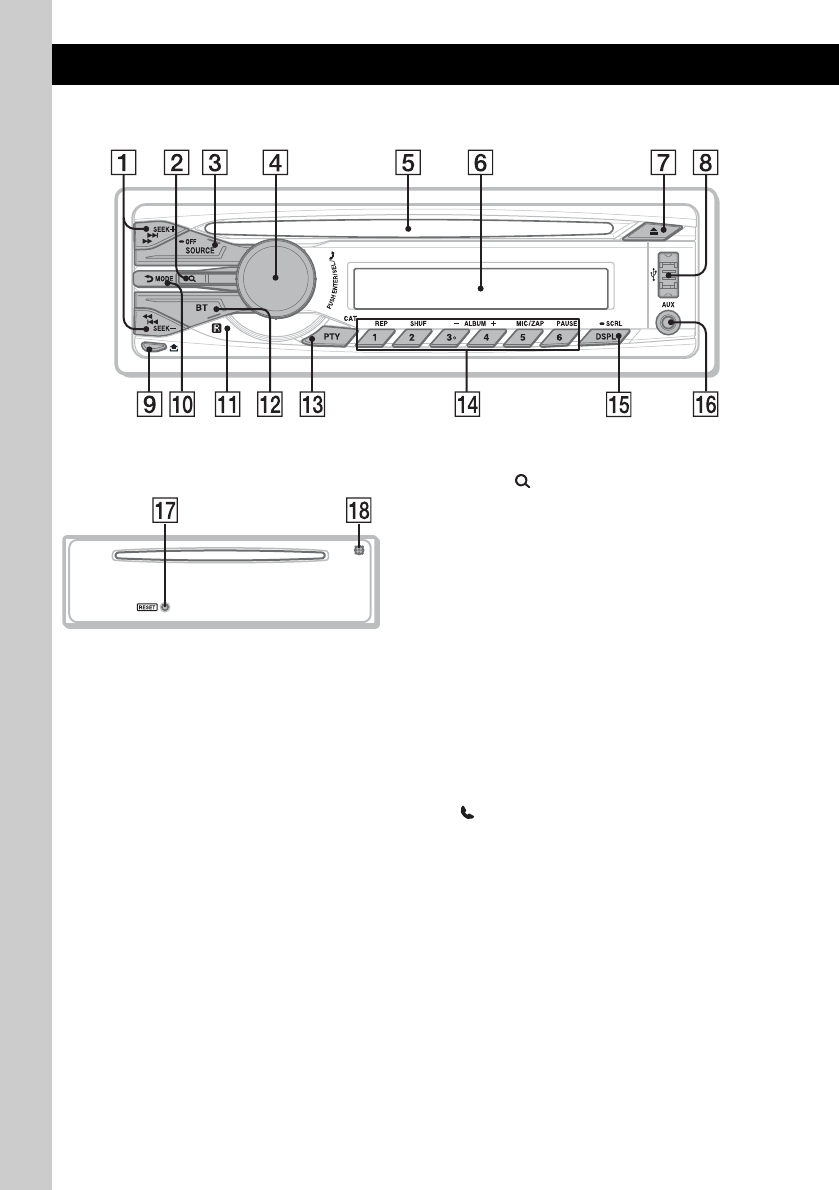
12
Ubicación de los controles y operaciones básicas
Unidad principal
Panel frontal extraído
Este apartado contiene instrucciones acerca de la
ubicación de los controles y las operaciones
básicas.
Consulte las páginas indicadas para obtener
información detallada.
ABotones SEEK +/–
Radio:
Para sintonizar emisoras en forma
automática (presionar); para localizar una
emisora en forma manual (mantener
presionado).
CD/USB:
Para omitir pistas (presionar); para omitir
pistas en forma continua (presionar y volver
a presionar dentro de 1 segundo y mantener);
para avanzar rápidamente o retroceder una
pista (mantener presionado).
Dispositivo de audio Bluetooth*1:
Para omitir pistas (presionar); avanzar
rápidamente o retroceder una pista (mantener
presionado).
BBotón (BROWSE) página 20, 24, 25
Presiónelo para: Introducir el modo Quick-
BrowZer™ (CD/USB)/abrir la agenda
telefónica (teléfono Bluetooth)*2.
Manténgalo presionado para: Cambiar la
fuente del teléfono Bluetooth/abrir el
historial de llamadas (teléfono Bluetooth)*2.
CBotón SOURCE/OFF*3
Presione para encender la unidad/para
cambiar la fuente (Radio/CD/USB/AUX/
audio Bluetooth/teléfono Bluetooth).
Presione durante 1 segundo para desactivar
la alimentación/rechazar una llamada.
Presione durante 2 segundos o más para
desactivar la alimentación y la pantalla se
apaga.
DSelector de control/selección/botón
(manos libres) página 24, 28, 31
Para ajustar el volumen (girar), para
seleccionar los elementos de ajuste
(presionar y girar); recibir/finalizar una
llamada (presionar).
ERanura del disco
Inserte el disco (con la etiqueta mirando
hacia arriba) y se iniciará la reproducción.
FVisualizador

13
GBotón Z (expulsar)
Para expulsar el disco.
HConector USB página 17, 18
Para conectar al dispositivo USB.
IBotón (extracción del panel
frontal) página 7
JBotón (BACK)/MODE página 9, 15,
20, 25, 26
Presiónelo para: Volver a la pantalla anterior/
seleccionar la banda de radio (FM/AM)*3.
Manténgalo presionado para: Ingresar/
cancelar el control del pasajero.
KReceptor del control remoto de tarjeta
LBotón BT (BLUETOOTH) página 9, 22,
23
Para activación y desactivación de la señal
Bluetooth (presionar) y emparejamiento
(mantener presionado).
MBotón PTY/CAT*4 página 16
Para seleccionar PTY en RDS.
NBotones numéricos
Radio:
Para recibir las emisoras almacenadas
(presionar); para almacenar emisoras
(mantener presionado).
CD/USB:
(1): REP página 16, 18, 19
(2): SHUF página 16, 18, 19
(3)*5/(4): ALBUM –/+ (durante la
reproducción de MP3/WMA/AAC)
Para omitir álbumes (presionar); omitir
álbumes continuamente (mantener
presionado).
(5): MIC/ZAP página 21
Para acceder al modo ZAPPIN™
(presionar).
(6): PAUSE
Para pausar la reproducción. Para
cancelar esta función, vuelva a
presionar.
Dispositivo de audio Bluetooth*1:
(1): REP página 27
(2): SHUF página 27
(3)/(4): ALBUM –/+
Para omitir álbumes (presionar); omitir
álbumes continuamente (mantener
presionado).
(6): PAUSE
Para pausar la reproducción. Presione
de nuevo para cancelar la pausa.
Teléfono Bluetooth:
Para llamar a números almacenados
(presionar); para almacenar números
predeterminados (mantener presionado).
(5): MIC/ZAP (durante una llamada)
página 25
Para ajustar la ganancia del MIC
(presionar); para seleccionar el modo
cancelador de eco/cancelador de ruido
(mantener presionado).
OBotón DSPL (pantalla)/SCRL
(desplazamiento) página 15,16,17,19,
20, 23
Para cambiar los elementos de pantalla
(presionar); para desplazar el elemento de la
pantalla (mantener presionado).
PToma de entrada AUX página 32
Para conectar un dispositivo de audio
portátil.
QBotón RESET (ubicado detrás del panel
frontal) página 6
RMicrófono página 24
Nota
No cubra el micrófono, la función de manos libres
puede no funcionar correctamente.
*1 Cuando se conecta un dispositivo de audio
Bluetooth (compatible con el AVRCP de la
tecnología Bluetooth). Según el tipo de dispositivo,
hay algunas operaciones que no se encuentran
disponibles.
*2 Cuando se conecta un teléfono celular (compatible
con el PBAP de la tecnología Bluetooth).
*3 En caso de que se encuentre conectado un
sintonizador HD Radio o un sintonizador SAT:
cuando se presione (SOURCE/OFF), en la pantalla
aparecerá el dispositivo conectado (“HD”, “XM” o
“SR”). Además, si presiona (MODE), podrá
cambiar la banda del sintonizador HD Radio o la
banda del sintonizador SAT.
*4 Si el sintonizador SAT está conectado.
*5 Este botón tiene un punto sensible al tacto.
Notas
•Al expulsar o insertar un disco, mantenga
desconectado cualquier dispositivo USB para evitar
dañar el disco.
•Si la unidad está apagada y desaparece la
indicación de pantalla, no se podrá utilizar con el
control remoto de tarjeta salvo que se presione
(SOURCE/OFF) en la unidad o se inserte un disco
para activarla en primer lugar.
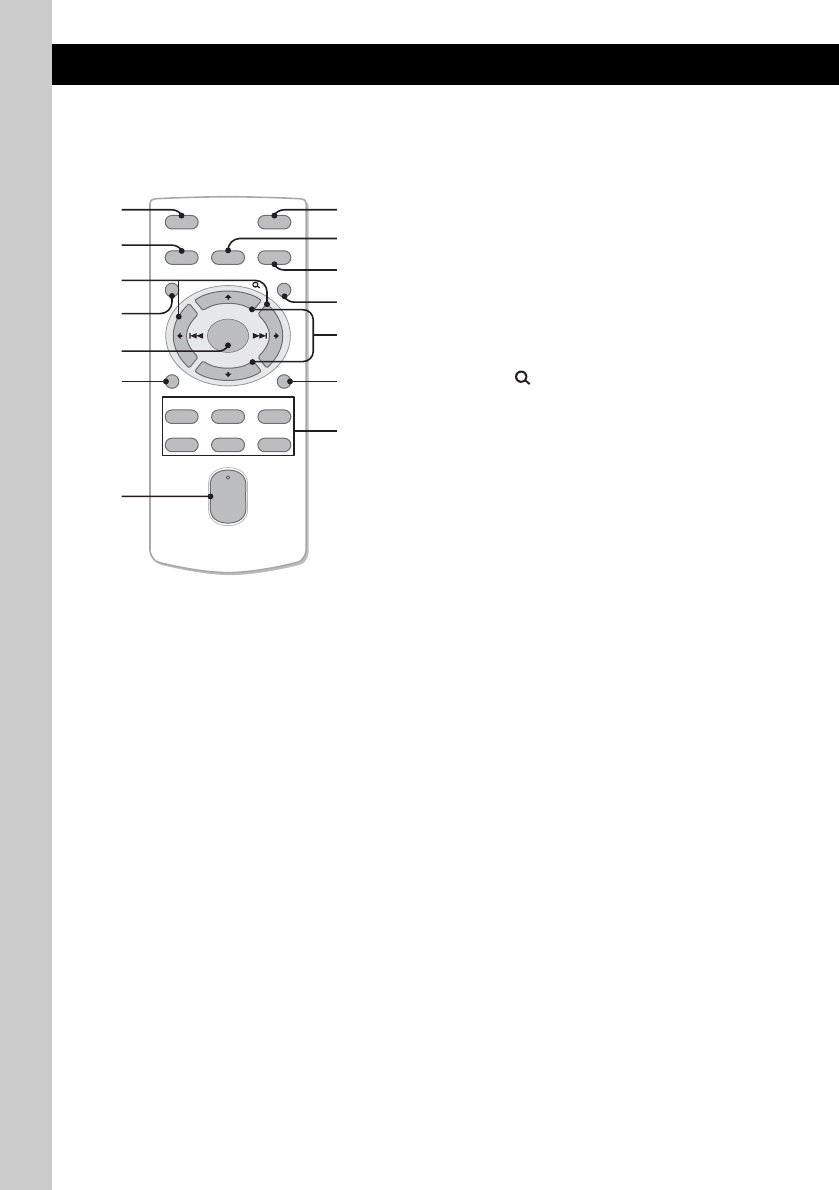
14
RM-X172
Control remoto de tarjeta
Extraiga la película de aislamiento antes de usar
la unidad (página 7).
ABotón OFF
Para apagar la alimentación; para detener la
fuente y para rechazar una llamada.
BBotón SOURCE*1
Para encender la unidad; para cambiar la
fuente (Radio/CD/USB/AUX/audio
Bluetooth/teléfono Bluetooth).
CBotones < (.)/, (>)
Para controlar la Radio/CD/USB/audio
Bluetooth, de la misma manera que con
(SEEK) –/+ en la unidad.
Es posible ajustar la configuración, los
ajustes de sonido, etc. mediante < ,.
DBotón MENU
Para entrar en el menú.
EBotón ENTER
Para aplicar un ajuste; para recibir una
llamada y para finalizar una llamada.
FBotón DSPL (pantalla)
Para cambiar los elementos en pantalla.
GBotón VOL (volumen) +*2/–
Para ajustar el volumen.
HBotón ATT (atenuación)
Para atenuar el sonido. Para cancelar esta
función, vuelva a presionarlo.
IBotón SOUND
Para introducir los ajustes de sonido.
JBotón MODE
Presione para seleccionar la banda de radio
(FM/AM)*1.
Manténgalo presionado para acceder o
cancelar el modo de control del pasajero.
KBotón (BROWSE)/CAT*3
Presiónelo para: Introducir el modo Quick-
BrowZer™ (CD/USB)/abrir la agenda
telefónica (teléfono Bluetooth).
Manténgalo presionado para: Cambiar la
fuente del teléfono Bluetooth/abrir el
historial de llamadas (teléfono Bluetooth).
LBotones M (+)/m (–)
Para controlar el CD/USB/dispositivo de
audio Bluetooth, de la misma manera que
con (3)/(4) (ALBUM –/+) en la unidad.
Es posible ajustar la configuración, los
ajustes de sonido, etc. mediante M m.
MBotón SCRL (desplazamiento)
Para desplazar el elemento de la pantalla.
NBotones numéricos
Radio:
Para recibir las emisoras almacenadas
(presionar); para almacenar emisoras
(mantener presionado).
CD/USB/Dispositivo de audio Bluetooth*4:
(1): REP
(2): SHUF
(6): PAUSE
Para pausar la reproducción. Presione
de nuevo para cancelar la pausa.
*1 En caso de que se encuentre conectado un
sintonizador HD Radio o un sintonizador SAT:
cuando se presione (SOURCE), en la pantalla
aparecerá el dispositivo conectado (“HD”, “XM” o
“SR”). Además, si presiona (MODE), podrá
cambiar la banda del sintonizador HD Radio o la
banda del sintonizador SAT.
*2 Este botón tiene un punto sensible al tacto.
*3 Si el sintonizador SAT está conectado.
*4 Cuando se conecta un dispositivo de audio
Bluetooth (compatible con el AVRCP de la
tecnología Bluetooth). Según el tipo de dispositivo,
hay algunas operaciones que no se encuentran
disponibles.
OFF
DSPL SCRL
SOURCE
MODE
132
465
ATT
VOL
+
–
+
–
REP SHUF
MENU
SOUND
PAU SE
ENTER
/CAT
29
0
1
3
4
5
6
8
7
qf
qs
qa
qd
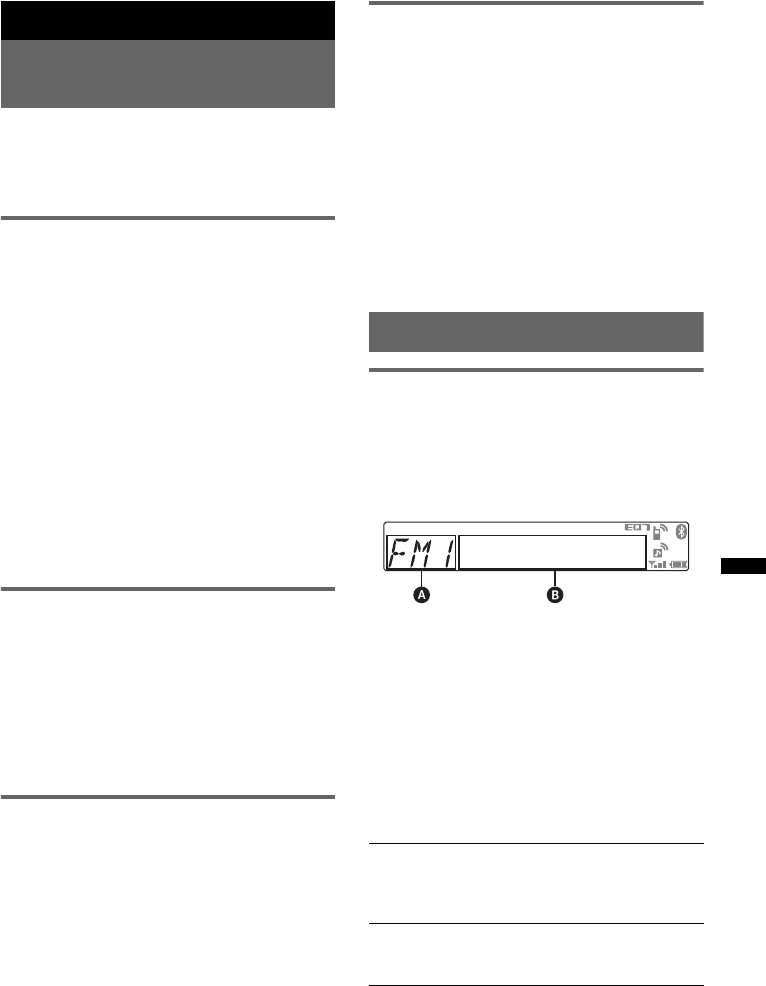
15
Radio
Almacenamiento y recepción
de emisoras
Precaución
Para sintonizar emisoras mientras maneja, utilice
la función BTM (Memoria de la mejor sintonía)
para evitar accidentes.
Almacenamiento automático
— BTM
1Presione (SOURCE/OFF) varias veces
hasta que aparezca “TUNER”.
Para cambiar de banda, presione (MODE)
varias veces. Puede seleccionar entre FM1,
FM2, FM3, AM1 y AM2.
2Mantenga presionado el botón de
selección.
Aparecerá la pantalla de ajustes.
3Gire el selector de control hasta que
aparezca “BTM” y, a continuación,
presiónelo.
La unidad almacena las emisoras en el orden
de frecuencia en los botones numéricos.
La unidad emite un pitido al almacenar el
ajuste.
Almacenamiento manual
1Mientras recibe la emisora que desea
almacenar, mantenga presionado un
botón numérico (de (1) a (6)) hasta
que aparezca “MEM”.
Nota
Si intenta almacenar otra emisora en el mismo botón
numérico, se reemplazará la que estaba almacenada
previamente.
Recepción de las emisoras
almacenadas
1Seleccione la banda y, a continuación,
presione un botón numérico (de (1) a
(6)).
Sintonización automática
1Seleccione la banda y, a continuación,
presione (SEEK) +/– para buscar la
emisora.
La búsqueda se detiene cuando la unidad
recibe una emisora. Repita este
procedimiento hasta recibir la emisora
deseada.
Sugerencia
Si conoce la frecuencia de la emisora que desea
escuchar, mantenga presionado (SEEK) +/– para
localizar la frecuencia aproximada y, a continuación,
presione (SEEK) +/– varias veces para ajustar la
frecuencia deseada con mayor precisión
(sintonización manual).
RDS
Descripción general
Las emisoras de radio FM que tienen el servicio
de Sistema de datos de radio (RDS) envían
información digital inaudible junto a la señal
habitual del programa de radio.
Elementos de la pantalla
ABanda de radio, función
BNombre de servicio del programa, reloj,
frecuencia*, número predefinido
*Mientras recibe la emisora RDS, aparece “ *” a la
izquierda de la indicación de la frecuencia.
Para cambiar los elementos de la pantalla
B
,
presione
(DSPL)
.
Servicios RDS
Esta unidad suministra automáticamente
servicios RDS de la siguiente manera:
Notas
•Dependiendo del país o región, puede que no estén
disponibles todas las funciones RDS.
•RDS no funcionará si la intensidad de la señal es
muy débil o si la emisora que sintonizó no transmite
datos RDS.
PTY (Tipos de programa)
Muestra el tipo de programa recibido
actualmente. Busca además el tipo de programa
seleccionado.
CT (Hora del reloj)
Los datos CT de la transmisión RDS ajustan el
reloj.
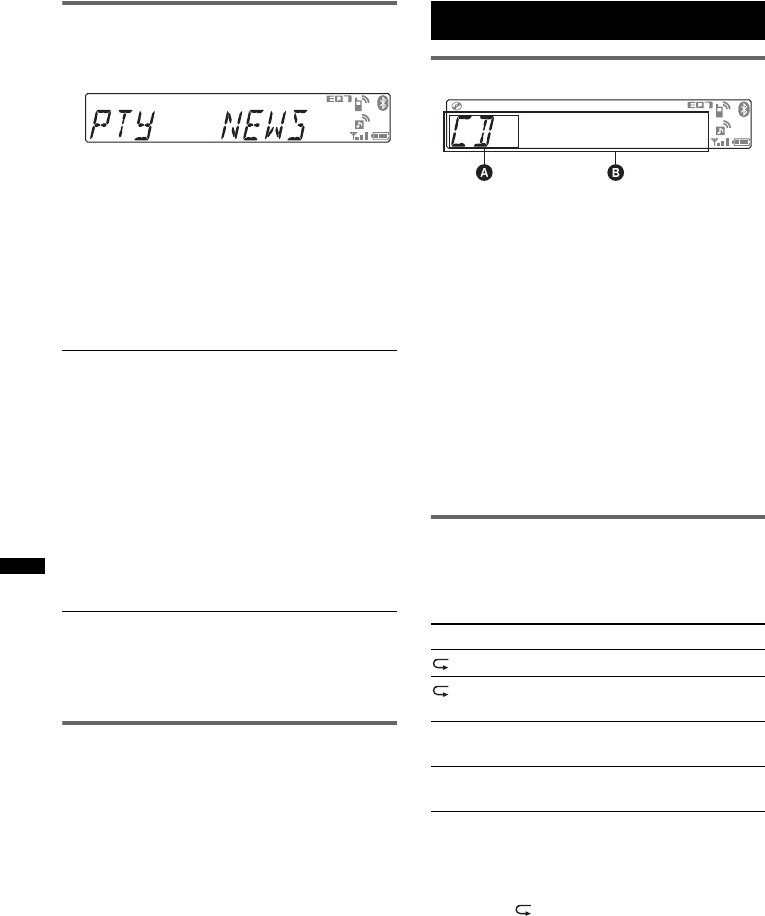
16
Selección de PTY
1Presione (PTY) durante la recepción
de FM.
Si la estación está transmitiendo datos PTY
aparece el nombre del tipo de programa
actual.
2Gire el selector de control hasta que
aparezca el tipo de programa deseado
y, a continuación, presiónelo.
La unidad comienza a buscar una estación
que emita el tipo de programa seleccionado.
Tipos de programas
Notas
•No puede usar esta función en países o regiones
donde no hay disponibles datos PTY.
•Puede recibir un programa de radio distinto del que
seleccionó.
Ajuste de CT
1Ajuste “CT-ON” en la configuración
(página 31).
Notas
•Puede que la función CT no funcione a pesar de
que se reciba una emisora RDS.
•Puede haber una diferencia entre la hora ajustada
por la función CT y la hora real.
CD
Elementos de la pantalla
AFuente
BNombre de la pista*1, Nombre del disco/
artista*1, Nombre del artista*1, Número de
álbum*2, Nombre del álbum*1, Número de
pista/tiempo de reproducción transcurrido,
Reloj
*1 Se muestra la información de un CD TEXT, MP3/
WMA/AAC.
*2 El número del álbum se muestra solamente
cuando se cambia de álbum.
Para cambiar los elementos de la pantalla B,
presione (DSPL).
Sugerencia
Los elementos que se muestran pueden variar en
función del tipo de disco, el formato de grabación y los
ajustes.
Reproducción repetida y aleatoria
1Durante la reproducción, presione (1)
(REP) o (2) (SHUF) varias veces hasta
que aparezca el ajuste deseado.
*Cuando se reproduce un archivo MP3/WMA/AAC.
Después de 3 segundos, se completa el ajuste.
Para volver al modo de reproducción normal,
seleccione “ OFF” o “SHUF OFF”.
NEWS (Noticias), INFORM (Información),
SPORTS (Deportes), TAL K (Conversación),
ROCK (Rock), CLS ROCK (Rock clásico),
ADLT HIT (Éxitos para el adulto), SOFT RCK
(Rock suave), TOP 40 (Los 40 mejores),
COUNTRY (Country), OLDIES (Éxitos del
ayer), SOFT (Suave), NOSTALGA
(Nostalgia), JAZZ (Jazz), CLASSICL
(Clásico), R AND B (R&B), SOFT R B (R&B
suave), LANGUAGE (Idiomas extranjeros),
REL MUSC (Música religiosa), REL TALK
(Conversación religiosa), PERSNLTY
(Personalidad), PUBLIC (Público), COLLEGE
(Universidad), WEATHER (Tiempo)
Seleccione Para reproducir
TRACK pistas en forma repetida.
ALBUM* álbumes en forma
repetida.
SHUF ALBUM* álbumes en orden
aleatorio.
SHUF DISC discos en orden
aleatorio.
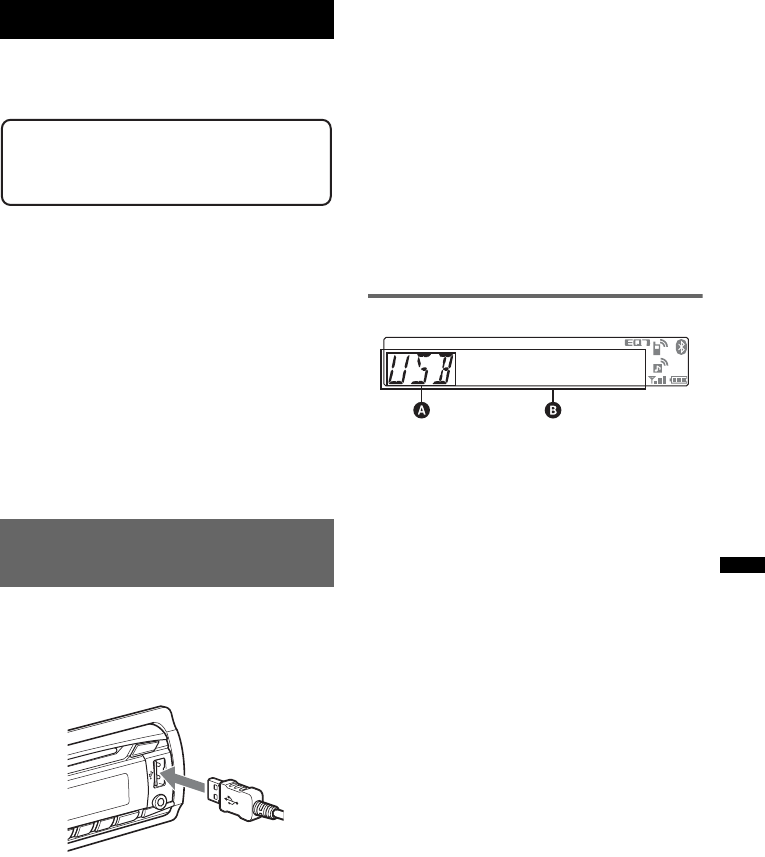
17
Dispositivos USB
Para obtener más información acerca de la
compatibilidad del dispositivo USB, visite el
sitio web de soporte técnico.
• Es posible utilizar dispositivos USB de
almacenamiento masivo (MSC) y de protocolo
de transferencia multimedia (MTP) que
cumplan con el estándar USB.
• Los códecs correspondientes son MP3 (.mp3),
WMA (.wma), AAC (.m4a) y AAC (.mp4).
• Se recomienda realizar una copia de seguridad
de los datos almacenados en los dispositivos
USB.
Nota
Conecte el dispositivo USB después de encender el
motor.
En función del tipo de dispositivo USB, es posible que
se produzcan fallos de funcionamiento o daños si se
conecta antes de encender el motor.
Reproducción desde un
dispositivo USB
1Conecte el dispositivo USB al
conector USB.
Cuando utilice un cable, use el que se ha
suministrado para la conexión con el
dispositivo USB.
Se inicia la reproducción.
Si ya hay un dispositivo USB conectado,
presione (SOURCE/OFF) varias veces hasta que
aparezca “USB” para empezar la reproducción.
Mantenga presionado (SOURCE/OFF) 1
segundo para detener la reproducción.
Extracción del dispositivo USB
1Detenga la reproducción del dispositivo USB.
2Extraiga el dispositivo USB.
Si extrae el dispositivo USB durante la
reproducción, es posible que se dañe la
información contenida en el dispositivo USB.
Notas
•No utilice dispositivos USB demasiado grandes o
pesados, ya que se podrán caer debido a la
vibración, o bien, provocar una conexión deficiente.
•No extraiga el panel frontal durante la reproducción
del dispositivo USB, ya que podrá dañar los datos
del USB.
•Esta unidad no puede reconocer dispositivos USB a
través de un concentrador USB.
Elementos de la pantalla
AFuente
BNombre de la pista, Nombre del artista,
Número de álbum*, Nombre del álbum,
Número de pista/Tiempo de reproducción
transcurrido, Reloj
*El número del álbum se muestra solamente cuando
se cambia de álbum.
Para cambiar los elementos de la pantalla B,
presione (DSPL).
Notas
•Los elementos que se muestran variarán en función
del tipo de dispositivo USB, el formato de grabación
y los ajustes. Para obtener más información, visite el
sitio web de soporte técnico.
•El número máximo de datos que se pueden
visualizar es el siguiente.
– carpetas (álbumes): 128
– archivos (pistas) por carpeta: 500
•No deje un dispositivo USB dentro de un automóvil
estacionado, ya que podrían producirse fallas de
funcionamiento.
•Es posible que el inicio de la reproducción demore
un poco, en función de la cantidad de datos
grabados.
•Es posible que no se puedan reproducir archivos
DRM (Gestión de derechos digitales).
•Durante la reproducción de un archivo MP3/WMA/
AAC de VBR (Velocidad de bits variable) o al
avanzar o retroceder rápidamente, es posible que el
tiempo de reproducción transcurrido no se muestre
con precisión.
•No es posible reproducir los archivos MP3/WMA/
AAC que se indican a continuación.
– archivos con formato de compresión sin pérdida
– archivos protegidos por derechos de autor
Sitio Web de soporte técnico en línea
http://esupport.sony.com
http://www.sony.com/mobileAV
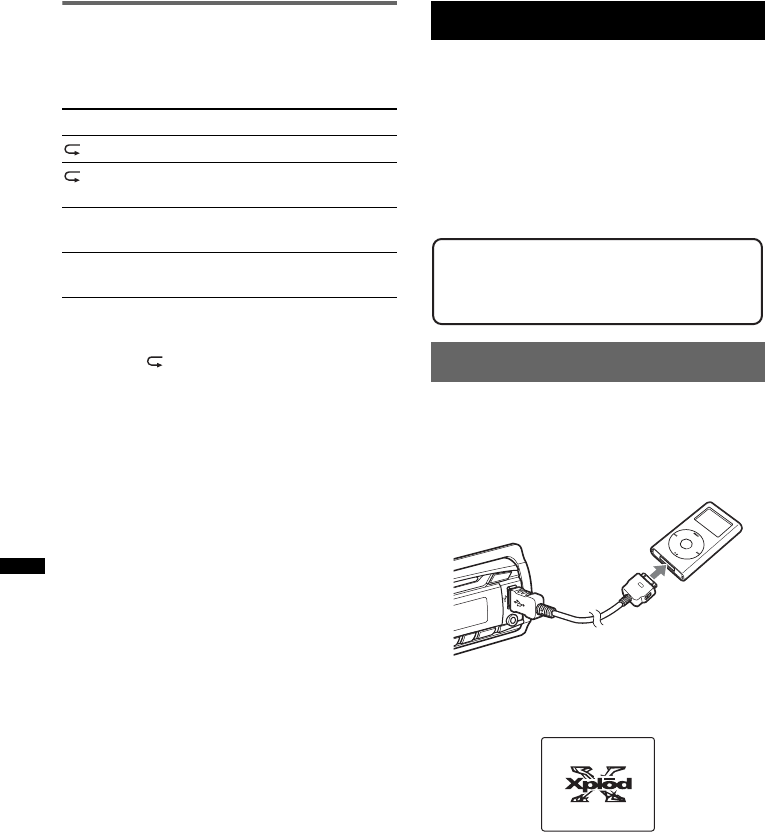
18
Reproducción repetida y aleatoria
1Durante la reproducción, presione (1)
(REP) o (2) (SHUF) varias veces hasta
que aparezca el ajuste deseado.
Después de 3 segundos, se completa el ajuste.
Para volver al modo de reproducción normal,
seleccione “ OFF” o “SHUF OFF”.
iPod
Para obtener más información acerca de la
compatibilidad de su iPod, consulte “Acerca de
iPod” en la página 34 o visite el sitio web de
soporte técnico.
En este Manual de instrucciones, “iPod” se
utiliza como referencia general para las
funciones del iPod en el iPod y el iPhone, a
menos que se especifique lo contrario en el texto
o en las ilustraciones.
Reproducción de un iPod
Antes de conectar el iPod, baje el volumen de la
unidad.
1Conecte el iPod al conector USB a
través del conector de base conectado
al cable USB.
El iPod se encenderá automáticamente y la
indicación siguiente aparecerá en la pantalla
del iPod tal y como se ilustra a continuación.*
Sugerencia
Para ello, le recomendamos que utilice el cable
RC-100IP USB (no suministrado).
Las pistas del iPod empiezan a reproducirse
automáticamente a partir del punto en el que
se detuvo la última reproducción.
Si ya hay un iPod conectado, presione
(SOURCE/OFF) varias veces hasta que
aparezca “USB” para empezar la
reproducción. (en la pantalla aparecerá “IPD”
cuando se reconozca el iPod.)
Seleccione Para reproducir
TRACK pistas en forma repetida.
ALBUM álbumes en forma
repetida.
SHUF ALBUM álbumes en orden
aleatorio.
SHUF DEVICE dispositivos en orden
aleatorio.
Sitio Web de soporte técnico en línea
http://esupport.sony.com
http://www.sony.com/mobileAV
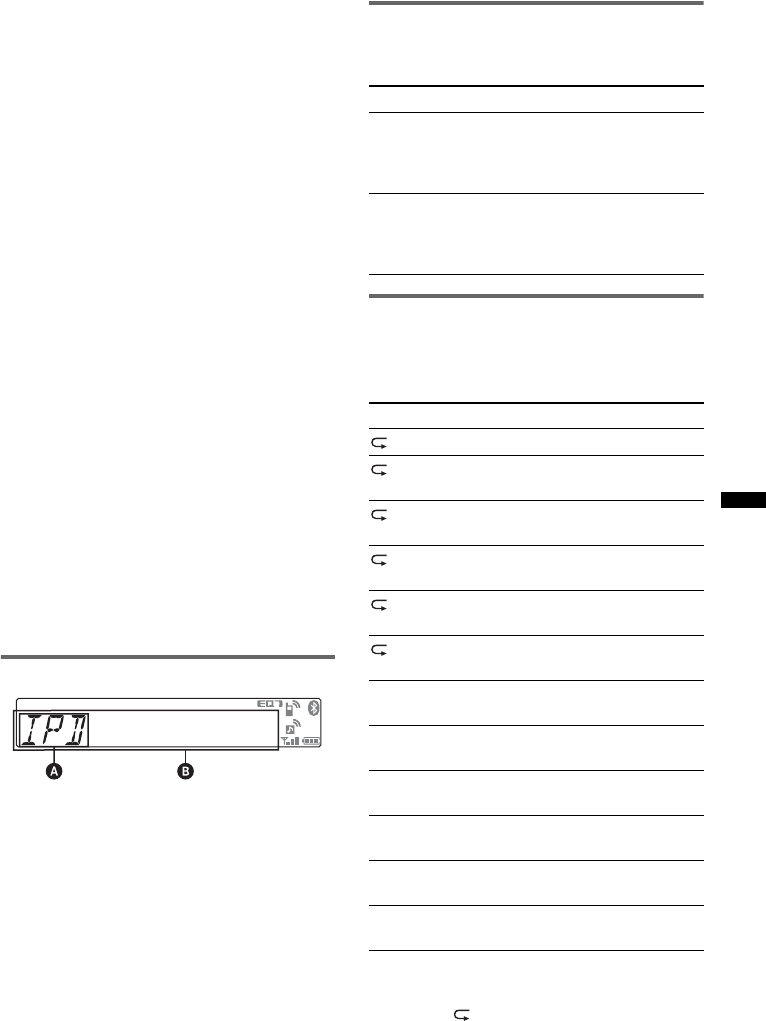
19
*En caso de que se conecte un iPod touch o un
iPhone, o si la última vez se realizó la reproducción
en el iPod en el modo de control de pasajero, el
logotipo no aparecerá en la pantalla.
2Ajuste el volumen.
Mantenga presionado (SOURCE/OFF)
1 segundo para detener la reproducción.
Extracción del iPod
1Detenga la reproducción del iPod.
2Extraiga el iPod.
Precaución para iPhone
Al conectar un iPhone mediante USB, el volumen del
teléfono se controla a través del iPhone. Para que el
volumen del dispositivo no sea extremadamente alto
tras una llamada, durante las llamadas, no lo aumente
en la unidad.
Notas
•No extraiga el panel frontal durante la reproducción
del iPod, ya que podrá dañar los datos.
•Esta unidad no puede reconocer el iPod a través de
un concentrador USB.
Sugerencias
•Si se coloca la llave de encendido en la posición
ACC, o si la unidad está encendida, el iPod se
recarga.
•Si el iPod se desconecta durante la reproducción,
aparecerá “NO DEV” en la pantalla de la unidad.
Modo de reanudación
Cuando el iPod se conecta al conector de base, el
modo de esta unidad cambia al modo de
reanudación y se inicia la reproducción en el
modo ajustado por el iPod.
En el modo de reanudación, no es posible utilizar
los botones siguientes.
– (1) (REP)
– (2) (SHUF)
Elementos de la pantalla
AIndicación de la fuente (iPod)
BNombre de la pista, Nombre del artista,
Nombre del álbum, Número de pista/Tiempo
de reproducción transcurrido, Reloj
Para cambiar los elementos de la pantalla B,
presione (DSPL).
Sugerencia
Si se modifica álbum/podcast/género/artista/lista de
reproducción, el número de elemento aparece
durante unos instantes.
Nota
Es posible que algunos caracteres almacenados en el
iPod no se visualicen correctamente.
Omitir álbumes, podcasts,
géneros, listas de reproducción y
artistas
Reproducción repetida y aleatoria
1Durante la reproducción, presione (1)
(REP) o (2) (SHUF) varias veces hasta
que aparezca el ajuste deseado.
Después de 3 segundos, se completa el ajuste.
Para volver al modo de reproducción normal,
seleccione “ OFF” o “SHUF OFF”.
Para Realice esta acción
Omitir Presione (3)/(4)
(ALBUM –/+)
[presionar una vez para cada
opción]
Omitir en
forma continua Mantenga presionado (3)/(4)
(ALBUM –/+)
[mantener presionado hasta
llegar al punto deseado]
Seleccione Para reproducir
TRACK pistas en forma repetida.
ALBUM álbumes en forma
repetida.
PODCAST podcast en forma
repetida.
ARTIST artistas en forma
repetida.
PLAYLIST listas de reproducción en
forma repetida.
GENRE género en forma
repetida.
SHUF ALBUM álbumes en orden
aleatorio.
SHUF PODCAST podcast en orden
aleatorio.
SHUF ARTIST artistas en orden
aleatorio.
SHUF PLAYLIST listas de reproducción en
orden aleatorio.
SHUF GENRE género en orden
aleatorio.
SHUF DEVICE dispositivos en orden
aleatorio.
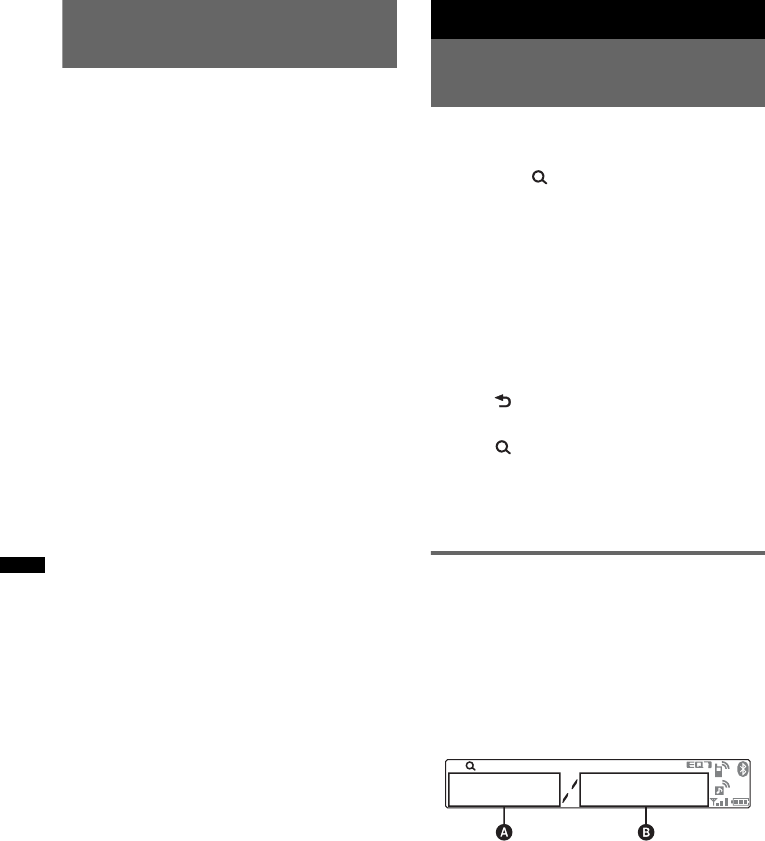
20
Utilización directa del iPod
— Control de pasajero
Puede utilizar directamente un iPod conectado al
conector de base.
1Durante la reproducción, mantenga
presionado (MODE).
Aparece “MODE IPOD” y se puede utilizar
el iPod directamente.
Para cambiar el elemento en pantalla
Presione (DSPL).
Los elementos en pantalla cambian de la manera
siguiente:
Nombre de la pista t Nombre del artista t
Nombre del álbum t MODE IPOD t Reloj
Para salir del modo de control de
pasajero
Mantenga presionado (MODE).
A continuación, aparecerá “MODE AUDIO” y el
modo de reproducción cambiará al modo de
reanudación.
Notas
•Sólo es posible ajustar el volumen en la unidad.
•Si se cancela este modo, el ajuste de repetición se
desactivará.
Búsqueda de una pista
Búsqueda de una pista por
nombre — Quick-BrowZer™
Puede buscar una pista fácilmente en un CD o
dispositivo USB por categoría.
1Presione (BROWSE).
La unidad accede al modo Quick-BrowZer y
aparece la lista de categorías de búsqueda.
2Gire el selector de control para
seleccionar la categoría de búsqueda
deseada y, a continuación, presiónelo
para confirmarla.
3Repita el paso 2 hasta que se
seleccione la pista deseada.
Se inicia la reproducción.
Para volver a la pantalla anterior
Presione (BACK).
Para salir del modo Quick-BrowZer
Presione (BROWSE).
Nota
Al acceder al modo Quick-BrowZer, se cancela el
ajuste de reproducción repetida/aleatoria.
Búsqueda por omisión de
elementos
— modo de Omisión
Cuando varios elementos se encuentran dentro de
una misma categoría, es posible encontrar un
elemento deseado rápidamente.
1Presione (SEEK) + en el modo Quick-
BrowZer.
Aparecerá la siguiente pantalla.
ANúmero del elemento actual
BNúmero total de elementos en la capa actual
A continuación, aparecerá el nombre del
elemento.
2Gire el selector de control para
seleccionar el elemento deseado o un
elemento cercano.
Omite en intervalos del 10% del número total
de elementos.
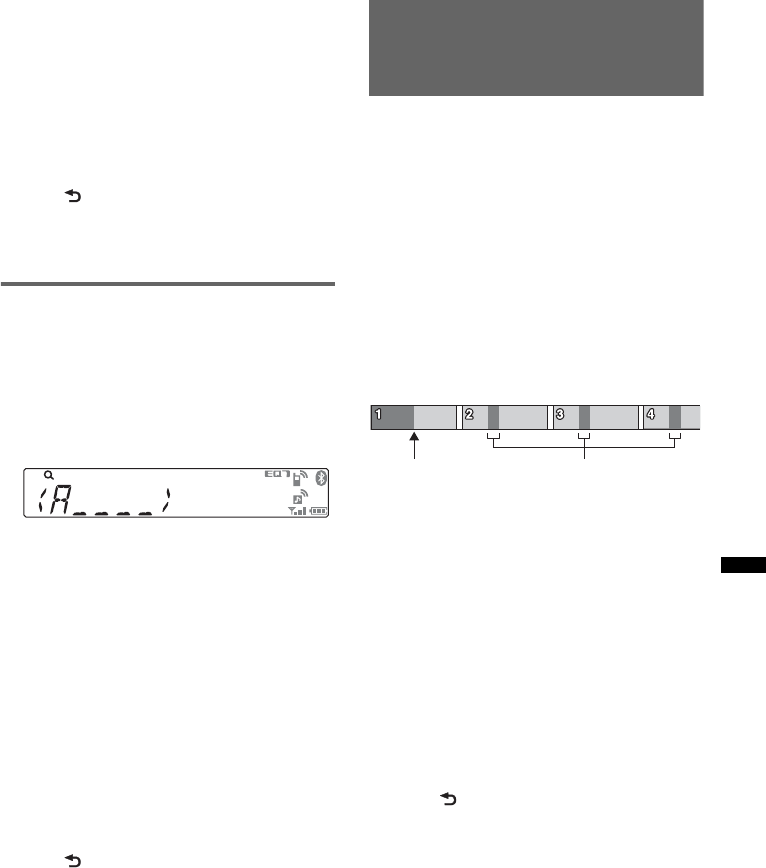
21
3Presione el botón de selección.
Vuelve a la pantalla del modo Quick-BrowZer
y aparece el elemento seleccionado.
4Gire el selector de control para
seleccionar el elemento deseado y
presiónelo.
Si el elemento seleccionado es una pista
empieza la reproducción.
Para cancelar el modo de Omisión
Presione (BACK) o (SEEK) –.
Nota
Si no se efectúa ninguna operación durante
7 segundos, se cancelará el modo de Omisión.
Búsqueda por orden alfabético
— Búsqueda alfabética
Cuando se conecta un iPod a la unidad, se puede
buscar un elemento deseado por orden alfabético.
1Presione (SEEK) + en el modo Quick-
BrowZer.
Aparecerá una lista ordenada
alfabéticamente.
2Gire el selector de control para
seleccionar la primera letra del
elemento deseado y, a continuación,
presiónelo.
Aparecerá una lista de elementos ordenados
alfabéticamente que comienzan por la letra
seleccionada.
Si no hay ninguna canción que comience por
la letra seleccionada, aparecerá “NOT
FOUND”.
3Gire el selector de control para
seleccionar el elemento deseado y, a
continuación, presiónelo.
Si el elemento seleccionado es una pista,
empieza la reproducción.
Para cancelar la Búsqueda alfabética
Presione (BACK) o (SEEK) –.
Aparecerá una lista de categorías de búsqueda.
Notas
•En la Búsqueda alfabética, se excluyen los símbolos
o los artículos (a/an/the) situados delante de la letra
seleccionada del elemento.
•En función del elemento de búsqueda que
seleccione, solamente estará disponible el modo de
Omisión.
•Si no se efectúa ninguna operación durante
5 segundos, se cancelará la Búsqueda alfabética.
Búsqueda de una pista
mediante la audición de
pasajes de pistas — ZAPPIN™
Durante la reproducción de cortos pasajes de las
pistas de un CD o dispositivo USB en secuencia,
es posible buscar una pista que desee escuchar.
El modo ZAPPIN es adecuado para buscar pistas
en el modo de reproducción aleatoria o de
repetición aleatoria.
1Presione (5) (MIC/ZAP) durante la
reproducción.
Después de que aparezca “ZAPPIN” en la
pantalla, la reproducción se inicia desde un
pasaje de la siguiente pista.
El pasaje se reproduce durante el tiempo
establecido y, a continuación, suena un clic y
se inicia el pasaje siguiente.
2Presione el botón de selección o (5)
(MIC/ZAP) cuando se reproduzca una
pista que desea escuchar.
La pista seleccionada se reproduce
normalmente desde el principio.
Para buscar una pista de nuevo en el modo
ZAPPIN, repita los pasos 1 y 2.
Sugerencias
•Es posible seleccionar el tiempo de reproducción
entre unos 6 segundos/15 segundos/30 segundos
(página 31). No es posible seleccionar el pasaje de
la pista que se reproducirá.
•Presione (SEEK) +/– o (3)/(4) (ALBUM –/+) en el
modo ZAPPIN para omitir una pista o un álbum.
•Para confirmar una pista que se va a reproducir,
presione (BACK).
La parte de cada pista a
reproducir en el modo
ZAPPIN.
Pista
(5) presionado.
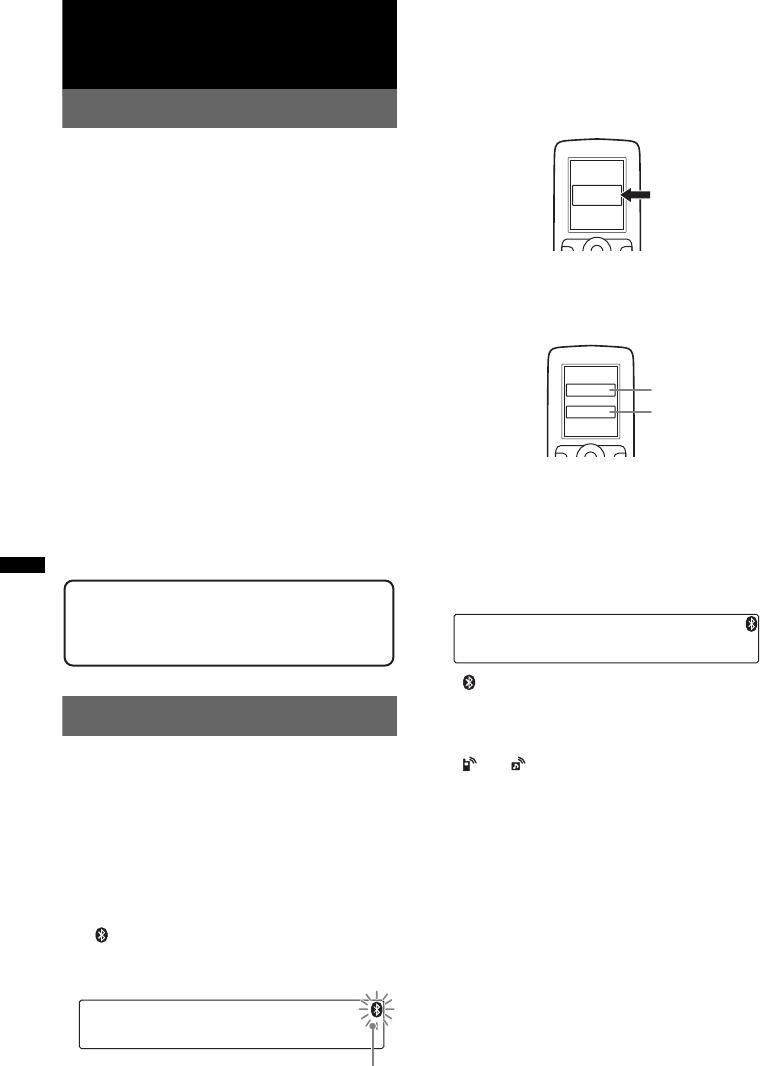
22
Bluetooth (Llamada con manos
libres y transmisión continua
de música)
Operaciones del Bluetooth
Para usar la función Bluetooth, es necesario
realizar el siguiente procedimiento.
1Emparejamiento
Cuando se conectan dispositivos Bluetooth
por primera vez, se requiere un registro
mutuo. Este procedimiento se denomina
“emparejamiento”. Es preciso registrarse
únicamente la primera vez, ya que esta unidad
y los demás dispositivos se reconocerán entre
sí automáticamente a partir de entonces. Es
posible emparejar hasta 9 dispositivos.
(Según el tipo de dispositivo, es posible que
necesite introducir una clave para cada
conexión.)
2Conexión
Inicie la conexión para utilizar el dispositivo
después de realizar el emparejamiento. En
ocasiones, el emparejamiento permite
conectarse automáticamente.
3Llamadas con manos libres/
transmisión continua de música
Puede hablar con manos libres y escuchar
música cuando se ha realizado la conexión.
Emparejamiento
Primero, registre (empareje) el dispositivo
Bluetooth (teléfono celular, etc.) con esta unidad.
Es posible emparejar hasta 9 dispositivos. Una
vez establecido el emparejamiento, no es
necesario volver a realizarlo.
1Coloque el dispositivo Bluetooth a una
distancia máxima de 1 metro de esta
unidad.
2Mantenga presionado (BT) hasta que
“ ” parpadee (más de 2 segundos).
La unidad ingresa en modo de espera de
emparejamiento.
3Ajuste el dispositivo Bluetooth para
que busque esta unidad.
Aparece una lista de los dispositivos
detectados en la pantalla del dispositivo que
desea conectar. Esta unidad se muestra como
“Sony Automotive” en el dispositivo que se
va a conectar.
4Si se requiere introducir una clave* en
la pantalla del dispositivo que se va a
conectar, ingrese “0000”.
Esta unidad y el dispositivo Bluetooth
memorizan mutuamente su información y
cuando se realiza el emparejamiento, la
unidad está lista para la conexión al
dispositivo. Si el dispositivo admite Bluetooth
versión 2.1, no es necesario volver a
introducir la clave.
“ ” parpadea y luego permanece encendido
después de completarse el emparejamiento.
5Ajuste el dispositivo Bluetooth para
que se conecte a esta unidad.
“ ” o “ ” aparece cuando se ha realizado la
conexión.
*La clave puede denominarse “código de acceso”,
“código PIN”, “número PIN” o “contraseña”, etc., en
función del dispositivo.
Sitio Web de soporte técnico en línea
http://esupport.sony.com
http://www.sony.com/mobileAV
parpadea
XXXXXXX
DR-BT30Q
Sony
Automotive
XXXX
Contraseña
introducida.
“0000”
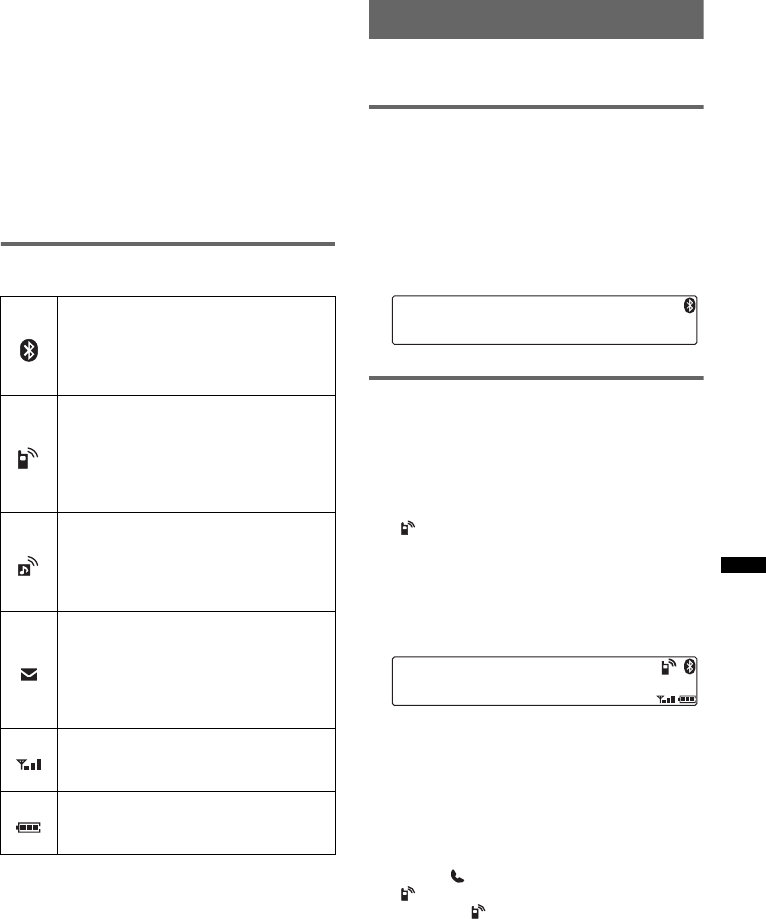
23
Notas
•Durante la conexión a un dispositivo Bluetooth, esta
unidad no puede detectarse desde otro dispositivo.
Para activar la detección, ingrese el modo de
emparejamiento y busque esta unidad desde otro
dispositivo.
•Es posible que se tarde cierto tiempo buscando o
para conectar.
•Según el dispositivo, la pantalla de confirmación de
la conexión aparece antes de introducir la clave.
•El límite de tiempo para introducir la clave varía en
función del dispositivo.
•Esta unidad no puede conectarse a un dispositivo
compatible sólo con HSP (perfil de auriculares).
Acerca de los iconos de Bluetooth
En esta unidad se utilizan los siguientes iconos.
*Se apaga sin conexión de manos libres. Difiere en el
caso de un teléfono celular.
Conexión
Si ya se ha conseguido el emparejamiento, inicie
la operación desde este punto.
Para cambiar la salida de señal
Bluetooth de esta unidad a
activada
Para utilizar la función de Bluetooth, cambie la
salida de señal Bluetooth de esta unidad a
activada.
1Presione (BT).
La señal Bluetooth se activa.
Conexión a un teléfono celular
1Asegúrese de que tanto la unidad
como el teléfono celular estén con
señal Bluetooth activada.
2Conecte a esta unidad con el teléfono
celular.
“ ” aparece cuando se establece la
conexión. Si selecciona la fuente del teléfono
Bluetooth una vez establecida la conexión, el
nombre de la red y el teléfono celular
conectado aparecen en la pantalla. Para
cambiar los elementos de la pantalla, presione
(DSPL).
Conexión del último teléfono celular
conectado desde esta unidad
1Asegúrese de que el teléfono celular tenga
activada la señal Bluetooth.
2Presione (SOURCE/OFF) varias veces hasta
que aparezca “BT PHONE”.
3Presione (manos libres).
“ ” parpadea mientras se realiza la
conexión. “ ” permanece encendido cuando
se ha realizado la conexión.
Notas
•Algunos teléfonos celulares requieren permiso para
acceder a los datos de su agenda telefónica durante
la conexión de manos libres a esta unidad. Obtenga
el permiso a través del teléfono celular.
Encendido
:
Parpadea:
Ninguno:
Señal Bluetooth activada.
Emparejamiento en modo
de espera.
Señal Bluetooth
desactivada.
Encendido
:
Parpadea:
Ninguno:
Conectado a un teléfono
celular.
Conexión en curso.
Ningún teléfono celular
conectado para llamada de
manos libres.
Encendido
:
Parpadea:
Ninguno:
Conectado a un dispositivo.
Conexión en curso.
Ningún dispositivo
conectado para transmisión
continua de música.
Encendido
:
Parpadea:
Ninguno:
Existen algunos mensajes
SMS no leídos.
Se ha recibido un nuevo
mensaje SMS.
No existen mensajes SMS
no leídos.
Estado de intensidad de la
señal del teléfono celular
conectado*.
Estado de batería restante
del teléfono celular
conectado*.
continúa en la página siguiente t
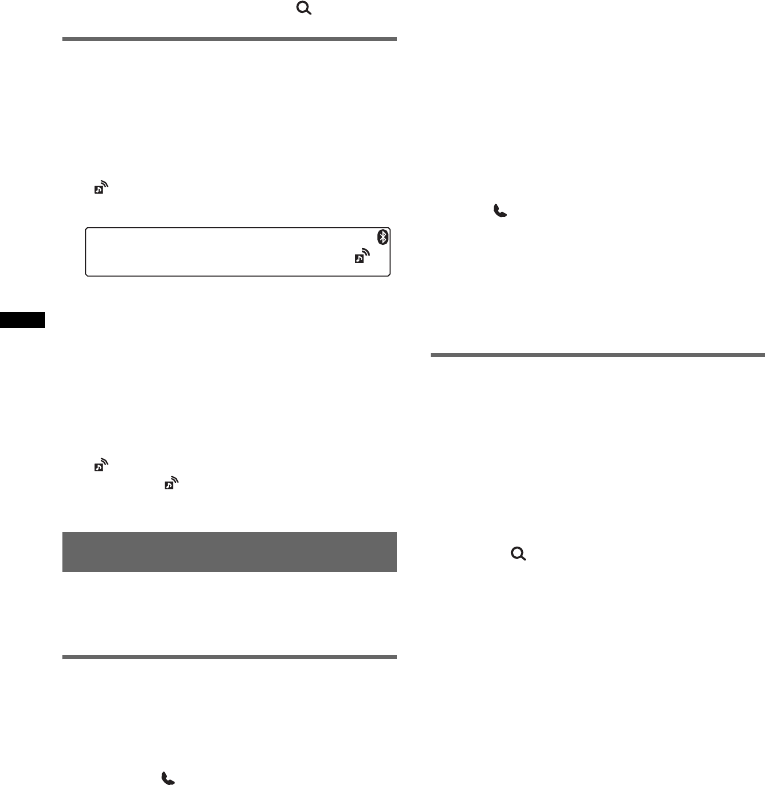
24
•Durante la transmisión continua de audio Bluetooth,
no se puede conectar desde esta unidad al teléfono
celular. En su lugar, conéctese desde el teléfono
celular hasta esta unidad. Es posible que se oiga un
ruido de conexión superpuesto al sonido de
reproducción.
Sugerencias
•Con la señal Bluetooth activada: cuando la llave de
encendido se gira a ON, esta unidad vuelve a
conectarse automáticamente al último teléfono
celular conectado. No obstante, la conexión
automática también depende de la especificación
del teléfono celular. Si no se ha realizado la
conexión automática, conéctela manualmente.
•También puede seleccionar la fuente del teléfono
Bluetooth manteniendo presionado (BROWSE).
Conexión a un dispositivo de audio
1Asegúrese de que tanto la unidad
como el dispositivo de audio tengan
activada la señal Bluetooth.
2Conéctese a esta unidad mediante el
dispositivo de audio.
“ ” aparece cuando se ha realizado la
conexión.
Conexión del último dispositivo de
audio conectado desde esta unidad
1Asegúrese de que el dispositivo de audio tenga
activada la señal Bluetooth.
2Presione (SOURCE/OFF) varias veces hasta
que aparezca “BT AUDIO”.
3Presione (6).
“ ” parpadea mientras se realiza la
conexión. “ ” permanece encendido cuando
se ha realizado la conexión.
Llamada con manos libres
Una vez conectada la unidad al teléfono celular,
puede realizar y recibir llamadas con manos
libres si utiliza esta unidad.
Recepción de llamadas
Al recibir una llamada, se emite un tono de
llamada a través de los altavoces del automóvil.
El nombre o el número de teléfono aparecen en
la pantalla.
1Presione (manos libres) cuando se
recibe una llamada con un tono de
llamada.
Comienza la llamada telefónica.
Notas
•Según el teléfono celular, es posible que aparezca
el nombre de la persona que llama.
•El micrófono incorporado de esta unidad se
encuentra en la parte posterior del panel frontal
(página 12). No cubra el micrófono con cinta, etc.
Respuesta automática
Puede seleccionar una respuesta automática de
“OFF”, “1 (unos 3 segundos)” o “2 (unos
10 segundos)” (página 31).
Ajuste del tono de llamada
Es posible cambiar el tono de llamada desde
“1 (esta unidad)” o “2 (teléfono celular)”
(página 31).
*En función del teléfono celular, es posible que se
emita el tono de llamada de esta unidad aunque
esté ajustada en “2 (teléfono celular)”.
Para rechazar una llamada
Mantenga presionado (SOURCE/OFF) durante
1 segundo.
Para finalizar una llamada
Presione (manos libres) nuevamente.
Nota
Incluso si la llamada finaliza, la conexión Bluetooth no
se cancela.
Sugerencia
También puede finalizar una llamada presionando
(SOURCE/OFF) en esta unidad durante 1 segundo.
Realización de llamadas
Llamada desde la agenda telefónica
Cuando realiza la conexión a un teléfono celular
compatible con PBAP (perfil de acceso a la
agenda telefónica), puede acceder a la agenda
telefónica y realizar una llamada.
1Presione (SOURCE/OFF) varias veces hasta
que aparezca “BT PHONE”.
2Presione (BROWSE).
Aparece la agenda telefónica.
3Gire el control de selección para seleccionar
una inicial de la lista de iniciales y, a
continuación, presiónelo.
4Gire el selector de control para seleccionar un
nombre de la lista de nombres y, a
continuación, presiónelo.
5Gire el selector de control para seleccionar un
número de la lista de números y, a
continuación, presiónelo.
Se inicia la llamada.

25
Notas
•Es posible que la agenda telefónica no se muestre
correctamente cuando se elimina la agenda
telefónica del teléfono celular.
•En función del teléfono celular, los contactos
visualizados en la unidad pueden diferir de la
agenda telefónica del teléfono celular.
Nota sobre los datos de la agenda telefónica
Antes de desechar o cambiar la propiedad de su
automóvil con esta unidad instalada, asegúrese de
presionar el botón RESET para borrar todos los datos
de la agenda telefónica de esta unidad para evitar el
posible acceso no autorizado.
Si desconecta el cable de la fuente de alimentación,
también puede borrar todos los datos de la agenda
telefónica.
Llamada desde el historial de
llamadas
1Presione (SOURCE/OFF) varias veces hasta
que aparezca “BT PHONE”.
2Mantenga presionado (BROWSE).
Aparece la lista del historial de llamadas.
3Gire el selector de control para seleccionar un
nombre y número de teléfono desde el
historial de llamadas y, a continuación,
presiónelo.
Se inicia la llamada.
Notas
•Puede llamar desde el historial de llamadas (hasta
20).
•El historial de llamadas puede no cambiar aunque
se elimine el historial de llamadas del teléfono
celular.
Llamada por entrada de número
telefónico
1Presione (SOURCE/OFF) varias veces hasta
que aparezca “BT PHONE”.
2Mantenga presionado (MODE).
3Gire el selector de control para seleccionar el
número de teléfono, y finalmente seleccione
“ ” (espacio).
4Presione (manos libres).
Se inicia la llamada.
Nota
“_” aparece en lugar de “#” en la pantalla.
Llamada por número
predeterminado
Es posible almacenar hasta 6 contactos en la
marcación de números predeterminados. Para
obtener más información acerca de su
almacenamiento, consulte “Marcación de
números predeterminados” (página 26).
1Presione (SOURCE/OFF) varias veces hasta
que aparezca “BT PHONE”.
2Presione un botón numérico (del (1) al (6))
para seleccionar el contacto que desea llamar.
3Presione (manos libres).
Se inicia la llamada.
Remarcación
1Presione (SOURCE/OFF) varias veces hasta
que aparezca “BT PHONE”.
2Mantenga presionado .
Se inicia la llamada.
Operaciones durante una llamada
Preselección del volumen del tono
de llamada y la voz de la persona que
habla
Es posible definir el nivel de volumen del tono de
llamada y de la voz de la persona que habla.
Para ajustar el volumen del tono de llamada:
Gire el control de selección mientras recibe una
llamada. Es posible ajustar el volumen del tono
de llamada.
Para ajustar el volumen de la voz de la
persona que habla:
Gire el control de selección mientras recibe una
llamada. Es posible ajustar el volumen de la voz
de la persona que habla.
Nota
Si se selecciona la fuente del teléfono Bluetooth,
girando el selector de control sólo se ajusta el
volumen de la voz de la persona que habla.
Ajuste de la ganancia de micrófono
Puede ajustar el volumen de la otra persona que
habla. Presione (5) para ajustar los niveles de
volumen (“MIC-LOW”, “MIC-MID” y “MIC-
HI”).
Nota
Configurable durante una llamada.
Modo EC/NC (modo cancelador de
eco/cancelador de ruido)
Puede reducir el eco y el ruido.
Mantenga presionado (5)/ para seleccionar
“EC/NC-1” o “EC/NC-2”.
Nota
Configurable durante una llamada.
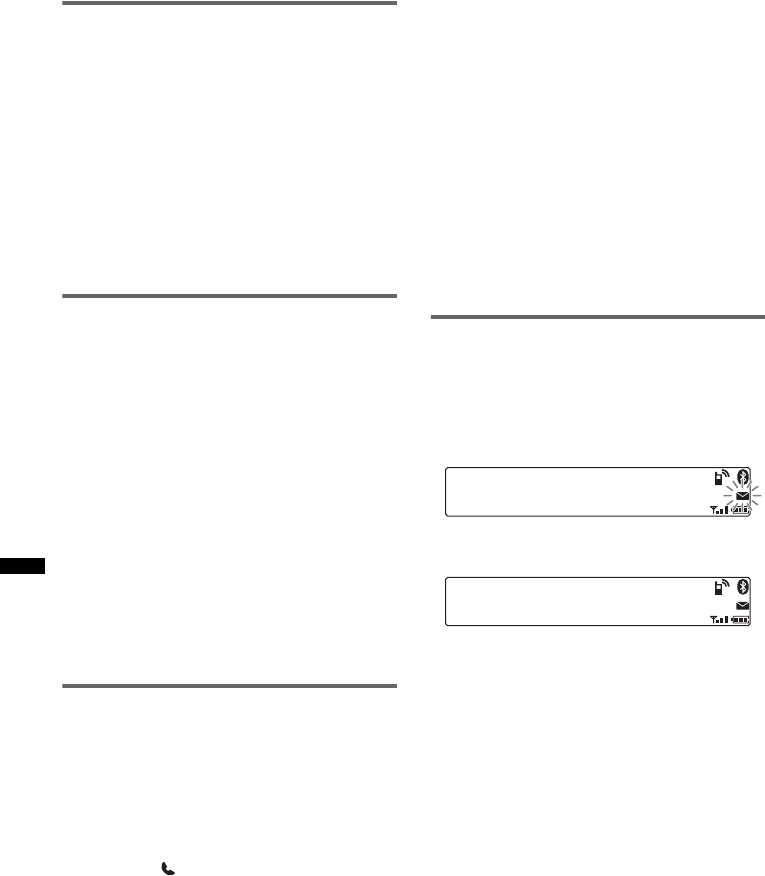
26
Transferencia de llamadas
Para activar o desactivar el dispositivo adecuado
(esta unidad/teléfono celular), compruebe lo
siguiente.
1Presione (MODE) o bien utilice el
teléfono celular.
Para obtener más información acerca de la
operación del teléfono celular, consulte el
manual del teléfono celular.
Nota
En función del teléfono celular, es posible que la
conexión de manos libres se corte cuando se intenta
realizar una transferencia de llamada.
Marcación de números
predeterminados
Se pueden almacenar como marcación de
números predeterminados hasta 6 contactos en la
agenda telefónica del teléfono celular.
1Presione (SOURCE/OFF) varias veces
hasta que aparezca “BT PHONE”.
2Mantenga presionado un botón
numérico ((1) - (6)) para seleccionar
el número predeterminado a
memorizar.
Aparece “P (número predeterminado)
WAITING”.
3Envíe los datos de la agenda
telefónica mediante la utilización del
teléfono celular.
El contacto se almacena en el número
predeterminado seleccionado.
Activación de la marcación por voz
Puede activar la marcación por voz con un
teléfono celular conectado a esta unidad
pronunciando la etiqueta de voz almacenada en
el teléfono celular y realizando una llamada a
continuación.
1Presione (SOURCE/OFF) varias veces
hasta que aparezca “BT PHONE”.
2Presione (manos libres).
Aparece “VOICE DIAL” (Marcación por
voz).
3Diga la etiqueta de voz almacenada en
el teléfono celular.
Se reconoce su voz y se realiza la llamada.
Notas
•Compruebe que la unidad y el teléfono celular están
conectados de antemano.
•Almacene una etiqueta de voz en el teléfono celular
de antemano.
•Si activa la marcación por voz con un teléfono
celular conectado a esta unidad, es posible que esta
función no funcione siempre en algunos casos.
•Los ruidos, como el motor en marcha, pueden
interferir en el reconocimiento del sonido. Para
mejorar el reconocimiento, utilice la unidad en
condiciones en que el ruido sea mínimo.
•Es posible que la marcación por voz no funcione en
algunas situaciones, en función de la eficacia de la
función de reconocimiento de voz del teléfono
celular. Para obtener más información, visite el sitio
web de soporte técnico (página 22).
Sugerencias
•Hable del mismo modo que cuando almacenó la
etiqueta de voz.
•Almacene una etiqueta de voz mientras está
sentado en el automóvil, a través de la unidad con la
fuente “BT PHONE” seleccionada.
Indicador SMS
Al conectar un teléfono celular a esta unidad, el
indicador SMS le informará acerca de los
mensajes SMS entrantes o no leídos.
Si recibe un mensaje SMS nuevo, el indicador
SMS parpadea.
Si hay algún mensaje SMS no leído, el indicador
SMS permanece encendido.
Nota
La función del indicador SMS puede depender del
teléfono celular.
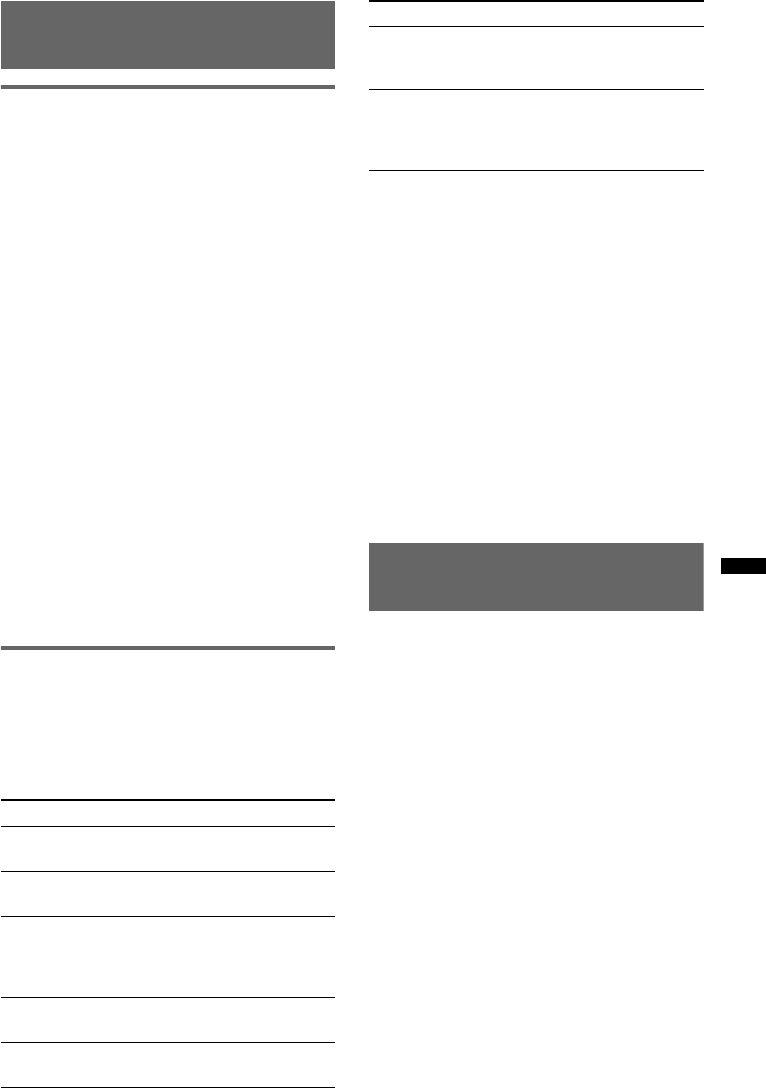
27
Transmisión continua de
música
Escuchar música desde un
dispositivo de audio
Puede escuchar música de un dispositivo de
audio en esta unidad si el dispositivo de audio es
compatible con A2DP (perfil de distribución
avanzada de audio) de la tecnología Bluetooth.
1Baje el volumen de esta unidad.
2Presione (SOURCE/OFF) varias veces
hasta que aparezca “BT AUDIO”.
3Utilice el dispositivo de audio para
iniciar la reproducción.
4Ajuste el volumen en esta unidad.
Ajuste del nivel de volumen
Puede ajustar cualquier diferencia en el nivel de
volumen entre la unidad y el dispositivo de audio
Bluetooth.
1Inicie la reproducción en el dispositivo de
audio Bluetooth con un volumen moderado.
2Seleccione el volumen habitual en la unidad.
3Presione el botón de selección.
4Gire el selector de control hasta que aparezca
“BTA VOL” y gire el selector de control de
volumen para ajustar el nivel de entrada
(“+18dB” – “0dB” – “– 8dB”).
Operación de un dispositivo de
audio con esta unidad
Puede realizar las siguientes operaciones en esta
unidad si el dispositivo de audio es compatible
con AVRCP (perfil de control remoto de audio y
vídeo) de la tecnología Bluetooth. (La operación
varía en función del dispositivo de audio.)
*1 Presione varias veces hasta que aparezca la
configuración deseada.
*2 En función del dispositivo, es posible que sea
necesario presionar dos veces.
Otras operaciones que no sean las mencionadas
anteriormente deben realizarse en el dispositivo
de audio.
Notas
•En función del dispositivo de audio, la información
como título, número de pista/tiempo, estado de
reproducción, etc., puede no aparecer en esta
unidad. La información se muestra durante la
reproducción de audio Bluetooth únicamente.
•Incluso si se cambia la fuente en esta unidad, la
reproducción del dispositivo de audio no se detiene.
Sugerencia
Puede conectar un teléfono celular compatible con
A2DP (perfil de distribución avanzada de audio) como
un dispositivo de audio y escuchar música.
Inicialización de los ajustes de
Bluetooth
Puede inicializar todos los ajustes relacionados
con Bluetooth desde esta unidad.
1Mantenga presionado (SOURCE/OFF)
durante 1 segundo para apagar.
2Mantenga presionado el botón de
selección.
Aparece la lista de menú.
3Gire el selector de control hasta que
aparezca “BT INIT” y, a continuación,
presiónelo.
Aparece la confirmación.
4Gire el selector de control hasta que
aparezca “INIT-YES” y, a continuación,
presiónelo.
“INITIAL” parpadea durante la inicialización
de los ajustes de Bluetooth.
Aparece el mensaje “COMPLETE” al
terminar la inicialización.
Nota
Cuando vaya a deshacerse de esta unidad, los
números predeterminados deben eliminarse con “BT
INIT”.
Para Realice esta acción
Reproducción
repetida Presione (1) (REP)*1
Reproducción
aleatoria Presione (2) (SHUF)*1
Omitir álbumes Presione (3)/(4) (ALBUM
–/+)
[presionar una vez para cada
álbum]
Reproducir Presione (6) (PAUSA)*2 en
esta unidad.
Pausar Presione (6) (PAUSE)*2 en
esta unidad.
Para Realice esta acción
Omitir pistas Presione SEEK –/+ (./>)
[presionar una vez para cada
pista]
Retroceder/
avanzar
rápidamente
Mantenga presionado SEEK –/+
(
.
/
>
) [mantener
presionado hasta el punto
deseado].
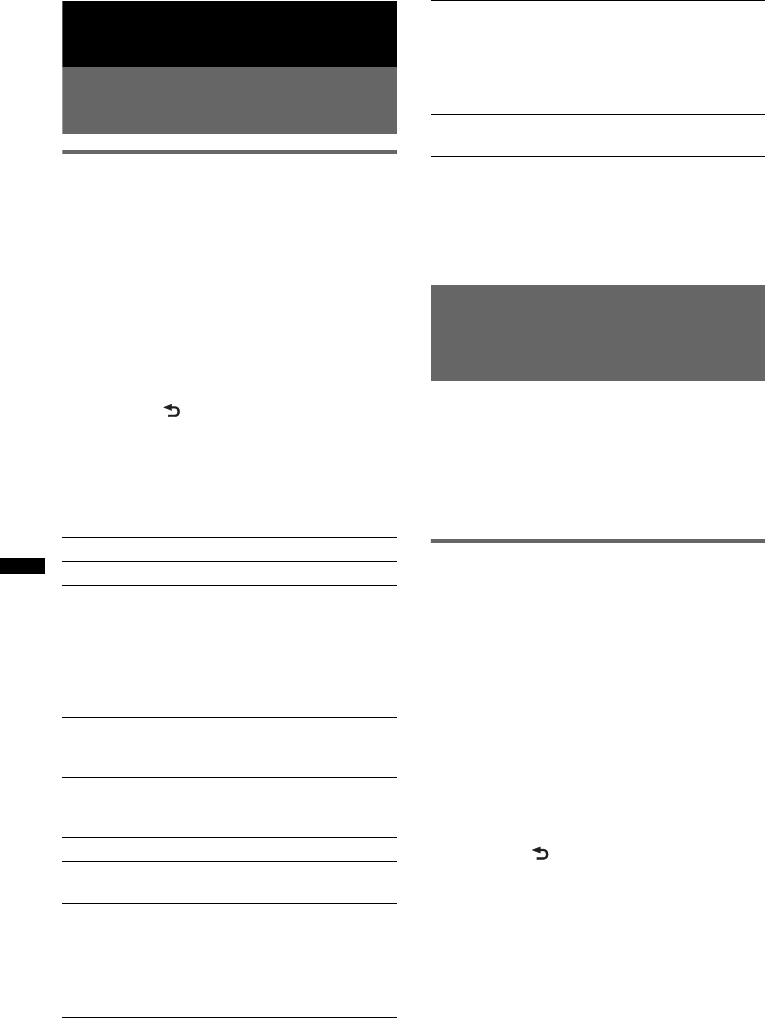
28
Ajustes de sonido y Menú de
configuración
Cambio de los ajustes de
sonido
Ajuste de las características de
sonido
1Durante la recepción/reproducción,
presione el botón de selección.
2Gire el selector de control hasta que
aparezca el elemento de menú
deseado y, a continuación, presiónelo.
3Gire el selector de control para
seleccionar el ajuste y, a continuación,
presiónelo.
El ajuste finalizó.
4Presione (BACK).
La pantalla vuelve al modo de recepción/
reproducción normal.
Se pueden ajustar los elementos siguientes
(consulte la referencia de página para obtener
más información):
Uso de funciones de sonido
sofisticadas — Advanced
Sound Engine
Advanced Sound Engine, el nuevo motor de
sonido de Sony, crea un campo de sonido ideal
en el automóvil gracias a su procesamiento
digital de sonido. Advanced Sound Engine
contiene las siguientes características: EQ7,
Posición de escucha, DM+ avanzado,
Potenciador de graves traseros.
Selección de la calidad de sonido
— Preajuste de EQ7
Se puede seleccionar una curva de ecualizador
entre 7 curvas (“XPLOD”, “VOCAL”, “EDGE”,
“CRUISE”, “SPACE”, “GRAVITY”,
“CUSTOM” u “OFF”).
1Durante la recepción/reproducción,
presione el botón de selección.
2Gire el selector de control hasta que
aparezca “EQ7 PRESET” y, a
continuación, presiónelo.
3Gire el selector de control hasta que
aparezca la curva de ecualizador que
desee y, a continuación, presiónelo.
4Presione (BACK).
La pantalla vuelve al modo de recepción/
reproducción normal.
Para cancelar la curva de ecualizador, seleccione
“OFF” en el paso 3.
Sugerencia
El ajuste de la curva de ecualizador se puede
memorizar para cada fuente.
EQ7 PRESET (página 28)
EQ7 SETTING (página 29)
POSITION
SET POSITION (Configuración de la posición
de escucha) (página 29)
ADJ POSITION*1 (Ajuste de la posición de
escucha) (página 30)
SET SW POS*1 (Configuración de la posición
del altavoz potenciador de graves) (página 30)
BALANCE
Permite ajustar el balance de sonido: “RIGHT-
15” – “CENTER” – “LEFT-15”.
FADER
Permite ajustar el nivel relativo: “FRONT-15” –
“CENTER” – “REAR-15”.
DM+ (página 30)
RB ENH (Potenciador de graves posterior)
(página 30)
SW LEVEL (Nivel del altavoz potenciador de
graves)
Permite ajustar el nivel del volumen del
potenciador de graves: “+10dB” – “0dB” –
“–10dB”.
(“ATT” aparece con el ajuste más bajo.)
AUX VOL*2 (Nivel de volumen AUX)
Permite ajustar el nivel de volumen de cada
equipo auxiliar conectado: “+18dB” – “0dB” –
“– 8dB”.
Este ajuste elimina la necesidad de ajustar el
nivel de volumen entre fuentes.
BTA VOL*3 (Nivel de volumen de audio
Bluetooth) (página 27)
*1 Se oculta cuando “SET POSITION” está ajustado
en “OFF”.
*2 Cuando está activada la fuente AUX (página 32).
*3 Cuando está activada la fuente de audio Bluetooth
(página 27).
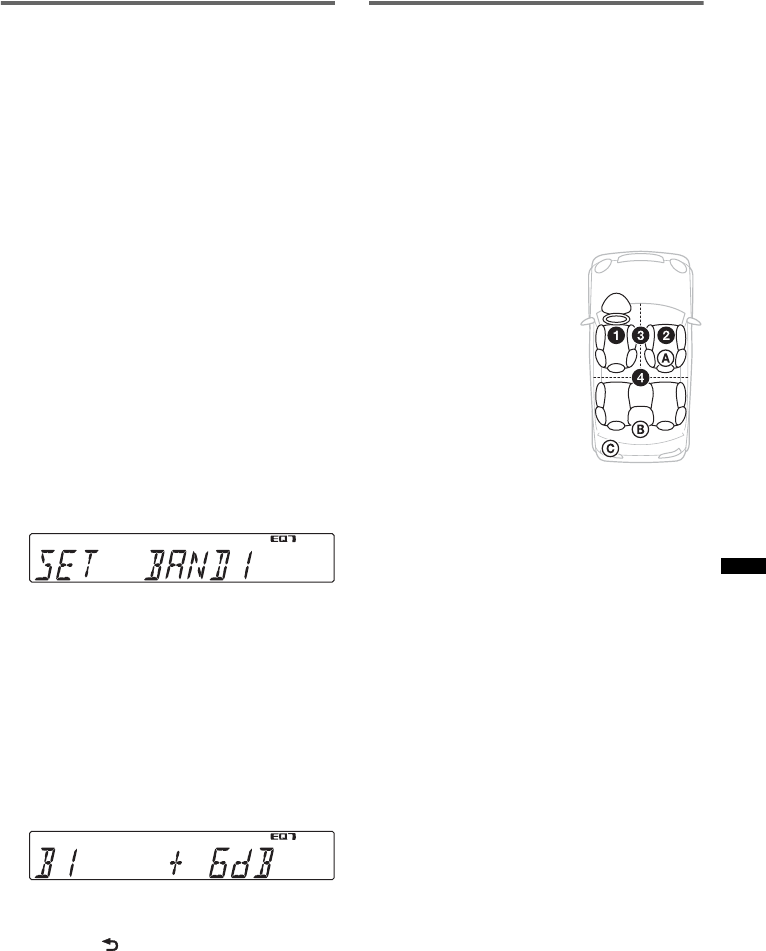
29
Personalización de la curva de
ecualizador — Ajuste de EQ7
“CUSTOM” de EQ7 le permite realizar sus
propios ajustes en el ecualizador.
1Seleccione una fuente y, a
continuación, presione el botón de
selección.
2Gire el selector de control hasta que
aparezca “EQ7 SETTING” y, a
continuación, presiónelo.
3Gire el selector de control hasta que
aparezca “BASE” y, a continuación,
presiónelo.
Puede seleccionar una curva de ecualizador
como base para una personalización posterior.
Si no desea personalizar una curva de
ecualizador preajustada, vaya directamente al
paso 5.
4Gire el selector de control para
seleccionar la curva de ecualizador y,
a continuación, presiónelo.
5Ajuste de la curva de ecualizador.
1Gire el selector de control para
seleccionar el rango de frecuencia y, a
continuación, presiónelo.
BAND1: 63 Hz
BAND2: 160 Hz
BAND3: 400 Hz
BAND4: 1 kHz
BAND5: 2.5 kHz
BAND6: 6.3 kHz
BAND7: 16.0 kHz
2Gire el selector de control para ajustar
el nivel de volumen y, a continuación,
presiónelo.
El nivel de volumen puede ajustarse en
intervalos de 1 dB entre -6 dB y +6 dB.
Repita los pasos 1 y 2 para ajustar otros
rangos de frecuencia.
6Presione (BACK) dos veces.
La curva de ecualizador se almacena en
“CUSTOM” y la pantalla regresa al modo de
recepción/reproducción normal.
Optimización de sonido por
Alineación de tiempo
— Posición de escucha
La unidad puede demorar la salida de sonido de
cada altavoz para cambiar la ubicación del
sonido a fin de adaptarse a su posición y simular
un campo de sonido natural para ofrecerle la
sensación de estar en el centro del automóvil,
independientemente del asiento que ocupe.
A continuación se enumeran las opciones de
“POSITION”.
Asimismo, puede configurar la posición
aproximada del altavoz potenciador de graves
desde su posición de escucha si:
– el altavoz potenciador de graves está
conectado.
– la posición de escucha se ajusta fuera de
“OFF”.
A continuación se enumeran las opciones de
“SET SW POS”.
“NEAR” (A): Cerca
“NORMAL” (B): Normal
“FAR” (C): Lejos
1Durante la recepción/reproducción,
presione el botón de selección.
2Gire el selector de control hasta que
aparezca “SET POSITION” y, a
continuación, presiónelo.
3Gire el selector de control para
seleccionar entre “FRONT L”, “FRONT
R”, “FRONT” o “ALL” y, a
continuación, presiónelo.
“FRONT L” (1): Frontal
izquierda
“FRONT R” (2): Frontal
derecha
“FRONT” (3): Frontal
central
“ALL” (4): En el centro del
automóvil
“OFF”: Ninguna posición
configurada
continúa en la página siguiente t
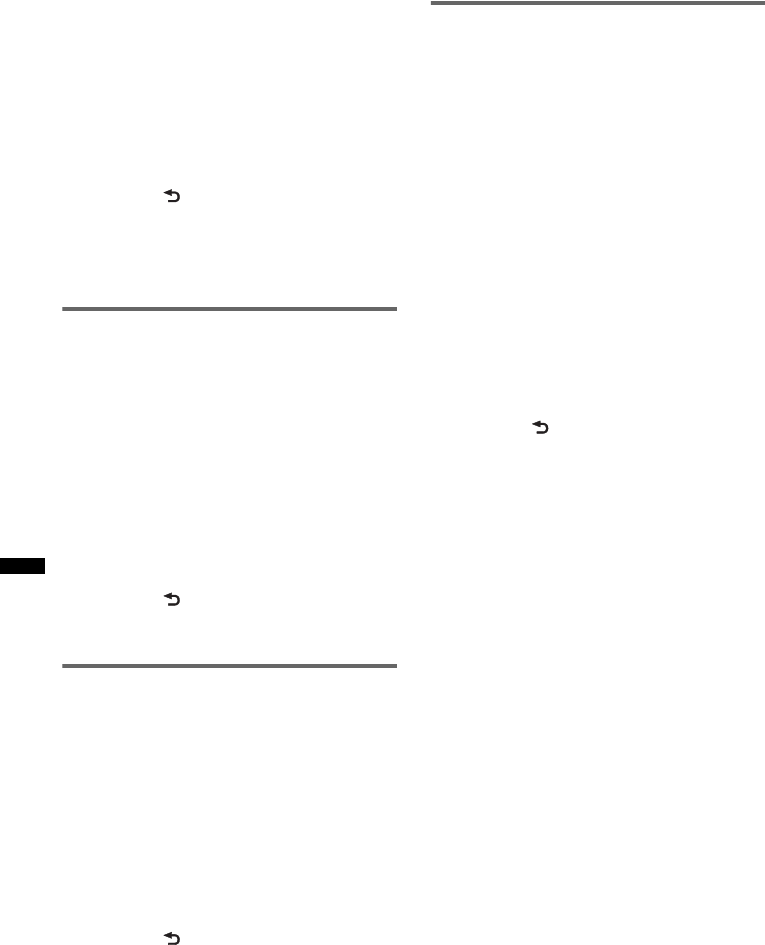
30
4Gire el selector de control hasta que
aparezca “SET SW POS” y, a
continuación, presiónelo.
Si selecciona “FRONT L”, “FRONT R”,
“FRONT” o “ALL” en el paso 3 anterior,
podrá configurar la posición del altavoz
potenciador de graves.
Gire el selector de control para seleccionar
entre “NEAR”, “NORMAL” o “FAR” y, a
continuación, presiónelo.
5Presione (BACK).
La pantalla vuelve al modo de recepción/
reproducción normal.
Para cancelar la posición de escucha, seleccione
“OFF” en el paso 3.
Ajuste de la posición de escucha
Es posible sintonizar con mayor precisión el
ajuste de la posición de escucha.
1Durante la recepción/reproducción,
presione el botón de selección.
2Gire el selector de control hasta que
aparezca “ADJ POSITION” y, a
continuación, presiónelo.
3Gire el selector de control para ajustar
la posición de escucha y, a
continuación, presiónelo.
Rango ajustable: “+ 3” – “CENTER”
(Centro) – “– 3”.
4Presione (BACK).
La pantalla vuelve al modo de recepción/
reproducción normal.
DM+ Avanzado
DM+ Avanzado mejora el sonido comprimido
digitalmente, ya que restaura las altas frecuencias
perdidas en el proceso de compresión.
1Durante la reproducción, presione el
botón de selección.
2Gire el selector de control hasta que
aparezca “DM+” y, a continuación,
presiónelo.
3Gire el selector de control para
seleccionar “ON” y, a continuación,
presiónelo.
4Presione (BACK).
La pantalla vuelve al modo de reproducción
normal.
Sugerencia
El ajuste de DM+ se puede memorizar para cada
fuente.
Uso de los altavoces posteriores
como altavoz potenciador de
graves
— Potenciador de sonidos graves
posteriores
El potenciador de sonidos graves posteriores
mejora los sonidos graves, ya que aplica el ajuste
del filtro de paso bajo (página 31) a los altavoces
posteriores. Esta función permite que los
altavoces posteriores funcionen como altavoces
potenciadores de graves si uno no está conectado.
1Durante la recepción/reproducción,
presione el botón de selección.
2Gire el selector de control hasta que
aparezca “RB ENH” y, a continuación,
presiónelo.
3Gire el selector de control para
seleccionar entre “1”, “2” o “3” y, a
continuación, presiónelo.
4Presione (BACK).
La pantalla vuelve al modo de recepción/
reproducción normal.
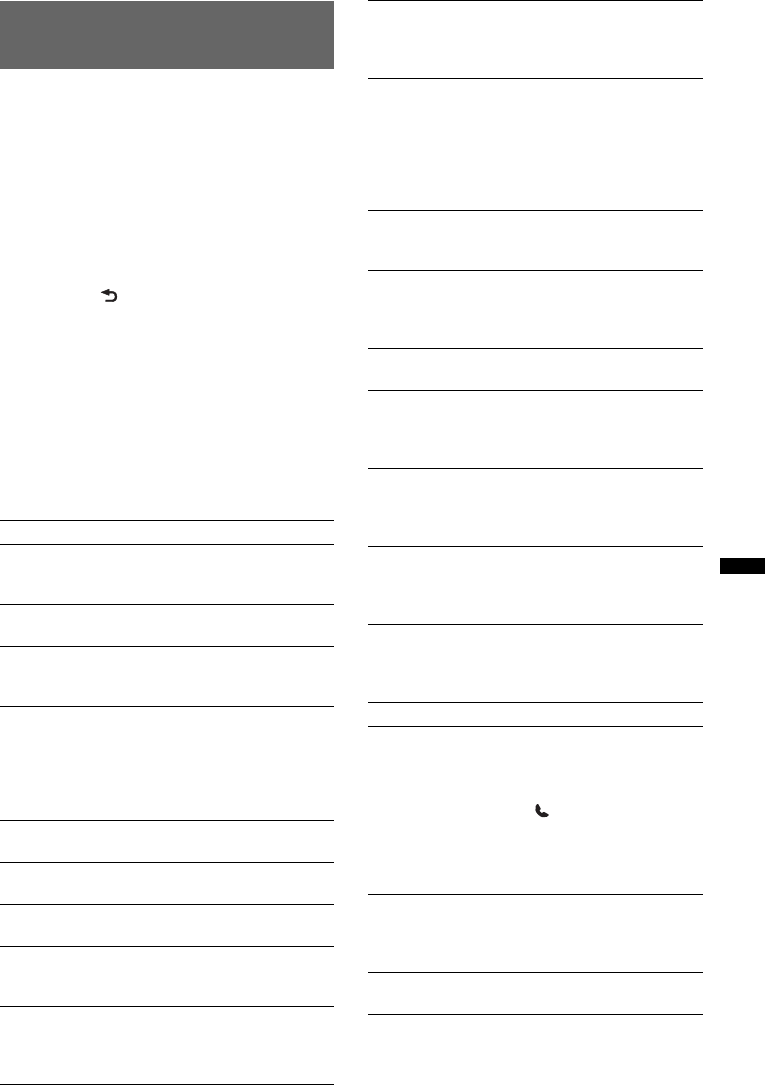
31
Definición de los elementos de
configuración — SET
1Mantenga presionado el botón de
selección.
Aparecerá la pantalla de ajustes.
2Gire el selector de control hasta que
aparezca el elemento deseado y, a
continuación, presiónelo.
3Gire el selector de control para
seleccionar el ajuste y, a continuación,
presiónelo.*
El ajuste finalizó.
4Presione (BACK).
La pantalla vuelve al modo de recepción/
reproducción normal.
*Para la configuración de CLOCK-ADJ y BTM, el
paso 4 no es necesario.
Nota
Los elementos que se muestran en pantalla variarán
en función de la fuente y del ajuste.
Se pueden ajustar los elementos siguientes
(consulte la referencia de página para obtener
más información):
*1 Cuando la unidad está apagada.
*2 Cuando se recibe FM.
CLOCK-ADJ (Ajuste del reloj) (página 7)
CT (Hora del reloj)
Activa la función CT: “ON” y “OFF”
(página 15, 16).
BEEP
Activa el sonido de los pitidos: “ON” y “OFF”.
AUX-A*1 (Audio AUX)
Activa la pantalla de fuente AUX: “ON” y
“OFF” (página 32).
AUTO OFF
Desconecta la alimentación automáticamente
una vez transcurrido un período de tiempo
deseado cuando la unidad está apagada: “NO”,
“30S (segundos)”, “30M (minutos)”, “60M
(minutos)”.
DEMO
(Demostración)
Activa la demostración: “ON” y “OFF”.
DIMMER
Cambia el brillo de la pantalla: “ON” y “OFF”.
ILLUM (Iluminación)
Cambia el color de la iluminación: “1”, “2”.
AUTO SCR (Desplazamiento automático)
Desplaza elementos automáticamente: “ON” y
“OFF”.
LOCAL (Modo de búsqueda local)
– “ON”: para que se sintonicen solamente las
emisoras de señal más intensa.
– “OFF”: para ajustar la recepción normal.
MONO*2 (Modo monoaural)
Selecciona el modo de recepción monoaural
para mejorar una recepción de FM de mala
calidad: “ON” y “OFF”.
ZAP TIME (Tiempo de reproducción del modo
Zappin)
Selecciona el tiempo de reproducción de la
función ZAPPIN.
– “Z.TIME-1 (unos 6 segundos)”, “Z.TIME-2
(unos 15 segundos)” y “Z.TIME-3 (unos
30 segundos)”.
ZAP BEEP (Pitido del modo Zappin)
Sonido de pitido entre pasaje de pista: “ON” y
“OFF”.
LPF FREQ (Frecuencia de filtro paso bajo)
Selecciona la frecuencia de corte del altavoz
potenciador de graves: “50Hz”, “60Hz”,
“80Hz”, “100Hz” y “120Hz”.
LPF SLOP (Pendiente del filtro paso bajo)
Selecciona la pendiente LPF: “1”, “2”, “3”.
SW PHASE (Fase del altavoz potenciador de
graves)
Selecciona la fase del altavoz potenciador de
graves: “NORM” y “REV”.
HPF FREQ (Frecuencia del filtro paso alto)
Selecciona la frecuencia de corte del altavoz
frontal/posterior: “OFF”, “50Hz”, “60Hz”,
“80Hz”, “100Hz” y “120Hz”.
HPF SLOP (Pendiente del filtro paso alto)
Selecciona la pendiente HPF (efectivo
únicamente cuando HPF FREQ no está activado
en “OFF”): “1”, “2”, “3”.
LOUDNESS (Sonoridad dinámica)
Permite reforzar los graves y agudos para
obtener un sonido claro con niveles de volumen
bajos: “ON” y “OFF”.
BTM (página 15)
AUTO ANS*1 (Respuesta automática)
Permite responder a una llamada entrante
automáticamente.
– “OFF”: para no responder automáticamente
hasta que se presiona (manos libres).
– “1”: para responder automáticamente después
de 3 segundos.
– “2”: para responder automáticamente después
de 10 segundos.
RINGTONE (Tono de llamada)*1
Utiliza el tono de llamada de esta unidad o el
teléfono celular conectado: “1 (esta unidad)” y
“2 (teléfono celular)”.
BT INIT*1 (Inicialización de Bluetooth)
(página 27)
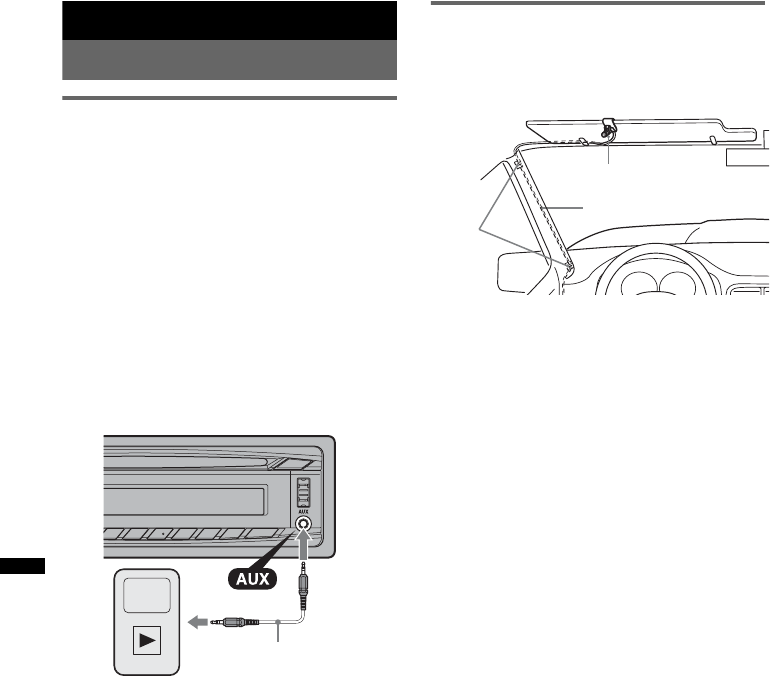
32
Otras funciones
Uso de equipo opcional
Equipo de audio auxiliar
Si conecta un dispositivo de audio portátil
opcional a la toma de entrada AUX (minitoma
estéreo) de la unidad y simplemente selecciona la
fuente, podrá escuchar por los altavoces del
automóvil. Puede ajustar cualquier diferencia en
el nivel de volumen entre la unidad y el
dispositivo de audio portátil. Siga este
procedimiento:
Conexión del dispositivo de audio
portátil
1Apague el dispositivo de audio portátil.
2Baje el volumen de la unidad.
3Conéctelo a la unidad.
*Asegúrese de utilizar una clavija recta.
Ajuste del nivel de volumen
Asegúrese de ajustar el volumen de cada equipo
de audio conectado antes de la reproducción.
1Baje el volumen de la unidad.
2Presione (SOURCE/OFF) varias veces hasta
que aparezca “AUX”.
Después de eso, aparece “AUX FRONT IN”.
3Inicie la reproducción en el dispositivo de
audio portátil con un volumen moderado.
4Seleccione el volumen habitual en la unidad.
5Ajuste el nivel de entrada (página 28).
Micrófono externo XA-MC10
Si conecta un micrófono externo opcional al
conector de entrada del micrófono, puede
mejorar la calidad de audio cuando habla a través
de esta unidad.
Nota
Conecte el XA-MC10 como micrófono externo. Es
posible que no pueda llamar o se produzcan fallos de
funcionamiento si hay otro dispositivo conectado.
Cable de
conexión* (no
suministrado)
Micrófono externo
Cable de conexión
Abraza-
deras
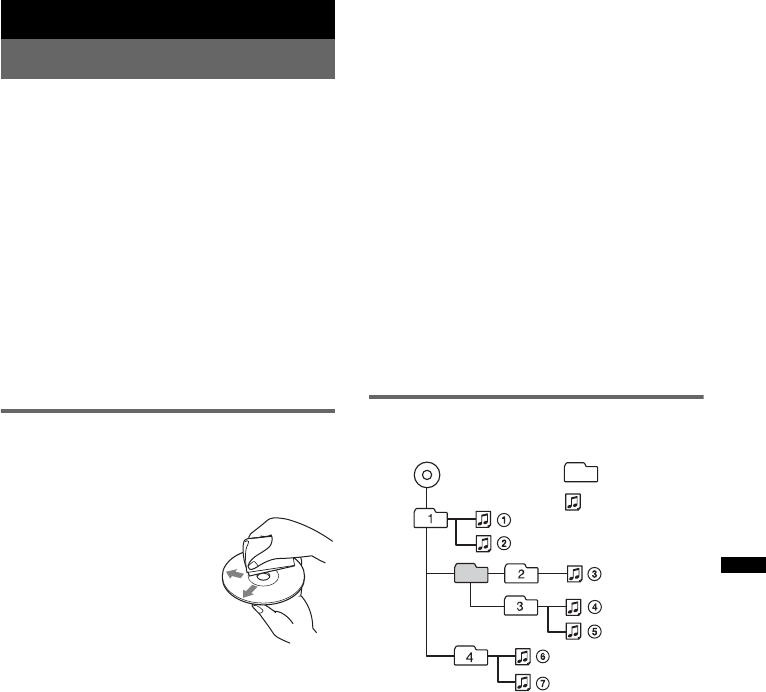
33
Información complementaria
Precauciones
• Deje que la unidad se enfríe antes de usarla si el
automóvil ha estado estacionado bajo la luz
directa del sol.
• La antena motorizada se extiende
automáticamente.
Condensación de humedad
Si se produce condensación de humedad en el
interior de la unidad, extraiga el disco y espere una
hora aproximadamente hasta que se haya secado la
unidad. De lo contrario, la unidad no funcionará
correctamente.
Para mantener una alta calidad de
sonido
No derrame ningún tipo de líquido sobre la unidad o
los discos.
Notas sobre los discos
• No exponga los discos a la luz solar directa ni a
fuentes de calor como, por ejemplo, conductos de
aire caliente, ni los deje en el automóvil
estacionado bajo la luz solar directa.
• Antes de reproducir los discos,
límpielos con un paño de
limpieza. Hágalo desde el
centro hacia los bordes. No
utilice disolventes como
bencina, diluyentes ni
productos de limpieza
disponibles en el mercado.
• Esta unidad se diseñó para
reproducir discos que cumplen con el estándar
Compact Disc (CD). Los DualDisc y otros discos
de música codificados con tecnologías de
protección de derechos de autor no cumplen el
estándar Compact Disc (CD), por lo que no
podrán reproducirse con esta unidad.
•Discos que NO se pueden reproducir en
esta unidad
– Discos con etiquetas, autoadhesivos o cinta
adhesiva o papel enganchados. Si utiliza este
tipo de discos, puede provocar una falla de
funcionamiento o dañar el disco.
– Discos con formas no estandarizadas (por
ejemplo, formas de corazón, cuadrado o
estrella). Si lo intenta, puede dañar la unidad.
– Discos de 8 cm.
Notas sobre los discos CD-R/CD-RW
• Cantidad máxima de: (sólo CD-R/CD-RW)
– carpetas (álbumes): 150 (incluida la carpeta raíz)
– archivos (pistas) y carpetas: 300 (pueden ser
menos de 300 si los nombres de carpetas o
archivos contienen muchos caracteres)
– caracteres visualizables del nombre de una
carpeta o archivo: 32 (Joliet)/64 (Romeo)
• Si un disco multisesión empieza con una sesión
CD-DA, se reconoce como un disco CD-DA y las
otras sesiones no se reproducen.
•Discos que NO se pueden reproducir en
esta unidad
– CD-R/CD-RW de calidad de grabación
deficiente.
– CD-R/CD-RW grabados con un dispositivo de
grabación no compatible.
– CD-R/CD-RW no finalizados correctamente.
– CD-R/CD-RW que no se hayan grabado en
formato CD de música o en formato MP3 que
cumpla la norma ISO9660 nivel 1/nivel 2, Joliet/
Romeo o multisesión.
Orden de reproducción de los
archivos MP3/WMA/AAC
Carpeta
(álbum)
Archivo MP3/
WMA/AAC
(pista)
MP3/WMA/AAC

34
Acerca de iPod
Acerca de la función Bluetooth
¿Qué es la tecnología Bluetooth?
• Bluetooth es una tecnología inalámbrica de corto
alcance que permite la comunicación de datos
inalámbrica entre dispositivos digitales como, por
ejemplo, un teléfono celular y un conjunto de
auriculares y micrófono. La tecnología
inalámbrica Bluetooth funciona dentro de un
alcance de aproximadamente 10 metros. La
conexión de dos dispositivos es común, pero
algunos dispositivos se pueden conectar a varios
dispositivos al mismo tiempo.
• No tiene que utilizar un cable para la conexión
debido a que la tecnología Bluetooth es una
tecnología inalámbrica, ni tampoco es necesario
que los dispositivos estén enfrentados, tal como
con la tecnología infrarroja. Por ejemplo, puede
utilizar dicho dispositivo en una bolsa o en el
bolsillo.
• La tecnología Bluetooth es una norma
internacional compatible con millones de
empresas de todo el mundo, y empleada por
diversas empresas a nivel mundial.
Acerca de la comunicación Bluetooth
• La tecnología inalámbrica Bluetooth funciona
dentro de un alcance de aproximadamente
10 metros.
El alcance de comunicación máximo puede variar
en función de los obstáculos (personas, objetos
metálicos, paredes, etc.) o del entorno
electromagnético.
• Es posible que las siguientes condiciones afecten a
la sensibilidad de la comunicación Bluetooth.
– Hay un obstáculo como una persona, un objeto
metálico o una pared entre esta unidad y el
dispositivo Bluetooth.
– Se está utilizando cerca de la unidad un
dispositivo con una frecuencia de 2,4 GHz
como, por ejemplo, un dispositivo LAN
inalámbrico, un teléfono inalámbrico o un horno
microondas.
• Debido a que los dispositivos Bluetooth y las redes
LAN inalámbricas (IEEE802.11b/g) utilizan la
misma frecuencia, es posible que se produzcan
interferencias de microondas que provoquen el
deterioro de la velocidad de la comunicación,
ruidos o la interrupción de la conexión si se utiliza
la unidad cerca de un dispositivo LAN
inalámbrico. En tal caso, lleve a cabo las
siguientes operaciones.
– Utilice la unidad a una distancia mínima de
10 metros del dispositivo LAN inalámbrico.
– Si se utiliza la unidad a una distancia inferior a
10 metros de un dispositivo LAN inalámbrico,
apague este último.
– Instale la unidad y el dispositivo Bluetooth lo
más cerca posible.
• Las microondas que emiten los dispositivos
Bluetooth pueden afectar al funcionamiento de
dispositivos médicos electrónicos. Apague la
unidad y los demás dispositivos Bluetooth en los
siguientes lugares ya que, de lo contrario, podría
producirse un accidente:
– donde exista gas inflamable, en hospitales,
trenes, aviones o gasolineras
– cerca de puertas automáticas o de una alarma
contra incendios
• Esta unidad es compatible con funciones de
seguridad que cumplen con el estándar Bluetooth
para proporcionar una conexión segura durante la
utilización de la tecnología inalámbrica Bluetooth,
aunque es posible que la seguridad no sea
suficiente en función del ajuste. Tome
precauciones cuando utilice la tecnología
inalámbrica Bluetooth.
• No se aceptan responsabilidades por la pérdida de
información que pudiera producirse durante una
comunicación Bluetooth.
• Puede conectarse a los siguientes modelos de
iPod. Actualice sus dispositivos iPod a la última
versión de software antes de utilizarlos.
Made for
– iPod touch (2ª generación)
– iPod touch (1ª generación)
– iPod classic
– iPod con video*
– iPod nano (5ª generación)
– iPod nano (4ª generación)
– iPod nano (3ª generación)
– iPod nano (2ª generación)
– iPod nano (1ª generación)*
– iPhone 3GS
– iPhone 3G
– iPhone
* El control del pasajero no está disponible para
iPod nano (1
a
generación) ni para iPod con video.
• “Made for iPod” y “Made for iPhone” indican
que un accesorio electrónico se diseñó para
conectarse específicamente a los dispositivos
iPod y iPhone respectivamente, y que el
fabricante obtuvo la certificación necesaria para
que cumpla con los estándares de rendimiento de
Apple.
• Apple no es responsable del funcionamiento de
este dispositivo o de su cumplimiento con los
estándares de seguridad y regulatorios.
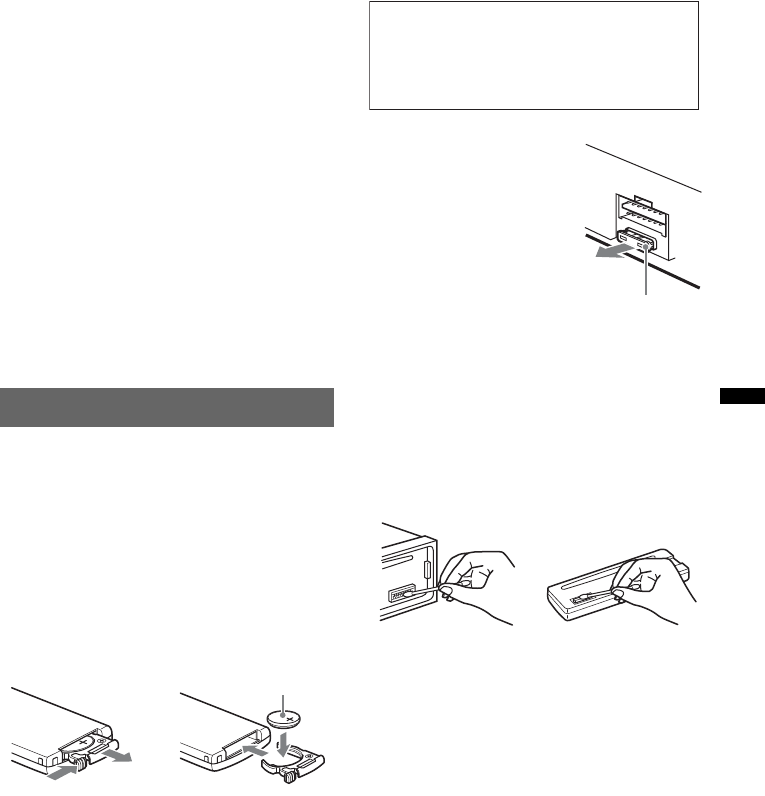
35
• La conexión con todos los dispositivos Bluetooth
no puede garantizarse.
– Es necesario disponer de un dispositivo que
disponga de la función Bluetooth para cumplir
con el estándar Bluetooth especificado por
Bluetooth SIG, y que sea autenticado.
– Aunque el dispositivo conectado cumpla con el
estándar Bluetooth mencionado anteriormente,
es posible que algunos dispositivos no se
conecten o no funcionen correctamente según
sus funciones o especificaciones.
– Mientras se habla por teléfono manos libres, es
posible que se produzcan ruidos que dependen
del dispositivo o del entorno de la comunicación.
• En función del dispositivo que vaya a conectar, es
posible que la comunicación tarde unos instantes
en iniciarse.
Otros
• Es posible que el dispositivo Bluetooth no
funcione en teléfonos celulares, en función de las
condiciones de las ondas de radio y del lugar
donde se utilice el equipo.
• Si siente malestar después de utilizar el dispositivo
Bluetooth, deje de utilizarlo inmediatamente. Si el
problema persiste, consulte con el distribuidor
Sony más próximo.
Si desea realizar alguna consulta o solucionar algún
problema relativo a la unidad que no se trate en este
manual, póngase en contacto con el distribuidor
Sony más cercano.
Mantenimiento
Sustitución de la pila de litio del
control remoto de tarjeta
En condiciones normales, la pila dura
aproximadamente 1 año. (La duración puede ser
menor en función de las condiciones de uso.)
El alcance del control remoto de tarjeta
disminuye a medida que se agota la pila.
Sustitúyala por una pila de litio CR2025 nueva.
El uso de cualquier otra pila podría provocar un
incendio o una explosión.
Notas sobre la pila de litio
•Mantenga la pila de litio fuera del alcance de los
niños. Si se ingiriese, póngase en contacto
inmediatamente con un médico.
•Limpie la pila con un paño seco para garantizar un
contacto óptimo.
•Asegúrese de observar la polaridad correcta al
instalarla.
•No sujete la pila con pinzas metálicas, ya que podría
producirse un cortocircuito.
Sustitución del fusible
Al sustituir el fusible, asegúrese
de utilizar uno cuyo amperaje
coincida con el especificado en
el original. Si el fusible se
funde, verifique la conexión de
alimentación y sustitúyalo. Si el
fusible vuelve a fundirse
después de sustituirlo, es
posible que exista alguna falla
de funcionamiento interno. En
tal caso, consulte con el
distribuidor Sony más cercano.
Limpieza de los conectores
Es posible que la unidad no funcione correctamente
si los conectores entre ésta y el panel frontal están
sucios. Para evitar esta situación, extraiga el panel
frontal (página 7) y limpie los conectores con un
hisopo de algodón. Realice esta operación con
suavidad. De lo contrario, los conectores podrían
resultar dañados.
Notas
•Por razones de seguridad, apague el motor antes de
limpiar los conectores y extraiga la llave del
interruptor de encendido.
•No toque nunca los conectores directamente con los
dedos ni con ningún dispositivo metálico.
1
2
Lado + hacia arriba
c
ADVERTENCIA
La pila puede explotar si no se emplea
adecuadamente.
No recargue la pila; tampoco la desmonte ni
la arroje al fuego.
Fusible (10 A)
Unidad principal Parte posterior
del panel frontal
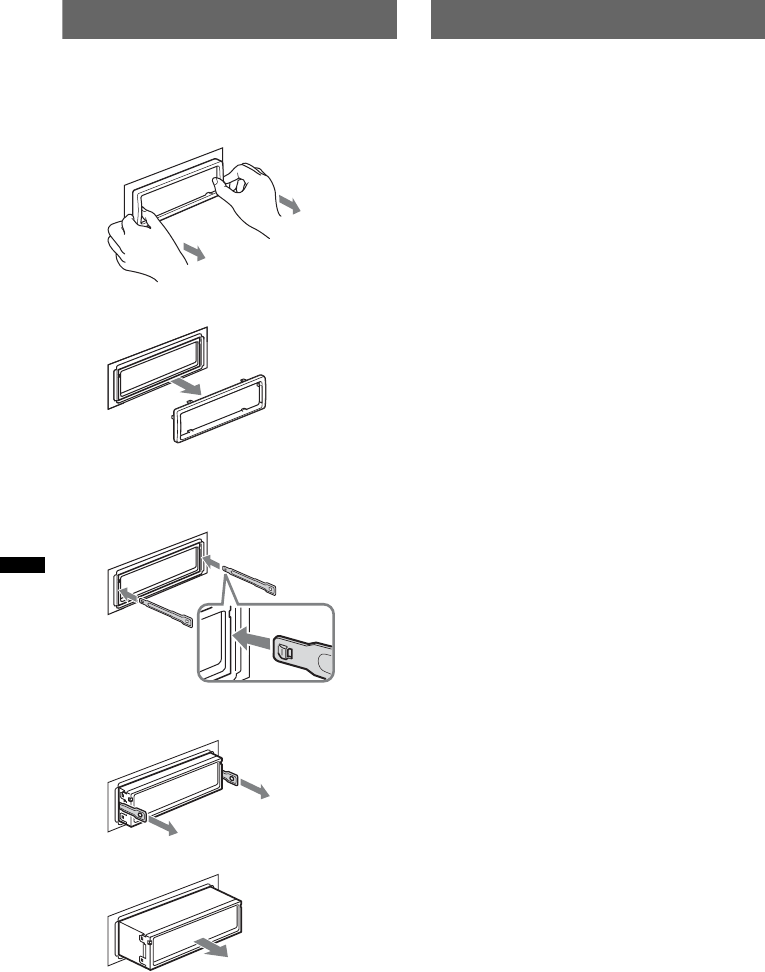
36
Extracción de la unidad
1Extraiga el marco de protección.
1Extraiga el panel frontal (página 7).
2Sujete el marco de protección por ambos
bordes y extráigalo.
2Extraiga la unidad.
1Inserte las dos llaves de liberación
simultáneamente hasta escuchar un clic.
2Tire de las llaves de liberación para extraer
la unidad.
3Deslice la unidad para extraerla del marco.
Especificaciones
Sección del sintonizador
FM
Rango de sintonización: 87,5 – 107,9 MHz
Terminal de antena: conector de antena externa
Frecuencia intermedia: 150 kHz
Sensibilidad útil: 10 dBf
Selectividad: 75 dB a 400 kHz
Relación señal-ruido: 70 dB (mono)
Separación: 40 dB a 1 kHz
Respuesta de frecuencia: 20 – 15.000 Hz
AM
Rango de sintonización: 530 – 1.710 kHz
Terminal de antena: conector de antena externa
Frecuencia intermedia: 25 kHz
Sensibilidad: 26 µV
Sección del reproductor de CD
Relación señal-ruido: 120 dB
Respuesta de frecuencia: 10 – 20.000 Hz
Fluctuación y trémolo: inferior al límite medible
Sección del reproductor USB
Interfaz: USB (velocidad máxima)
Corriente máxima: 500 mA
Comunicación inalámbrica
Sistema de comunicación:
Especificación Bluetooth versión 2.1 + EDR
Salida:
Potencia estándar Bluetooth clase 2 (máx.
+4 dBm)
Alcance de comunicación máximo:
Línea de visión de aprox. 10 metros*1
Banda de frecuencia:
Banda de 2,4 GHz (entre 2,4000 y 2,4835 GHz)
Método de modulación: FHSS
Perfiles Bluetooth compatibles*2:
A2DP (Perfil de distribución avanzada de audio)
1.2
AVRCP (Perfil de control remoto de audio y vídeo)
1.3
HFP (Perfil manos libres) 1.5
PBAP (Perfil de acceso a la agenda telefónica)
OPP (Perfil Push de objetos)
*1 El alcance real varía en función de factores como
los obstáculos situados entre los dispositivos, los
campos magnéticos que existen alrededor de los
hornos microondas, la electricidad estática, la
sensibilidad de la recepción, el rendimiento de la
antena, el sistema operativo, la aplicación de
software, etc.
*2 Los perfiles estándar Bluetooth indican el objetivo
de la comunicación Bluetooth entre dispositivos.
x
El gancho
debe mirar
hacia adentro.

37
Sección del amplificador de potencia
Salida: salidas de altavoces
Impedancia de altavoces: 4 a 8 ohmios
Salida máxima de potencia: 52 W × 4 (a 4 ohmios)
Generales
Salidas:
Terminal de salidas de audio (frontal/posterior)
Terminal de salida de altavoz potenciador de
graves (mono)
Terminal de control del relé de la antena
motorizada
Terminal de control del amplificador de potencia
Entradas:
Terminal de entrada de control BUS
Terminal de entrada de audio BUS
Terminal de control ATT de teléfono
Terminal de entrada del control remoto
Terminal de entrada de la antena
Terminal de entrada de MIC
Toma de entrada AUX (minitoma estéreo)
Conector de entrada de señal USB
Requisitos de alimentación: batería de automóvil de
12 V CC (masa negativa)
Dimensiones: aprox. 178 × 50 × 179 mm
(an/al/prf)
Dimensiones de montaje: aprox. 182 × 53 × 162 mm
(an/al/prf)
Peso: aprox. 1,2 kg
Accesorios suministrados:
Control remoto de tarjeta: RM-X172
Componentes de instalación y conexiones
(1 juego)
Equipo y accesorios opcionales:
Cable BUS (suministrado con un cable con
terminales RCA):
RC-61 (1 m), RC-62 (2 m)
Cable de conexión USB para iPod: RC-100IP
Sintonizador HD Radio™: XT-100HD
Micrófono externo: XA-MC10
Es posible que su distribuidor no comercialice
algunos de los accesorios que figuran en la lista
anterior. Pídale información detallada.
El diseño y las especificaciones están sujetos a
cambios sin previo aviso.
Solución de problemas
La siguiente lista de comprobación le ayudará a
solucionar los problemas que puedan producirse con
la unidad.
Antes de consultarla, revise los procedimientos de
conexión y de funcionamiento.
Si no se resuelve el problema, visite el siguiente
sitio web de soporte técnico.
Generales
La unidad no recibe alimentación.
• Revise la conexión o el fusible.
• Si la unidad está apagada y la pantalla desaparece, no
se puede operar con el control remoto.
tEncienda la unidad.
La antena motorizada no se extiende.
La antena motorizada no dispone de una caja de relé.
No se emite el sonido.
• La función ATT está activada o la función ATT de
teléfono (cuando se conecta el cable de interfaz de un
teléfono para automóvil al cable ATT) está activada.
• La posición del control de equilibrio “FADER” no
está ajustada para un sistema de 2 altavoces.
• El dispositivo de audio Bluetooth se encuentra en
pausa.
tCancele la pausa.
No se escuchan pitidos.
• El sonido de los pitidos está cancelado (página 31).
• Se encuentra conectado un amplificador de potencia
opcional y no está usando el amplificador integrado.
El contenido de la memoria se borró.
• Presionó el botón RESET.
tVuelva a almacenar los datos en la memoria.
• Se desconectó el cable de fuente de alimentación o la
batería, o no están conectados correctamente.
Las emisoras almacenadas y la hora correcta
se borraron.
El fusible se fundió.
Se escucha ruido cuando se cambia la
posición de la llave de encendido.
Los cables no se conectaron en forma correcta al
conector de alimentación auxiliar del automóvil.
Durante la reproducción o la recepción, el
modo demostración se inicia.
Si no se realiza ninguna operación durante 5 minutos y
la opción “DEMO-ON” está activada, se iniciará el
modo de demostración.
tAjuste “DEMO-OFF” (página 31).
continúa en la página siguiente t
Sitio Web de soporte técnico en línea
http://esupport.sony.com
http://www.sony.com/mobileAV
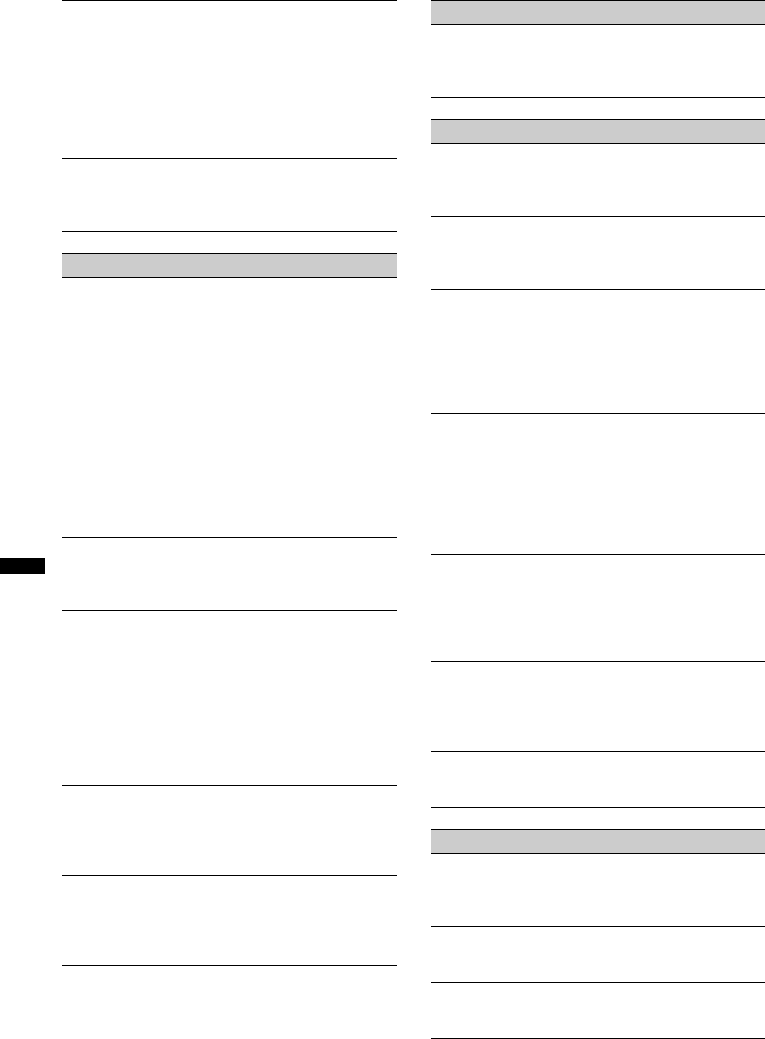
38
Las indicaciones desaparecen de la pantalla o
no aparecen en ella.
• El atenuador está ajustado en “DIM-ON”
(página 31).
• La pantalla se apaga si mantiene presionado
(SOURCE/OFF).
tPresione (SOURCE/OFF) en la unidad hasta que
se ilumine la pantalla.
• Los conectores están sucios (página 35).
La función Auto Off no funciona.
La unidad está encendida. La función Auto Off se
activa después de apagar la unidad.
tApague la unidad.
Recepción de radio
No es posible recibir las emisoras.
Hay ruidos que obstaculizan el sonido.
• La conexión no es correcta.
tConecte un cable de control de antena motorizada
(azul) o un cable de fuente de alimentación
auxiliar (rojo) al cable de fuente de alimentación
del amplificador de antena del automóvil
(solamente cuando el automóvil tenga una antena
de FM/AM integrada en el cristal posterior o
lateral).
tCompruebe la conexión de la antena del
automóvil.
tSi la antena motorizada no se extiende,
compruebe la conexión del cable de control de la
antena motorizada.
No es posible utilizar la sintonización
programada.
• Almacene la frecuencia correcta en la memoria.
• La señal de emisión es demasiado débil.
No es posible utilizar la sintonización
automática.
• El ajuste del modo de búsqueda local no es correcto.
tLa sintonización se detiene con demasiada
frecuencia:
Ajuste “LOCAL-ON” (página 31).
tLa sintonización no se detiene en una emisora:
Ajuste “LOCAL-OFF” (página 31).
• La señal de emisión es demasiado débil.
tUse la sintonización manual.
Durante la recepción de FM, la indicación “ST”
parpadea.
• Sintonice la frecuencia con precisión.
• La señal de emisión es demasiado débil.
tAjuste “MONO-ON” (página 31).
Un programa de FM emitido en estéreo se
escucha en monoaural.
La unidad se encuentra en el modo de recepción
monoaural.
tAjuste “MONO-OFF” (página 31).
RDS
PTY muestra “- - - - - - - -”.
• La emisora actual no es una emisora RDS.
• No se recibieron datos RDS.
• La emisora no especifica el tipo de programa.
Reproducción de CD
No es posible insertar el disco.
• Ya hay un disco insertado.
• El disco se insertó a la fuerza al revés o de forma
incorrecta.
El disco no se reproduce.
• Disco defectuoso o sucio.
• Los discos CD-R/CD-RW no son para audio
(página 33).
No es posible reproducir archivos MP3/WMA/
AAC.
El disco no es compatible con el formato y la versión
de MP3/WMA/AAC. Para obtener más información
acerca de los discos y formatos que se pueden
reproducir, visite el sitio Web de soporte técnico en
línea.
Los archivos MP3/WMA/AAC tardan más
tiempo en reproducirse que los demás.
El inicio de la reproducción de los siguientes discos
tarda algo más de tiempo.
– disco grabado con una estructura de árbol
complicada.
– disco grabado en Multi Session.
– disco al que es posible añadir datos.
Los elementos de pantalla no se desplazan.
• En el caso de discos con muchos caracteres, es
posible que éstos no se desplacen.
• “AUTO SCR” está ajustado en “OFF”.
tAjuste “A.SCRL-ON” (página 31).
tMantenga presionado (DSPL) (SCRL).
Se producen saltos de sonido.
• La instalación no es correcta.
tInstale la unidad en un ángulo inferior a 45° en
una parte firme del automóvil.
• Disco defectuoso o sucio.
Los botones de operación no funcionan.
El disco no se expulsa.
Presione el botón RESET (página 6).
Reproducción USB
No es posible reproducir elementos a través de
un concentrador USB.
Esta unidad no puede reconocer dispositivos USB a
través de un concentrador USB.
No puede reproducir elementos.
Un dispositivo USB no funciona.
tVuelva a conectarlo.
El dispositivo USB tarda en reproducir.
El dispositivo USB contiene archivos con una
estructura de árbol compleja.
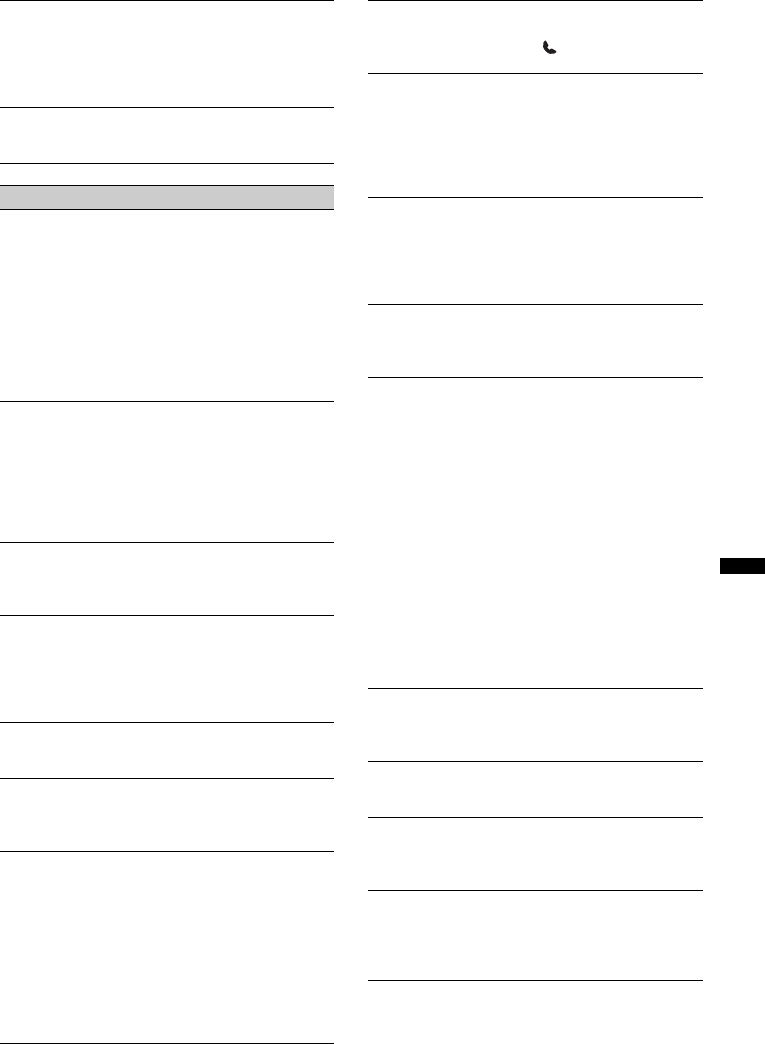
39
Suena un pitido.
El dispositivo USB se ha desconectado durante la
reproducción.
tAntes de desconectar un dispositivo USB,
asegúrese de que se ha detenido la reproducción
para proteger los datos.
El sonido es discontinuo.
Es posible que la discontinuidad del sonido se deba a
una tasa alta de bits de más de 320 kbps.
Función Bluetooth
El dispositivo de conexión no puede detectar
esta unidad.
• Antes de realizar el emparejamiento, ajuste esta
unidad al modo de espera de emparejamiento.
• Cuando está conectada a un dispositivo Bluetooth,
esta unidad no puede detectarse desde otro
dispositivo. Desconecte la conexión actual y busque
esta unidad desde otro dispositivo.
• Cuando se realiza el emparejamiento del dispositivo,
ajuste la salida de señal Bluetooth como activada
(página 23).
No es posible establecer la conexión.
• Conéctese a esta unidad desde un dispositivo
Bluetooth o viceversa. La conexión se controla desde
un solo lado (esta unidad o dispositivo Bluetooth),
pero no ambas opciones.
• Consulte los procedimientos de emparejamiento y
conexión en el manual del otro dispositivo, etc., y
lleve a cabo la operación de nuevo.
El nombre del dispositivo detectado no
aparece.
En función del estado del otro dispositivo, es posible
que no se pueda obtener el nombre.
Sin tono de llamada.
• Ajuste el volumen en el nivel “VOL RING”.
• Según el dispositivo de conexión, el tono de llamada
podría no enviarse correctamente.
tAjuste “RINGTONE” (Tono de llamada) como
“R.TONE-1” (página 24).
El volumen de la voz de la persona que habla
es bajo.
Ajuste el volumen de volumen.
Un interlocutor de la llamada dice que el
volumen está demasiado bajo o alto.
Ajuste el volumen correspondiente mediante el ajuste
Mic Gain (Ganancia de micrófono) (página 25).
Se produce eco o ruidos en las
conversaciones telefónicas.
• Disminuya el volumen.
• Ajuste el modo EC/NC como “EC/NC-1” o
“EC/NC-2” (página 25).
• Si se encuentra en un lugar con un ruido ambiental
elevado, intente reducirlo.
Por ejemplo: si hay una ventanilla abierta a través de
la que se escucha un fuerte ruido del tráfico, cierre la
ventanilla. Si el sistema de aire acondicionado emite
mucho ruido, apáguelo.
El teléfono no está conectado.
Cuando se reproduce audio Bluetooth, el teléfono no
se conecta aunque presione (manos libres).
tConéctese desde el teléfono.
La calidad del sonido del teléfono es
deficiente.
La calidad del sonido telefónico depende de las
condiciones de recepción del teléfono celular.
tDesplace el automóvil hasta un lugar en el que
mejore la recepción de la señal del teléfono celular
si ésta es deficiente.
El volumen del dispositivo de audio conectado
es bajo (alto).
El nivel de volumen varía en función del dispositivo de
audio.
tAjuste el volumen del dispositivo de audio
conectado o esta unidad.
No se escucha el sonido del dispositivo de
audio Bluetooth.
El dispositivo de audio se encuentre en modo de pausa.
tCancele la pausa del dispositivo de audio.
El sonido se interrumpe durante la
reproducción de un dispositivo de audio
Bluetooth.
• Reduzca la distancia entre la unidad y el dispositivo
de audio Bluetooth.
• Si el dispositivo de audio Bluetooth se guarda en una
caja que interrumpe la señal, retire el dispositivo de
audio de la misma mientras lo utiliza.
• Algunos dispositivos Bluetooth u otros dispositivos
que emiten ondas de radio se utilizan en las
cercanías.
tApague los demás dispositivos.
tAumente la distancia con respecto a los demás
dispositivos.
• El sonido de reproducción se interrumpe
momentáneamente mientras la conexión entre esta
unidad y el teléfono celular se está efectuando. Esto
no constituye un fallo de funcionamiento.
El dispositivo de audio Bluetooth conectado
no se puede controlar.
Compruebe que el dispositivo de audio Bluetooth
conectado sea compatible con AVRCP.
Algunas funciones no se pueden utilizar.
Compruebe si el dispositivo de conexión admite las
funciones en cuestión.
El nombre del otro interlocutor no aparece al
recibirse una llamada.
El teléfono desde el que se efectúa la llamada no está
ajustado para enviar su número de teléfono.
Se responde a una llamada sin querer.
• El teléfono con el que se conecta está configurado
para responder las llamadas automáticamente.
• “AUTO ANS” de esta unidad está ajustado como
“A.ANS-1” o “A.ANS-2” (página 24).
continúa en la página siguiente t

40
Mensajes/indicaciones de error
Error de emparejamiento debido a que se ha
excedido el tiempo de espera.
En función del dispositivo al que se efectúa la
conexión, es posible que el límite de tiempo del
emparejamiento sea reducido. Intente llevar a cabo el
emparejamiento dentro del tiempo establecido.
La función Bluetooth no puede operarse.
Apague la unidad presionando (SOURCE/OFF)
durante más de 2 segundos y, a continuación, vuelva a
encenderla.
No se emite sonido a través de los altavoces
del automóvil durante las llamadas con manos
libres.
Si el sonido se emite desde el teléfono celular, ajústelo
para que emita el sonido a través de los altavoces del
automóvil.
CHECKING
La unidad está confirmando la conexión de un
dispositivo USB.
tEspere mientras finaliza el proceso de confirmación
de la conexión.
EMPTY
• El historial de llamadas está vacío.
• La agenda telefónica está vacía.
• La marcación predeterminada está vacía.
ERROR
• El disco está sucio o se insertó al revés.
tLímpielo o insértelo de forma correcta.
• Se insertó un disco vacío.
• No es posible reproducir el disco debido a un
problema.
tInserte otro disco.
• El dispositivo USB no ha sido reconocido
automáticamente.
tConéctelo nuevamente.
• Presione Z para extraer el disco.
• Falló la inicialización de BT.
• Falló el acceso a la agenda telefónica.
• El contenido de la agenda telefónica se cambió
durante el acceso al teléfono celular.
tAcceda a la agenda del teléfono celular de nuevo.
• Se ha llevado a cabo una llamada mientras el teléfono
celular no estaba conectado.
P (número predeterminado) ERROR
Se hizo una llamada por número predeterminado
cuando no existía ninguno.
FAILURE (Se ilumina hasta que se presiona algún
botón.)
La conexión de los altavoces y amplificadores es
incorrecta.
tConsulte el manual de instalación/conexiones de
este modelo para revisar la conexión.
FAILURE (Se ilumina durante 1 segundo
aproximadamente.)
Cuando se conectó el sintonizador SAT, se produjo un
error al almacenar una emisora de radio SAT en un
número de presintonía.
tAsegúrese de recibir la emisora que desea
almacenar e inténtelo de nuevo.
HUB NO SUPRT (Concentrador no compatible)
El concentrador USB no es compatible con esta
unidad.
L. SEEK +/–
El modo de búsqueda local está activado durante la
sintonización automática.

41
Si estas soluciones no ayudan a mejorar la situación,
póngase en contacto con el distribuidor Sony más
cercano.
Si entrega la unidad para su reparación a causa de
problemas en la reproducción de CD, lleve el disco
que se utilizó cuando se produjo el problema.
NO DEV (No hay dispositivo)
• USB se selecciona como fuente sin que esté
conectado un dispositivo USB. Se ha desconectado
un dispositivo USB o un cable USB durante la
reproducción.
tAsegúrese de conectar un dispositivo USB y un
cable USB.
• Se seleccionó la fuente de audio Bluetooth sin un
dispositivo de audio Bluetooth conectado. El
dispositivo de audio Bluetooth se ha desconectado
durante una llamada.
tAsegúrese de conectar un dispositivo de audio
Bluetooth.
• Se seleccionó una fuente de teléfono Bluetooth sin un
teléfono celular conectado. Se ha desconectado un
teléfono celular durante una llamada.
tAsegúrese de conectar un teléfono celular.
NO INFO (Ninguna información)
El nombre de red y del teléfono celular no se reciben
con el teléfono celular conectado.
NO MUSIC
El disco o dispositivo USB no contiene ningún archivo
de música.
tInserte un CD de música en esta unidad.
tConecte un dispositivo USB que contenga algún
archivo de música.
NO NAME
No se grabó un nombre de disco/álbum/artista/pista en
la pista.
NOT FOUND
No hay ningún elemento que comience por la letra
seleccionada en la Búsqueda alfabética.
OFFSET
Es posible que se haya producido una falla interna.
tRevise la conexión. Si el indicador de error
permanece en pantalla, póngase en contacto con el
distribuidor Sony más cercano.
OVERLOAD
El dispositivo USB está sobrecargado.
tDesconecte el dispositivo USB y, a continuación,
presione (SOURCE/OFF) para cambiar la fuente.
tIndica que el dispositivo USB está fuera de
servicio, o que hay un dispositivo incompatible
conectado.
READ
La unidad está leyendo toda la información de pistas y
de álbumes del disco.
tEspere hasta que finalice la lectura y se inicie la
reproducción automáticamente. Es posible que
demore más de un minuto en función de la
estructura del disco.
RESET
No es posible utilizar la unidad o el dispositivo USB
debido a un problema.
tPresione el botón RESET (página 6).
UNKNOWN
El nombre o número de teléfono no se pueden mostrar
cuando se navega la agenda telefónica o el historial de
llamadas.
USB NO SUPRT (USB no compatible)
El dispositivo USB conectado no es compatible.
tPara obtener más información acerca de la
compatibilidad del dispositivo USB, visite el sitio
web de soporte técnico.
WITHHELD
La persona que llama oculta el número de teléfono.
“” o “”
Durante la operación de avance rápido o retroceso,
llegó al principio o al final del disco, por lo que no es
posible continuar.
“”
No se puede mostrar el carácter con la unidad.
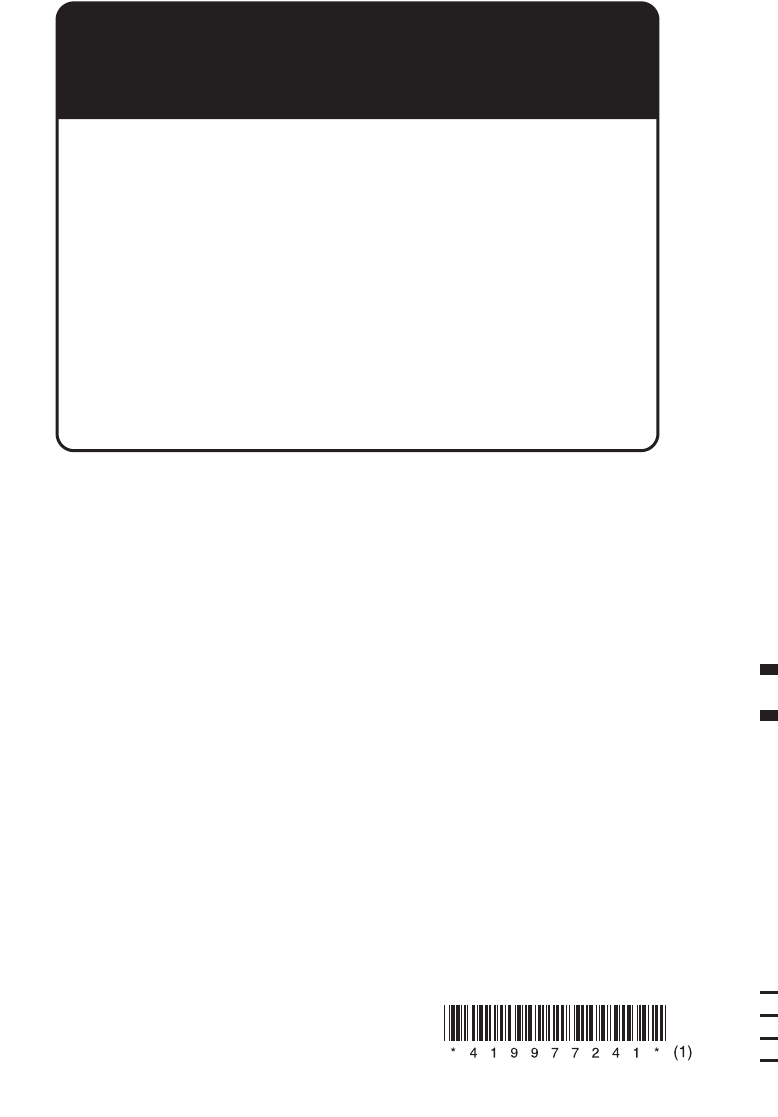
Sony Corporation Printed in Thailand
http://www.sony.net/
If you have any questions/problems
regarding this product, try the following:
1
Read Troubleshooting in these
Operating Instructions.
2
Reset the unit.
Note: Stored data may be erased.
3
Please contact (U.S.A. only);
Call
1-800-222-7669
URL
http://www.SONY.com